A Blog About Life & Travel in France

11 Incredible Alsace Tours in 2024 (A Local’s Guide)
- By Jen Ciesielski
- Updated: 18 April 2024
- 18 May 2023
Looking for the best Alsace tours?
As a local living in the beautiful Alsace region of France, I’ve traveled extensively in the area. From Colmar to Mulhouse, Strasbourg to Kaysersberg, there isn’t a town I haven’t been to. And I can confidently say that there is so much to discover here.
But getting around can be tricky! Taking a tour, where all the logistics are taken care of for you, is hassle-free, convenient, and easy.
Plus, if you only have a day in the region, you’ll want to visit as much of it as you can!
So, to help you to maximize your precious vacation time, I’ve put together the best tours of Alsace.

Please note : This post contains affiliate links, meaning I may earn a commission if you make a purchase by clicking on a link (at no extra cost to you). Privacy Policy .
My Top Picks

Alsace Colmar, Medieval Villages & Castle Small Group Day Trip from Strasbourg
✓ Visit Colmar, Eguisheim, and Riquewihr ✓ Château du Haut-Koenigsbourg Tour ✓ 5/5 Star Rating

Alsace 4 Wonders Small-Group Day Trip from Colmar
✓ Visit Eguisheim, Kaysersberg, Ribeauvillé, and Riquewihr ✓ Wine Tasting Included ✓ 5/5 Star Rating

Alsace Wine Route Wineries & Tasting Small Group Guided Tour from Strasbourg
✓ Visit Dedicated Wine-Growing Villages ✓ Tour Ribeauvillé and Riquewihr ✓ Wine Tasting Included
Best Alsace Tours from Strasbourg
Strasbourg is a great place to start a tour. It’s the transportation hub of the region so you’ll have no trouble getting there, even if you’re coming from Paris .
There are also a variety of tours available including; historical and cultural excursions as well as wine tastings. But the ones listed here are for travelers who want to start from Strasbourg and visit several villages in one day.
Here are the best Alsace tours from Strasbourg:
1. Alsace Colmar, Medieval Villages & Castle Small Group Day Trip from Strasbourg
✰Rating: 5/5 | Duration: 9 hours
On this Medieval Villages and Castle Day Trip from Strasbourg , you’ll travel on winding roads through vineyards and uncover all the beauty and culture that Alsace has to offer.
It’s the perfect mix of history and culture. And as a bonus, you’ll get to see Alsace’s stunning countryside.
Your visit will start with the captivating towns of Colmar and Eguisheim. And this is where you’ll get to see my two favorite streets in the region – Quai de la Poissonnerie (Colmar) and Rue de Rampart (Equisheim).
Then you’ll venture to the enchanting village of Riquewihr. And, from the moment you step through the walls of this fortified city, you’ll see why it was named the prettiest village in France.
Of course, no trip to Alsace is complete without visiting the Château du Haut-Koenigsbourg. From its terrace, you’ll have some of the most magnificent views over the Vosges mountains.
Had a wonderful time with our guide, Damien, who did a great job introducing the region to us in an entertaining way. And we never felt like we were being rushed from one place to another. Michelle H. ( Read More Reviews )
Important Information :
- Transport in a climate-controlled minivan.
- Free WiFi on board.
- Pets are not allowed.
- Not wheelchair accessible.
- Offered in English.
Check Prices and Availability ➔
2. Alsace Wine Route Wineries & Tasting Small Group Guided Tour from Strasbourg
✰Rating: 5/5 | Duration: 8 hours
Discover the stunning Alsatian wine region on this unforgettable Wine Tasting Day Trip from Strasbourg .
You’ll travel along the 170-kilometer (106-mile) Alsace Wine Route, passing vineyards, villages, and castles.
Your first stop is Mittelbergheim, which is one of my favorite towns in the region . The houses here are made of a pink-ivory sandstone that you won’t see elsewhere.
Then, you’ll head to Dambach-la-Ville, the oldest wine-growing town in Alsace. Not only that but the panoramic views of the vineyards here are second to none.
And last but not least, you’ll visit Ribeauvillé and Riquewihr. The colorful half-timbered houses here are the most vibrant in the region.
The highlight of the tour is, of course, the wine tasting. You’ll get to sample a selection of Rieslings, Pinot Blancs, Gewürztraminers, and Pinot Gris from top wineries. This is, undoubtedly, the best Alsace wine tour from Strasbourg on this list!
We visited two vineyards and a winery. We went to lunch at an excellent restaurant. Our guide, Laurent, was very kind and attentive. Jorge R. ( Read More Reviews )
- Free WiFi access on board.
3. Alsace Christmas Markets Day Tour from Strasbourg

✰Rating: 4.5/5 | Duration: 7 hours
Embark on a magical journey with this Alsace Christmas Markets Day Tour from Strasbourg .
During December, the region undergoes a complete transformation. Festive wooden chalets selling locally produced goods are placed in town centers. And the smell of French mulled wine fills the air. It’s a fairytale-like winter wonderland that is nothing short of spectacular.
On this tour, you’ll visit Colmar, Kaysersberg, and Bergheim with an expert guide.
And with such a small group (no more than eight people), you’ll be able to enjoy the charming atmosphere in an intimate setting.
Christmas Market tours sell out early in the season, so I recommend booking as soon as possible.
Useful Tip : The Christmas Markets in Riquewihr and Ribeauvillé open in mid-December. So, if you take this tour when they are open, one or both will be added to your trip.
I had a great time! We went to Riquewihr and Colmar. I LOVED Riquewihr. The town was so cute, and they had one merchant selling “Peter’s best” Glühwein/Vin Chaud. Carlise W. ( Read More Reviews )
- Transport in a climate-controlled vehicle.
- Free Wi-Fi access on board.
4. From Strasbourg: Best of Alsace Historical Day Trip

✰Rating: 4.9/5 | Duration: 10.5 hours
Have you ever wanted to explore the beautiful region of Alsace without having to worry about navigating and planning every stop? Well, look no further with this Alsace Historical Day Trip from Strasbourg .
Your day starts with a tour of the Haut-Koenigsbourg Castle. And, of the castles I’ve been to in Alsace, this one is the best. The views over the region and its history are both incredible.
Then, you’ll explore the cobblestone streets and half-timbered houses in Kaysersberg and Riquewihr. Both of which have won the title of France’s most beautiful village.
Your journey will conclude in one of Colmar’s top sights , the ever-impressive historical center.
If you’re looking for history and culture wrapped into a perfect day trip, then this tour is for you. But spots fill up fast, so make sure to book in advance!
Amazing, jam-packed full day tour to 1 chateau castle and 3 village towns. Transportation van was comfy with good multilingual audio headphones, free bottled water, nice slow easy going paced travel with a small group = less than 16. Anonymous ( Read More Reviews )
- Transport in a climate-controlled bus.
- Offered in Spanish, English, French, and Portuguese.
- Audio guides are offered in Spanish, Chinese, English, French, German, Hebrew, Japanese, Arabic, Korean, Portuguese, and Russian.
5. From Strasbourg: Medieval Villages & Wine Tasting Day Trip

✰Rating: 4.7/5 | Duration: 10.5 hours
Take a journey through time on this Medieval Villages & Wine Tasting Day Trip from Strasbourg .
You’ll visit six towns including, Bergheim, Hunawihr, Ribeauvillé, Riquewihr, Kaysersberg, and Eguisheim. All of which are beautiful in their own way.
And as you travel along, you’ll learn about centuries-old traditions and experience the local culture.
The wine tastings are expert-led so you’ll be getting an exclusive experience.
If you’re looking to combine history and culture in one tour, this is for you!
Loved this! Exceeded my expectations of the historical Alsace villages. It felt like we went back in time and walked down the cobblestone streets. I can see why Beauty and the Beast was inspired by these villages! Anonymous ( Read More Reviews )
- Non-alcoholic beverages are available.
- Free Wi-Fi on board.
- Offered in English and French.
- Audio Guides in Spanish, Chinese, English, French, German, Hebrew, Japanese, Arabic, Korean, Portuguese, and Russian.
- Headsets are provided for the audio guide.
6. Alsace Half-Day Wine Tour from Strasbourg

✰Rating: 4.8/5 | Duration: 4 hours
Explore the beautiful Alsace region with this Half-Day Wine Tour from Strasbourg . With two winery visits, you’ll learn about seven different types of vintages as well as how they’re made. Then, you’ll sample two exquisite selections.
And that’s not all!
You’ll explore the winding streets of Obernai with an expert guide.
This unforgettable tour is perfect for anyone who wants a unique, intimate experience that’s only four hours.
Excellent guide who was very friendly and informative. Learnt more than just about the wine, but about the local history. Very easy going and enjoyable experience. Anonymous ( Read More Reviews )
- Transport in comfortable and fully equipped minivans.
Best Alsace Tours from Colmar
Colmar is another great place to start a tour of Alsace. It’s located in the heart of the region and is easily accessible.
The tours listed below are all one-day excursions from Colmar. But they are for travelers who want to see more than one town. Some also go on wine tastings and visit a medieval castle.
Here are the best Alsace tours from Colmar:
7. Alsace 4 Wonders Small-Group Day Trip from Colmar
Alsace is renowned for its scenic vineyards, charming villages, and exquisite wines.
On this exclusive small-group tour from Colmar , you’ll set out to explore the region’s most iconic spots. You’ll follow the Route des Vins d’Alsace, stopping by Eguisheim, Kaysersberg, Ribeauvillé, and Riquewihr.
Each has its own unique architecture, history, and culture. And being able to see all four in one trip is an incredible experience that you won’t soon forget.
As you travel from town to town, you’ll also get to sample famous wines like Gewürztraminer, Pinot Gris, and Pinot Blanc.
So, if you’re looking for a tour that combines Alsace’s rich cultural heritage and natural beauty, then this is for you.
Didier our guide was extremely friendly and service oriented. He provided excellent information about the 4 villages that we visited and even asked us repeatedly about how was the tour so far and if we needed anything else. Nicholas G. ( Read More Reviews )
- Pick up in Colmar.
- Offered in English, German, and French.
8. 1/2 Day on the Wine Route, Visit of 2 Villages + Tasting from Colmar

✰Rating: 5/5 | Duration: 3 hours 45 minutes
Explore the rich cultural heritage of Alsace with this Half-Day Tour on the Alsace Wine Route from Colmar .
This is a small intimate experience with no more than eight participants. So, it’s perfect for anyone who is short on time and doesn’t want to join a massive tour group.
You’ll travel through the picturesque countryside and visit Hunawihr, Riquewihr, and Eguisheim. As you delight in the region’s famed vintages, you’ll meet local winemakers, who I found to be the friendliest people.
It’s an immersive experience that showcases the beauty of Alsace’s history and culture. And, best of all, you’ll be led by an expert guide.
We had an incredible time and would highly recommend this tour to anyone—friends, families, couples. We visited the most beautiful villages and loved learning about this history and culture of Alsace. Jules V. ( Read More Reviews )
- Stroller accessible.
- Service animals are allowed.
- Offered in German, Portuguese, English, French, and Spanish.
9. From Colmar: Alsace Villages Tour and Wine Tasting

✰Rating: 4.9/5 | Duration: 8 hours
Travel through one of France’s most charming regions with this Alsace Villages Tour and Wine Tasting from Colmar .
Your journey starts in Eguisheim. This quaint village is full of some of the most beautiful half-timbered houses I have ever seen. And with its three towering castles in the distance, the setting is nothing short of magical. It might be small, but you’ll find there are tons of things to see in Egusheim .
Then, you’ll make your way to Riquewihr, but not without passing by Turckheim first.
After a delightful lunch in Riquewihr, you’ll head up to the glorious Château du Haut-Koenigsbourg. It dates to the 12th century and has been restored to its former glory. An impressive site to say the least!
This is a small group tour (eight people max.) and there are limited spaces, so book your spot today!
Wow! Great tour and our guide Miriyam was well informed. She explained the entire history of the Alsace region and took us to beautiful villages that made me feel I was a character in a real life fairy tale! Anonymous ( Read More Reviews )
- Transport in a climate-controlled mini-van
- Comfortable walking shoes are recommended.
10. From Colmar: 3 Villages in France, Germany, and Switzerland

Embark on an unforgettable journey that visits villages in France, Germany, and Switzerland .
Your adventure starts in Colmar. From there you’ll head to the storybook streets of Freiburg in Germany. Like Alsace, it’s famed for its unique architecture and old-world charm.
Then, you’ll cross into Switzerland, bound for Basel.
From gorgeous cathedrals to panoramic views of the Rhine River, this little town doesn’t disappoint. My favorite place to take in the beautiful scenery was the Basler Pfalz observation deck .
Your final stop, before heading back to Colmar, is Eguisheim. With its colorful timber-framed houses, it feels like stepping into a scene from Beauty and the Beast.
Needless to say, this is a once-in-a-lifetime experience!
If you want an all-encompassing trip that showcases this fascinating corner of Europe, then this tour is for you! It’s a multi-country experience that you won’t find elsewhere.
This tour exceeded my expectations. The group size was small — only seven of us total, including myself and my husband. This allowed us to set our own pace and sort of “vote” on what we wanted to prioritize or do. Anonymous ( Read More Reviews )
- Pickup and drop-off at your hotel or your address in Colmar.
11. Through Alsace Vineyards and Wine Villages Private Bike Tour

✰Rating: 5/5 | Duration: 2-3 hours
Embark on an unforgettable journey with this Alsace Vineyards and Wine Villages Private Bike Tour .
If you’re looking to get off the beaten path and bike a section of the Alsace Wine Route, this tour is for you. In fact, it’s one of the most unique tours on this list!
Your journey will begin near Colmar, where you’ll be greeted by your expert guide. Bikes and helmets are included so you’re safe and secure throughout the trip. E-bikes are also available if you prefer.
You’ll ride through Eguisheim and Gueberschwihr, admiring the lush vineyards along the way.
Your tour finishes in Voegtlinshoffen, where you’ll enjoy a full wine tasting from an experienced sommelier.
And since this is a private tour, you can guarantee that everything is tailored to your interests.
Such a fun and informative bike tour. It was the highlight of our entire trip to France. We enjoyed the views of the vineyard and biking through the towns really gave us a much more in depth look at the region. Maria P. ( Read More Reviews )
- Fully equipped bicycles (or e-bike) and helmets are provided.
- Bottled water and snacks are also provided.
FAQs About Tours of Alsace
What is the best month to visit alsace.
The best months to visit Alsace are April, May, June, and September. During these months the temperatures are mild and sunny days are plentiful. There are few tourists so you can explore without the crowds.
How many days do you need in Alsace France?
Two or three days is enough to explore the region’s main attractions. If you would like a more in-depth experience, it’s recommended to spend at least four or five days here.
What is the most picturesque village in Alsace?
The most picturesque village in Alsace is Eguisheim. It’s home to winding cobbled paths, half-timbered houses, and three medieval castles. With its many charms this quaint village is definitely worth a visit!
What is special about Alsace?
Alsace is special because it has a unique culture and history, with influences from both France and Germany. It also boasts beautiful scenery, charming villages, excellent wine, and rich culinary traditions.
What is the biggest town in Alsace?
The biggest town in Alsace is Strasbourg. And it’s known for its traditional half-timbered houses as well as its historical landmarks. The most iconic being the Cathédrale Notre-Dame-de-Strasbourg.
Alsace is one of the most incredible regions in France. And, if you only have a day in the area, the best way to visit all it has to offer is to take a tour. Whether you’re looking for a wine tasting or want to bike a section of the Alsace Wine Route, there are a ton of options.
My number one recommendation is the Alsace Colmar, Medieval Villages and Castle Small Group Day Trip from Strasbourg . You’ll get to see the most charming towns in the region and visit the most grandiose castle. It will be an experience that you won’t soon forget!
Read More Articles About France
I hope you enjoyed my post and found it useful. Here are some other articles that I think you might find interesting.
- Is Colmar Worth Visiting? 19 Reasons Why You Should!
- Colmar to Eguisheim: How to Get There & Best Travel Options
- The Ultimate 10-Day Eastern France Itinerary
- 13 Best Strasbourg Walking Tours (Local’s Guide)
Jen Ciesielski
Jen Ciesielski is the creator of Dabbling in Jet Lag. She has lived abroad for over ten years, traveled to more than 50 countries, and speaks French and English fluently. Her areas of expertise include moving abroad, learning languages, and travel planning. Originally from the United States, she now lives in France, where she has been for more than six years. She has also traveled extensively around the country. She shares her experiences as an expat living in France and helps thousands of people plan their trips every month.
- Trip Advisor

Riquewihr lovely town M.Schampion - CDT Alsace
Self-drive Alsace Tours
Self-guided tours in alsace.
On the border with Germany lies the Alsace region, along the Rhine river and stretching from Strasbourg to Colmar.
Our Alsace tours has everything a wanderer will like: so many colorful half-timbered towns built along a scenic vineyards route . Always in the background, the Vosges mountains add to the picturesque scenery and you can reach the foothills in less than 30 minutes to have unlimited walking and hiking options.
Munster and its cheese will give foreign travelers a real introduction to uncompromisingly tasty French cheeses , while the local pizza called Flammekueche as well as the famous Choucroute will get everyone to agree - food in Alsace is delicious!
A fantastic well-planned self-drive tour We had the most amazing time on our 6 week self-drive tour designed by Laura, travelling through Brittany, Loire, Dordogne, Medoc, Basque …
A fantastic well-planned self-drive tour We had the most amazing time on our 6 week self-drive tour designed by Laura, travelling through Brittany, Loire, Dordogne, Medoc, Basque France, Languedoc, Provence, the Alps, Alsace and Champagne. This was a big trip for us and it was everything I’d hoped and dreamed and even more besides. All our accommodation was delightful - all different and all with unique character and a personal touch. All our hosts and guides were fantastic and we so enjoyed our time with them. Everything was so meticulously planned, so well-organised, and presented clearly with a wealth of information and practical tips for suggested activities each day to make to most of our stay in each region. Restaurant recommendations were particularly helpful. The FJFY app is outstanding! We very much hope to travel with FJFY again. Thank you for all your hard work and attention to detail in making such a wonderful trip for us.
Our Self-Guided Tours in Alsace
Discover our self-drive itineraries which will take you through Alsace lovely towns and typical vineyards.
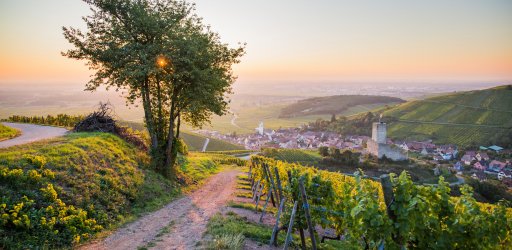
Katzenthal vineyards Tristan Vuano - ADT Alsace
Focus on the Northeastern France
On this itinerary, you'll go North-East ! Burgundy, Alsace and Champagne are all located East of Paris and near the Swiss and German borders. Quite unknown, these regions have a lot to discover !

Hunawihr town in fall Tristan Vuano - ADT Alsace
The Best of Eastern France
This itinerary takes you to Eastern France from North to South. After spending a few days in Paris, you will enjoy the Alsace region on the German border and then drive your way south all the way to Provence. The best itinerary to discover l'Est de la France !

Obernai in Alsace Lez Broz - Visit Alsace
Northern France from Paris to Alsace
In 13 days, this tour will take you from Paris to the Somme region, and on to Lille at the Belgium border. You will then drive your way south-east to the Verdun area and the surrounding WWI sites. You will end your journey in Alsace, on the border with Germany. A great way to discover Northern France !

Royal Fortress in Chinon Jean-Christophe Coutand - ADT Touraine
The Very Best of Northern France
From East to West, discover the Northern half of France at your own pace. Visit Alsace, Burgundy, the Loire Valley, and Normandy, ending your wonderful adventure in Paris.
How to Get to Alsace
- If you are driving, Burgundy is a 2hr45 drive south from Alsace, the Verdun region is a bit less than 3hrs west. We do not recommend driving directly from Paris or CDG Airport to Alsace, as it is about a 5hr drive on the highway.
- If you plan on reaching Alsace via train and then rent a car, you need to plan for Strasbourg, which is the main city of Alsace. From Paris Gare de l’Est station, you can catch a direct TGV high speed train and in 1hr45, you will arrive in Strasbourg.
- The train is the best way to get to Alsace if you don’t plan to stop over in Reims for Champagne or in Verdun for the World War I sites on the way.
Where to Stay in Alsace
- Most of the sightseeing in Alsace lies between Strasbourg in the North and Colmar in the South. The 2 cities are 45 miles (73 kilometers) apart and the drive is about 1hr drive.
- Parallel to this North-South road you will find the famous Alsace Wine Route with all the gorgeous typical little towns on the foothills of the Vosges mountains. It is easy to enjoy wine tours from Colmar, if you're interested in wine-tasting.
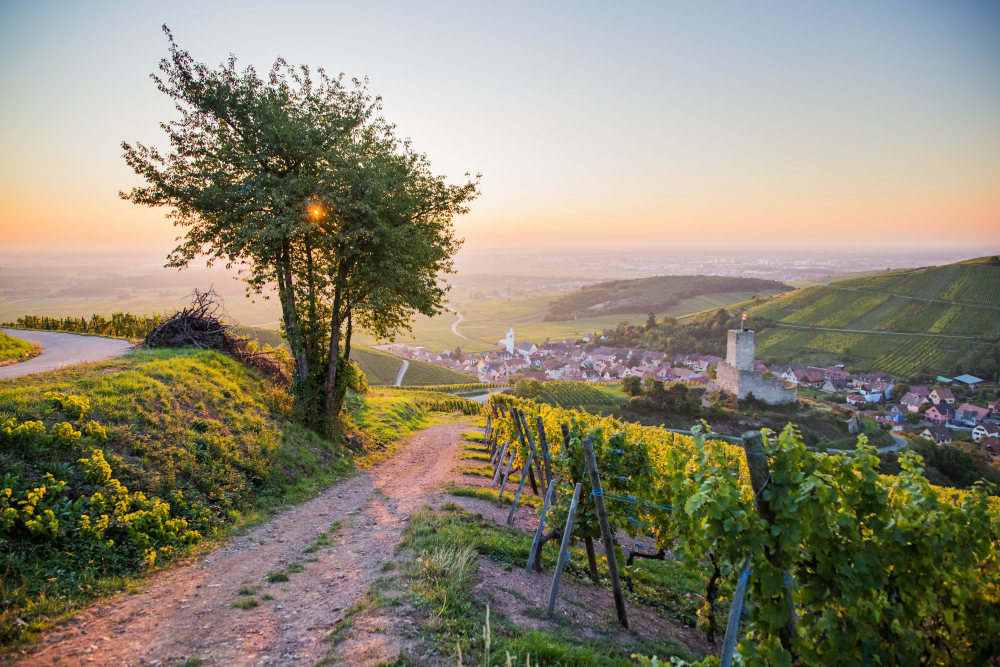
Katzenthal vineyards - ©Tristan Vuano - CDT Alsace
- For our self-drive tours in Alsace we have selected premium Bed & Breakfasts on the Colmar–Strasbourg axis, perfectly located to enjoy the Alsace region driving.
Alsace Christmas Markets
Alsace Christmas markets make this French region very special. Nowhere else in the world will you enjoy such a charming, very special Christmas ambiance than strolling Colmar, Eguisheim or Riquewhir in Christmas market season.
You will enjoy tasting fresh pretzels with hot mulled wine while walking around, or you may sit in a traditional winstub to taste sauerkraut or braised ham. For beer or wine lovers, Alsace has a lot to keep you busy !
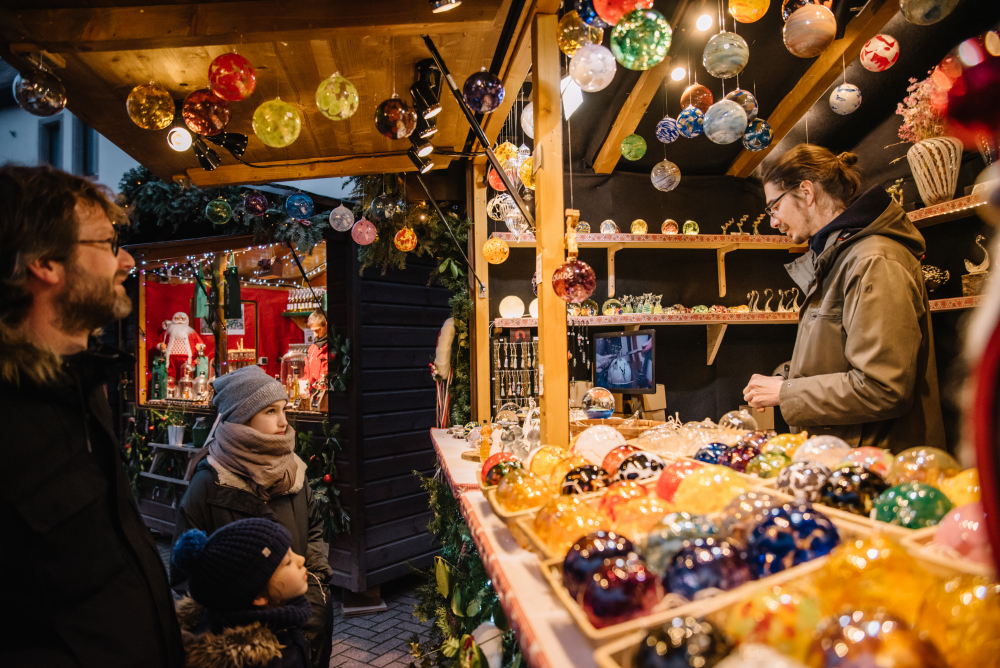
Alsace Christmas Markets - © Lois Moreno - CDT Alsace
Maybe what we enjoy the most about Alsace Christmas markets are the nice decorations all over the places : on the streets, in the windows of all the homes . . . everywhere you look! And if you get lucky with a bit of snow, it is magical!
Now, visiting Alsace Christmas markets requires some logistics and you need to be an early bird for reserving. While the Christmas market season starts in late November and ends on the first days of January, most accommodations are fully booked a year ahead. Thus, based on this, please plan ahead and do not hesitate to contact us to plan your Alsace tours asap.
Self-drive wine-tastings Alsace: The Alsace Wine Route by Car
The vineyards of the Alsace wine region are postcard landscapes with the half-timbered towns and the Vosges mountains in the background. It makes a really pleasant drive with gorgeous photo stops. Several of the Alsatian towns are “most beautiful villages of France” and we also recommend exploring less famous, less touristy towns that we have selected for our travelers.
Most Alsace wines are white wines, in the German tradition. Alsace's vineyards are famous for the Sylvaner, Riesling and Gewurztraminer varieties . These are wines that are not produced anywhere else in France. Along the Alsace Wine Route, there are lots of wineries you can just walk into and taste the wines.
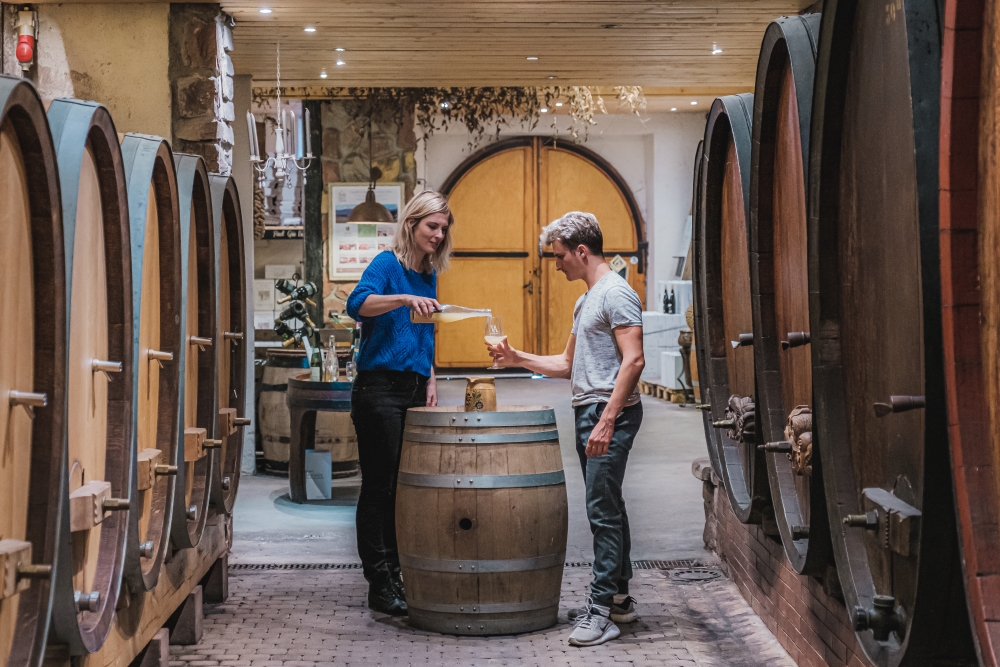
Wine Tasting in Alsace - ©Lez Broz - Visit Alsace
Alsace has long been known for Gewurztraminer wines, especially those known as “vendanges tardives”, meaning late harvested grapes which produce strongly savored wines that are excellent as an aperitif. Tastes tend to change and people now drink wines with less sugar and Alsace also makes some nice dry Pinot Noir or Pinot Gris wines . So every traveler should find a wine they like !
Alsace's Very Special History
Being located along the German border, the Alsace region has had a very eventful history. It was torn between Germany and France many many times in history. So while Alsace is a French region, you can get a real taste of Germany in Alsace through the architecture, the gastronomy, and the traditions.
It makes the region very special and unique. To the west of Rhine river, from Strasbourg to Colmar there are so many wonderful historical, gastronomic, and cultural self drive experiences in Alsace for you to discover!
One great witness of this history is undoubtedly Haut-Koenigsbourg castle, which stands on the top of the hills between Colmar and Strasbourg. There are lots of other medieval castle ruins in this area but Haut Koenigsbourg was rebuilt in the early 20th century by William the 2nd of Germany, so it is “complete”.
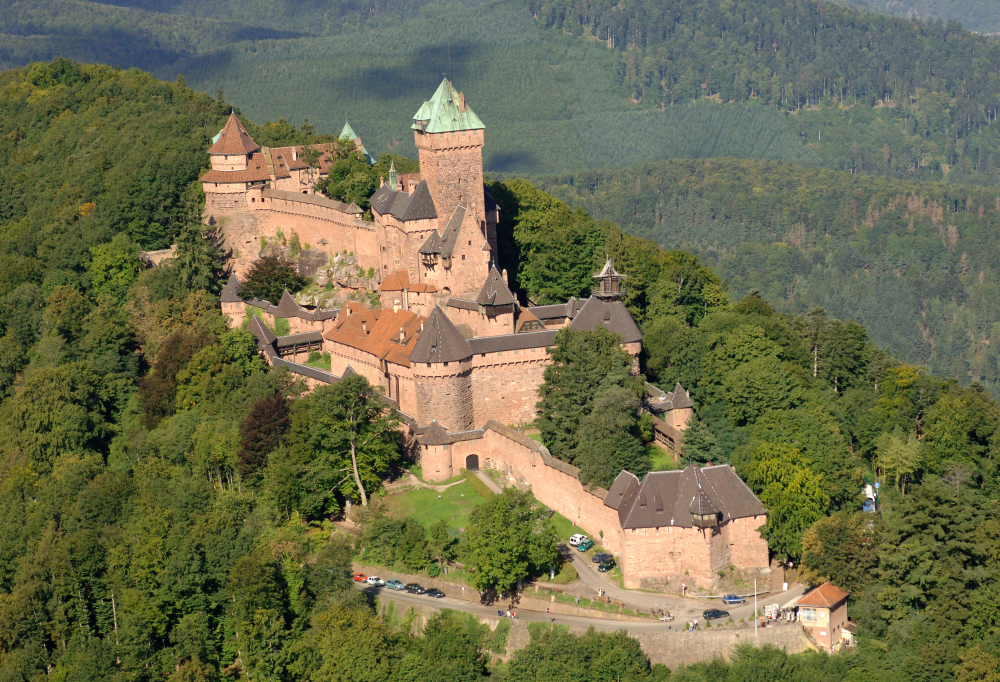
Haut Koenigsbourg Castle - ©JL.Stadler - CDT Alsace
Made in Alsace
- Storks are the symbol of Alsace. While they almost disappeared in the 70's, the repopulation efforts are working and you will see stork nests everywhere. Legend says that if a stork flies above a house, then a baby will come soon. If you want to see the storks, come during the summer season, in winter, they are in Africa.
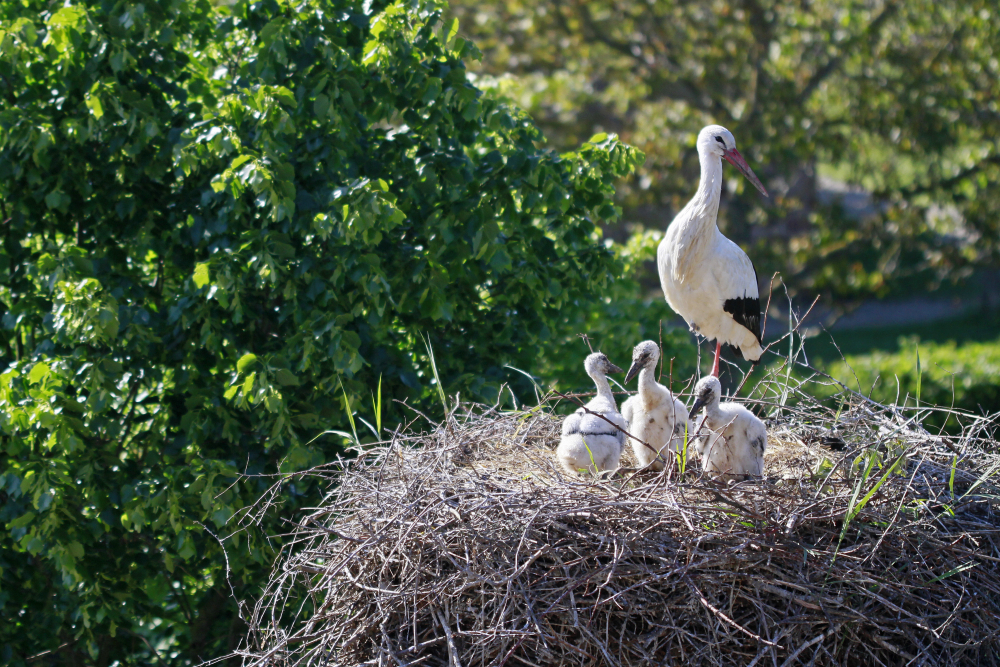
White Stork Nest in Alsace - ©Marc Solari - CDT Alsace
- Pottery is traditional in the Alsace region, with colorful and generous shapes. While Soufflenheim is famous for its clay and potteries, you can find shops selling these all over Alsace. In Kayserberg, a local workshop makes gorgeous pottery decorations for the Christmas tree . . . just saying!
- Alsatian traditional costumes are also part of the culture. They are no longer worn in the streets since the end of WWII but in all the festivals, you will see people with the Alsatian costumes.
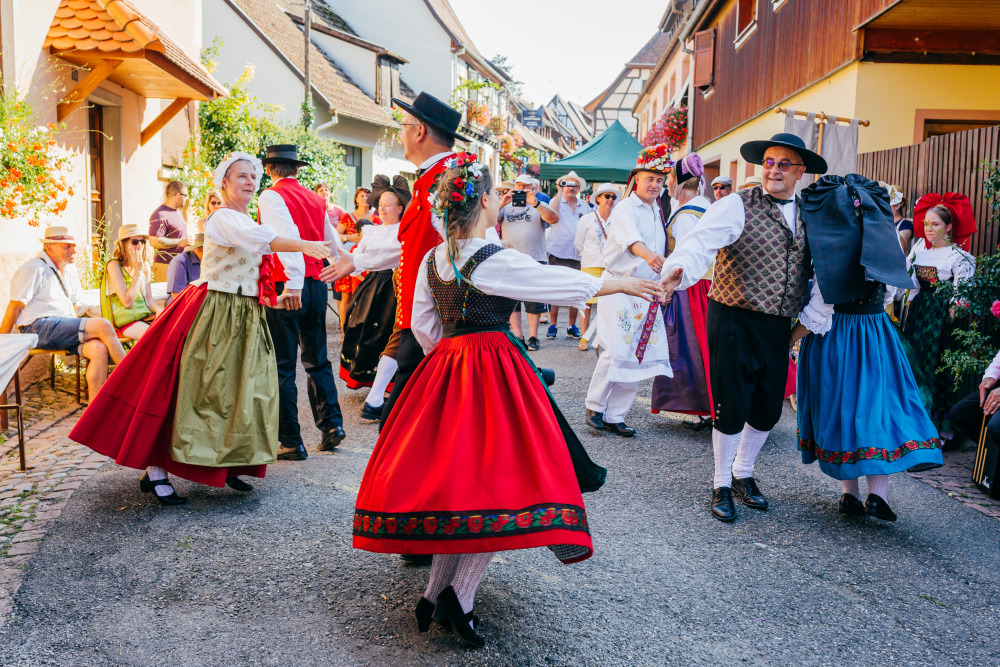
Wine Festival in Eguisheim with traditional costumes - ©V.Muller - Visit Alsace
- Alsatian gastronomy is very rich: you can tell this is a cold region in winter: pork meats, potatoes, cabbage make delicious baeckeoffe, sauerkraut, spaetzles. Apple strudels or cherry bettelmann should definitly be on your list to taste, while the Kougelhopf brioche is a must for breakfast or teatime.
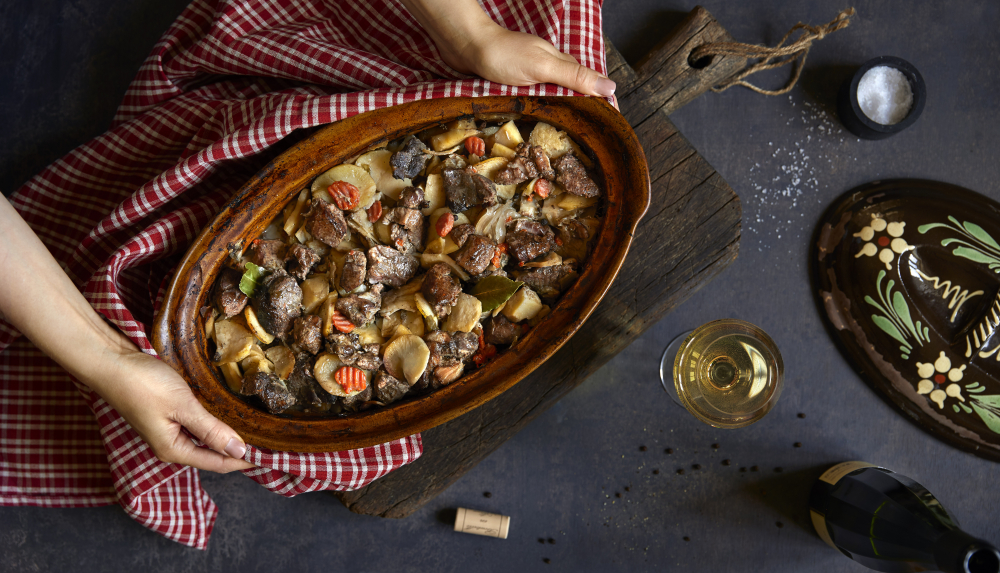
Alsatian Baeckoffe - © Klaudia IGA - Visit Alsace
FAQ about Alsace
Alsace is most famous internationally and in France for its Christmas markets in December! The whole region turns into a fairytale landscape, with Christmas decorations, lights, markets and the aroma of mulled wine wafting through the Alsatian villages and towns.
Alsace also has a fascinating history. It was fought over between France and Germany for centuries, and having belonged to one or the other at different points in history. Now, Alsace is part of France, but if you visit, you will notice the many German influences on the culture, architecture, food and traditions (including the Christmas markets).
The region is also famous for the Alsace Wine Route, with some delicious white wines for you to try.
At the very minimum, we recommend spending 3 days of a self-drive tour in Alsace. This will give you the chance to visit one of the region's main towns - Colmar or Strasbourg; enjoy a day driving along the Alsace wine road, including some stops in beautiful Alsatian villages with colorful half-timbered houses; and visit the gorgeous medieval Haut-Koenigsbourg castle.
Absolutely! It's worth spending at least a day in the beautiful town of Colmar, so you can enjoy a stroll or a boat tour along its canal and enjoy a delicious meal in a typical Winstub with a nice beer or glass of wine. It's true that many Alsace tours include visits to Colmar - but we'll always explain how you can avoid the biggest tourist crowds!
Alsatian gastronomy is known for being rich, and very warming during the winter months. Munster cheese is a tasty and strong-smelling French cheese. Another very cheesy dish is the local pizza called Flammekueche. The famous Choucroute is sauerkraut with sausages and other cured meats and charcuterie, and often potatoes. Baeckeoffe is a typical savoury casserole dish. You'll also find plenty of pretzels, apple strudels and 'Bettelmanns' (an Alsatian cherry casserole) to try. We recommend trying a Kougelhopf brioche for breakfast or tea-time; it is made from the yeast-based dough with added raisins, almonds and sometimes hazelnuts. Yummy!
Blog posts about Alsace
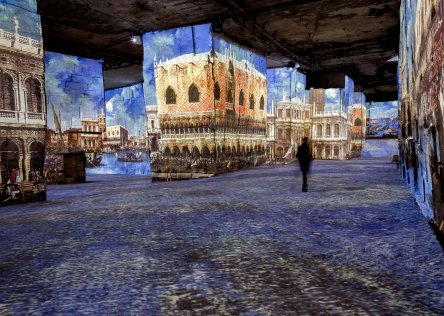
Culturespaces, E. Spiller
Best Museums to Visit in France Outside Paris
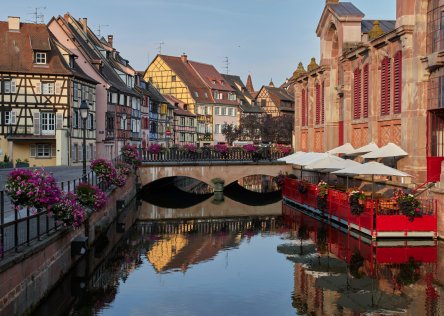
Unsplash CC0
The Best Alsace Christmas Markets
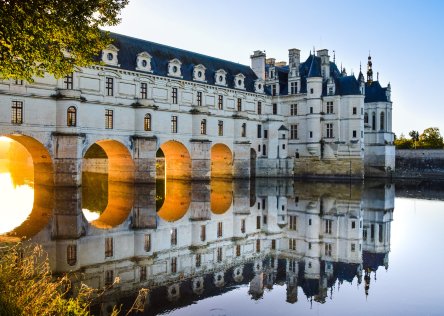
AXP Photography CC0 Unsplash
Best Castles to Visit in France
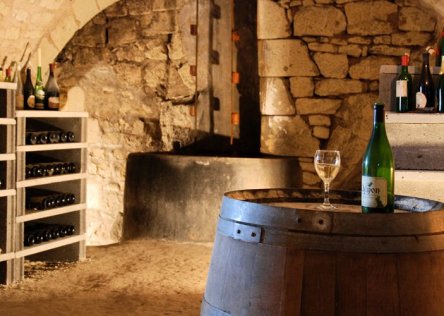
CC0 Vicky Hincks
Wine Tasting 101: Tips for Enjoying and Appreciating French Wines
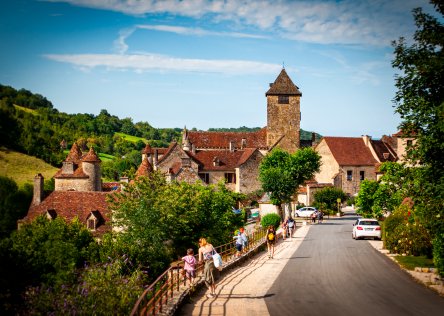
Rodeo Media
Exploring the Charming Villages of the French Countryside
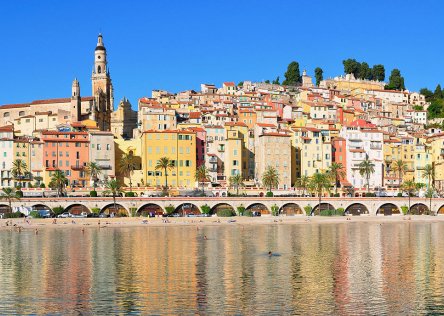
Tobi 87, Wikimedia Commons , CC-BY SA 3.0
Off the Beaten Path: Exploring France's Hidden Gems
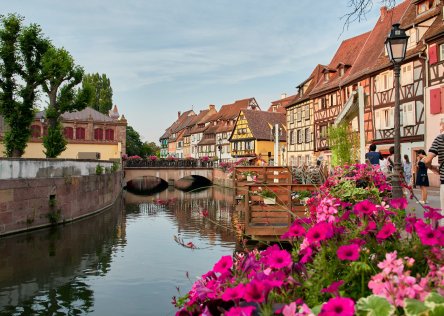
Vered Caspi - CC0 Unsplash
France in May
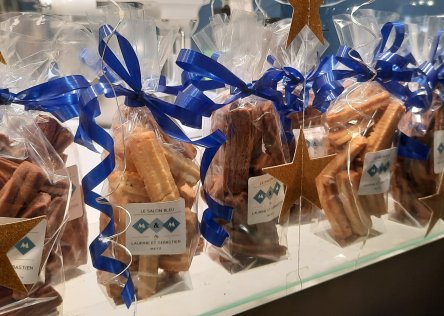
France Just For You
Christmas Spritz
Visit other french regions.
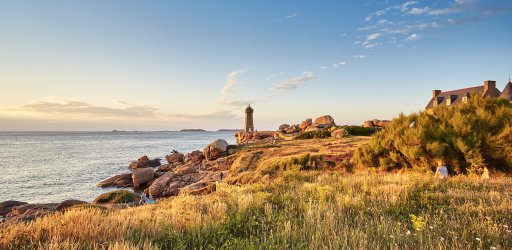
Alexandre Lamoureux - CRT Bretagne
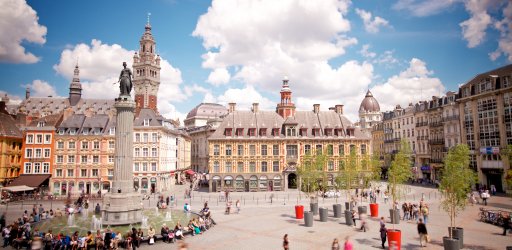
Lille Main Square Laurent Ghesquière - OTCL Lille
Lille & North
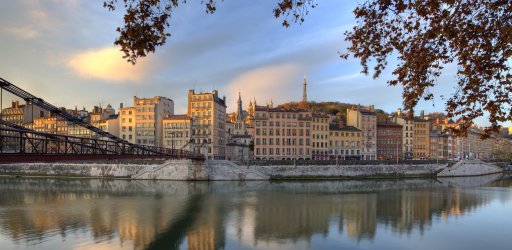
Lyon along the Saône river T.Deschamps - OT Lyon
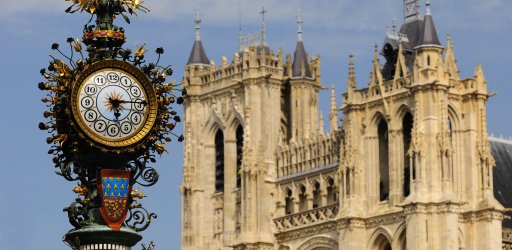
Amiens Cathedral Somme Tourisme - F. Leonardi
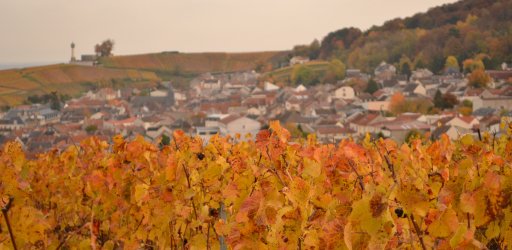
Verzenay Champagne vineyards E.Vidal - ADT Marne
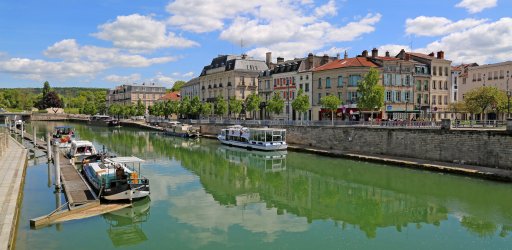
The Meuse river in Verdun Verdun Tourisme
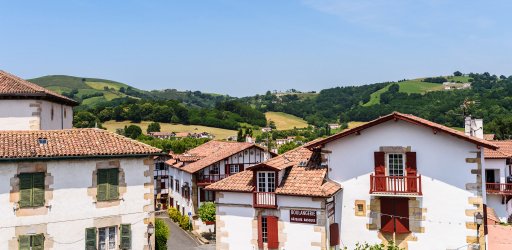
French Basque Country Sceneries CDT Pays Basque
Basque Country
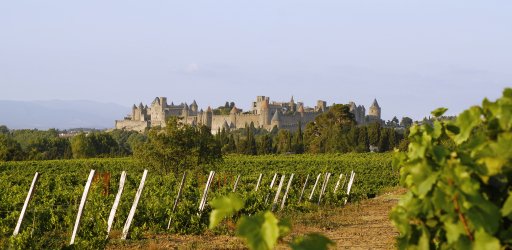
Tours of Carcassonne - fortress ADT Aude
Carcassonne
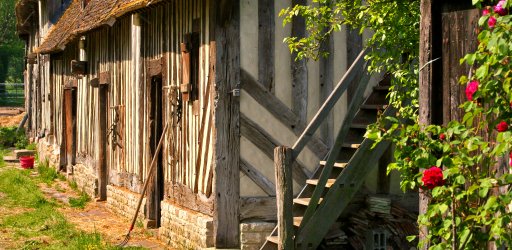
Half Timbered Farms in the Normandy Hinterland - Normandy Tours Calvados Tourisme
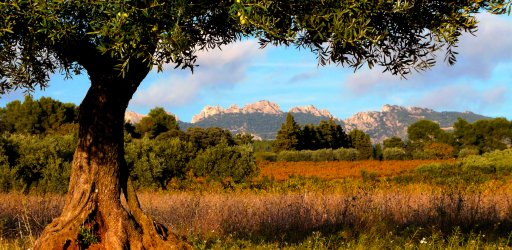
Dentelles - 7 days in Provence - Provence tours Alain Hocquel - CDT Vaucluse
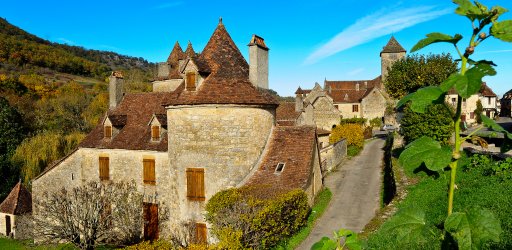
tours of Dordogne region Dordogne Valley
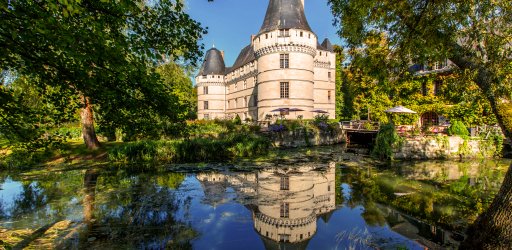
Visit Chateau de l'Islette - Loire Valley driving tours Chateau de l'Islette
Loire Valley
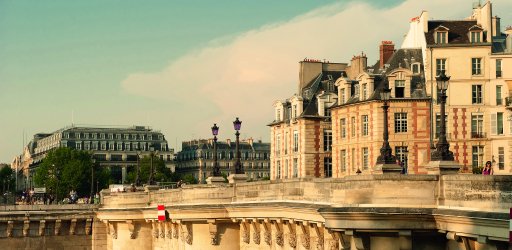
Paris tours Paris Tourism Office - Amélie Dupont
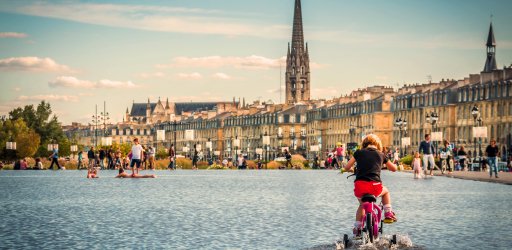
Le Miroir d'eau - self drive tours Bordeaux France - Bordeaux tours Christophe Bouthé - OT Bordeaux
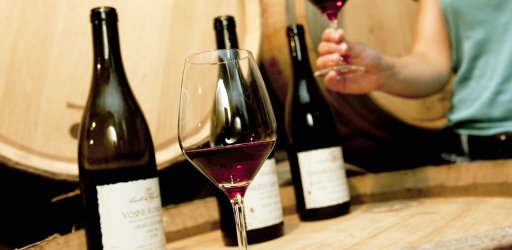
Burgundy wines Alain Doiré
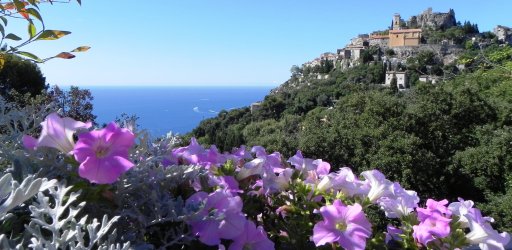
Eze perched village France Just For You
French Riviera
Our travelers’ reviews.
One would think driving in a different country where cars are on the wrong side of the road and you don’t speak the language for 11 day trip would not be a smart decision. France Just for You is definitely the travel consultant you go to. Emilie’s very quick replies to queries, personal knowledge of having been to places recommended and …
One would think driving in a different country where cars are on the wrong side of the road and you don’t speak the language for 11 day trip would not be a smart decision. France Just for You is definitely the travel consultant you go to. Emilie’s very quick replies to queries, personal knowledge of having been to places recommended and organisation skills for minute details, makes them truly reliable.
From getting us a French smartphone complete with the necessary apps to help us navigate and keep us connected , and also providing us with a personalised guidebook that dictates step-by step advice on what to look out for, GPS guide on where to go , where to park, how to use the parking machines/toll machines/even pumping gas (complete with images of where to slot in your cards) , made our travelling around and navigation practically stress-free!
Emilie crafted itineraries which allows my family of four , each with different interests ( from WWII millitary historical sites to a whole new world of Chateaus ,medieval villages ,flower gardens , immersive artworks, sunset and fantastic night sky , to cooking French cuisines) experiences to treasure and remember.
We had a half day guide in Paris, Raphaelle, who is truly knowledgeable about art , history and architecture. We visited Picasso Museum and because the artwork there were not laid out chronologically, Raphaelle made it easily understandable by showing us through her own folder of personal compilations of the Master’s progress of life encounters and artworks (which should be made into a book) that ties in to the art pieces on display, it provided us with so many aha moments.
Merci beaucoup France Just For You!
France Just for You has my highest recommendation. I will never forget our trip to France. Laura was amazing. Perfect itinerary. They did the little things right. Were available throughout the trip. We forgot my 4 year old's blanket at the first hotel. I contacted Laura and she had it waiting for us when we arrived at the hotel airport to leave. I …
France Just for You has my highest recommendation. I will never forget our trip to France. Laura was amazing. Perfect itinerary. They did the little things right. Were available throughout the trip. We forgot my 4 year old's blanket at the first hotel. I contacted Laura and she had it waiting for us when we arrived at the hotel airport to leave. I could go on forever. Allow them to help you with your trip and you will not regret it.
A great team of Professional, Friendly people who really know France ! The team at France Just For you are Fantastic. From the first introductory email to the last farewell, they listened, planned, helped and crafted a brilliant trip around Bordeaux, Medoc and Dordogne. They responded immediately to questions as if we were the only people they had …
A great team of Professional, Friendly people who really know France ! The team at France Just For you are Fantastic. From the first introductory email to the last farewell, they listened, planned, helped and crafted a brilliant trip around Bordeaux, Medoc and Dordogne. They responded immediately to questions as if we were the only people they had to deal with. Their choice of places to stay and things to do were perfect. Faultless. Thank you All so much.
Our Travelers’ Photos
Get our monthly travel news and best tips by subscribing to our newsletter
Hi there 👋 I’m Emilie. Your dream trip?

The convertible bus
Discover Alsace with our guided tours of the Wine Route

An unforgettable experience in the heart of Alsace
Tour.alsace invites you to discover one of France’s most beautiful regions. Each of our tours has been designed to help you make the most of this exceptional day.
From typical, must-see villages, through the Alsatian vineyards, to walks through historic town centres, you’ll be amazed by every surprise. In our comfortable bu s, you’ll enjoy a panoramic view of the countryside, with commentary in your own language.
And if the weather is fine, you’ll even have the pleasure of travelling in the open!
- From €110 per person (€60 child rate)
- Discover our tours departing from Strasbourg & Colmar
- A comfortable, panoramic open-top bus
- Your tour with commentary in your language
Choose the starting point for your tour
From Colmar in the Haut-Rhin (68) or Strasbourg in the Bas-Rhin (67), tour.alsace offers you tours to see and visit the most emblematic places in Alsace . The hardest part is choosing!

Alsace Villages and Christmas Markets Tour
Strasbourg may be the Christmas Capital but almost all the towns and villages in Alsace host their own Christmas Market and some are certainly worth the trip… So soak up the winter wonderland!

Best of Alsace Tour
Do you want to see Alsace’s top attractions? Tour.alsace is your ticket to visit Alsace’s most iconic sites in a single day starting in Strasbourg.

Coeur d’Alsace tour
Departing from the bus drop-off point at Parc de l’Étoile in Strasbourg, this tour will take you to discover some extraordinary heritage, with the added bonus of a visit to Mont Sainte-Odile and lunch in the sublime city of Obernai.
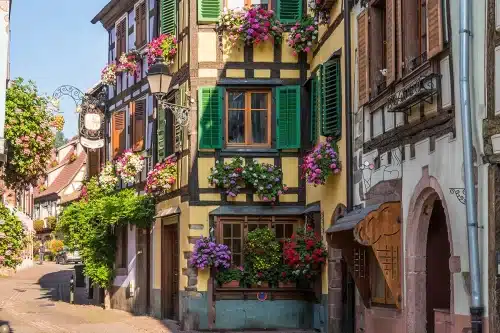
Medieval Alsace Tour
Explore the stunning region of Alsace on our one-day excursion. Immerse yourself in the charm and history of this area. Discover enchanting villages, savor the fine wines of the region, and explore a majestic medieval castle. An unforgettable experience in Alsace.

Perles du Vignoble tour
Haut-Rhin is full of little medieval villages where every stone tells a story. This one-day tour will allow you to unlock the secrets of these villages, among the most beautiful in France, and enjoy a wine tasting at a local winemaker.
Check availability of our tours
Book the bus for your events.
Our chauffeur-driven Cabriolet Bus just for you? It's possible! Think about it for all your events (weddings, birthdays, family celebrations...)

They talk about their experience tour.alsace
- In japanese
- In portuguese
Foram paradas deliciosas para experimentar o melhor da comida e vinhos da Alsácia. Excelente passeio pelas Aldeias da Alsácia com muito conforto e total atenção do Guia Martin! A veículo microônibus é excelente com sistema de áudio Guide em 12 línguas.
Merci Henri pour le tour d'Alsace qu'on a pu effectuer hier grâce à vous. C'est un très beau tour et si bien organisé. Nous le recommandons à ceux qui ne connaissent pas l'Alsace, au depart du Strasbourg. Nous avons admiré votre gentillesse et votre professionalisme.
We loved our Best of Alsace tour with Tour Alsace. The bus was very comfortable and immaculately clean, the driver, Martin, welcoming and very helpful. The itinerary hit all the high notes. It was a very pleasant, informative, fun and an enjoyable trip, for us adults and a 10 year old. I was very impressed with the company's responsiveness. 100% recommend and would definitely book again.
Consiglio questo tour che è davvero fantastico. La nostra guida Martin è stata puntualissima in tutte le tappe e ci ha fornito tutte le informazioni di cui avevamo bisogno. Le audioguide ci hanno permesso di approfondire la storia delle diverse cittadine che abbiamo visitato. La durata di ogni sosta è stata sufficiente per la visita.
フランス国鉄のストで、移動が出来なくなったため申し込みました。結論としてはこちらのツアーに参加して正解でした。コルマールでは3時間、他でも十分な時間がとれ、効率的にアルザスの街を回ることが出来ました
O passeio é excepcional e o profissional responsável pelo passeio foi super gentil. Um verdadeiro cavalheiro, cuidando para que todos realmente desfrutassem do passeio. Super recomendo!
Worth every penny of the ticket price and every minute of the ten hour
Ça vaut vraiment la peine de prendre une journée pour le faire! Vous obtenez un aperçu complet de toute la région Alsace, passez un bon moment dans chaque ville et obtenez un historique des villes que vous traversez. Le chauffeur était sympathique et vraiment adorable! Ne vous inquiétez pas pour toute autre tournée. Cela vous donnera tout ce dont vous avez besoin pour en savoir plus sur la région et voir chaque ville.
Une excellente façon de découvrir le charme très pittoresque des villages et des vignobles alsaciens. Nous avons apprécié le rythme des visites qui se font tranquillement. Notre crainte était de devoir les enchaîner "au pas de course" mais ce n'a pas été le cas. Chauffeur agréable, sympathique et attentionné. Nous conseillerons cette formule à tous nos amis.
Très bien chauffeur très professionnel toujours à l'écoute et il fait tout son possible pour satisfaire sa clientèle
Excellent! Notre chauffeur, Martin, est très gentil . Je recommande fortement ce tour . Les villages sont très beaux. Le mini bus avec son toit ouvrant est parfait. Nous traversons plusieurs villages et effectuons 3 arrêts de 1 à 2 heures.
Excursión maravillosa y un anfitrión, Martin, de diez, lo recomiendo
Muy buena la excursión. El chofer encantador y muy profesional.
Der Aufenthalt auf der Burg hätte etwas kürzer sein können, sonst war alles super!
Alsacia llena de historia, pueblos preciosos que vale , la pena visitar y verse envuelto en sus encantos y tradiciones
Honestly it is a well organized trip, with an amazing guide “Martin”, he is nice, attentive and giving clear instructions. The time given for each stop is sufficient. It is enjoyable tour in a comfortable couch and recommended way to visit the magical small villages of the Alsace.
Conducteur aux petits soins pour ses passagers avec une conduite toute en douceur. Véhicule décapotable très apprécié notamment pour les photos Site château remarquable avec le temps nécessaire laissé pour la visite guidée. Visite recommandée !
Week end illuminé sur les marchés de noël alsacien : sous avons pris 3 jours en semaine pour visiter ces 3 marchés de noël et nous avons fait un très bon séjour entre dégustation, coutumes locales et bonne ambiance générale. Le soir les illuminations sont très jolies et avec beaucoup de charme. Nous nous sommes régalés dans tout les sens du terme. ?
Superbe !!!! Ce sont de petites villes sublimes, un coup de cœur pour moi pour Riquewihr, on se croirait dans un décor de cinéma !!!!
I very much enjoyed this well organised tour. Communications before were superb, and the van was comfortable, with a nice itinerary planned. I would have liked another 30 min in Eguisheim, but that’s life. The driver kindly dropped me off at the train station, where other participants also needed to be. Great tour!
The small van we travelled in was great; the roof slides back to allow passengers to take pictures unobstructed by window glare. Our bus driver was also our guide, in the sense that he dropped us at entrances to markets and told us where to return. The “tour” is a recording via headset. We drove through two beautiful medieval villages in the Alsace wine country - no stops were necessary - and we heard the history of the towns.
El tour es soñado,excelente, el vehículo con techo de cristal , alucinante y los dos caballeros muy amables y expeditivos, muy recomendable, volvería a hacerlo .
Vale la pena la excursión, los pueblos son preciosos pero estan llenissimos de coches. El chofer del bus te deja en la entrada y tienes 1/2/3 horas para ver los pueblos!
La verdad es que mereció mucho la pena. Además de los 3 pueblos en los que hace parada, vimos varios más desde el autobús. Nuestro conductor Martín, fue encantador. Sin duda muy recomendable.
Todo bien excepto los folletos que nos facilitaron con la información de los sitios a visitar que no estaban en español, solo en francés e inglés , cuando el tour lo anunciaban en español
Le Bus Cabriolet, c’est vraiment un moyen génial pour visiter l’Alsace en bénéficiant d’une vue panoramique sur le paysage. Pas besoin de GPS, ni de chercher un parking : on prend le temps de découvrir la région et grâce aux commentaires, on apprend une foule de choses. Sans oublier les plaisirs de la gastronomie alsacienne… À refaire très vite, en famille ou entre amis !
Bus très agréable et très propre : les sièges sont hyper confortables, on se sent bien à bord. Les visites sont commentées en plusieurs langues, ce qui est un plus incontestable. Nous avons aimé la facilité de réservation en ligne, la qualité du parcours proposé, la variété des activités.
#sightseeingtouralsace on instagram
New cabriolet bus. #sightseeing #alsacesightseeingtour #visitalsace #mercedes #sprinter #visitfrance #visiteurope #ribeauvillé #riquewihr #strasbourg #colmar

Christmas market in Riquewhir. #riquewihr #alsace #christmasmarket #france #europe #december #tourism #sightseeing
Fall colours! Photo by Susan Goodwin. #fall #kaysersberg #sightseeingtour #sightseeingtouralsace #voyage #tourism #experience #alsace #vineyard #rhinevalley #beautifuldestinations #discoverunder5k
The Holy Cross church of Kaysersberg. Photo by Susan Goodwin. #kaysersberg #fall #disvover #visitfrance #visitalsace #sightseeing #church #medieval #tourism #alsace
Pick up and drop off at one of Europa Park’s hotel. #sightseeing #hotel #luxurytravel #europapark #alsace #luxurytransfer
The Haut-Koenigsbourg castel completely restored in the late 19th century. #castle #alsace #sightseeing #discoverearth #middleages #medieval #visiteurope

- Privacy Overview
- Strictly Necessary Cookies
- 3rd Party Cookies
- Privacy policy
This website uses cookies so that we can provide you with the best user experience possible. Cookie information is stored in your browser and performs functions such as recognising you when you return to our website and helping our team to understand which sections of the website you find most interesting and useful.
Strictly Necessary Cookie should be enabled at all times so that we can save your preferences for cookie settings.
If you disable this cookie, we will not be able to save your preferences. This means that every time you visit this website you will need to enable or disable cookies again.
This website uses Google Analytics to collect anonymous information such as the number of visitors to the site, and the most popular pages.
Keeping this cookie enabled helps us to improve our website.
Please enable Strictly Necessary Cookies first so that we can save your preferences!
More information about our Cookie Policy
APRIL SALE: Book now and get up to 60% off!
Alsace & Lorraine Tours & Trips
Find adventures through Alsace and Lorraine. Ride past gorgeous vineyards on your bike to discover picturesque villages, marvel at Renaissance house facades and stunning views over the Rhine River. Taste authentic French wine and cheese in the mountains then visit historic sites in Strasbourg, Colmar, Largarde and many more.
72 Alsace & Lorraine tour packages with 35 reviews
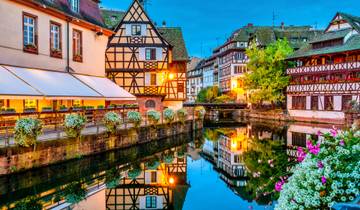
- Walking Adventure
- Coach / Bus
- Sightseeing
Charms of Burgundy and Alsace
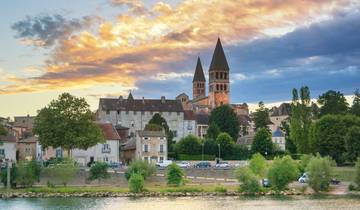
Spain, south of France, Burgundy and Alsace
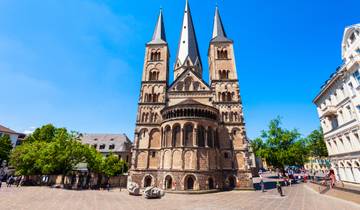
Alsace on E-bikes guided cycling tour
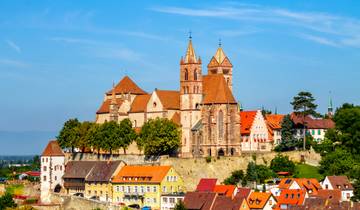
- River Cruise
From the Heart of Alsace to Summits in the Swiss Alps (port-to-port cruise)
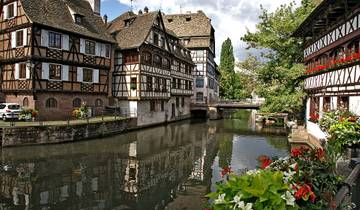
The Marne-Rhine Canal - From Lagarde to Strasbourg (port-to-port cruise)
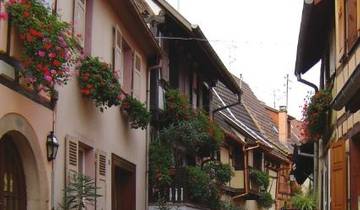
- Self Guided Walking Holidays
- Self-Guided Cycling
Alsace Mountains & Vineyards
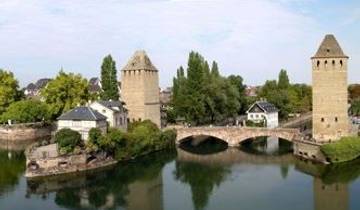
Bicycling the Vineyards of Alsace
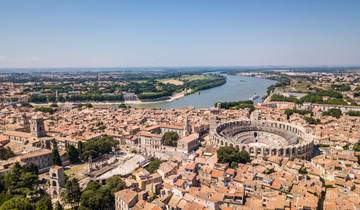
Dreaming of France of Alsace
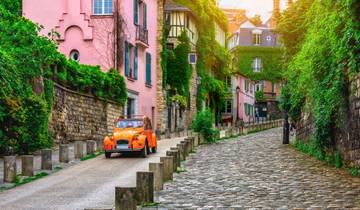
Burgundy, Alsace and Black Forest End Paris
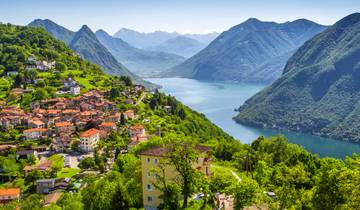
France and Switzerland with enchanted Alsace
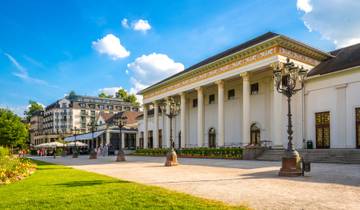
Cote d Azur, Burgundy, Alsace and Black Forest
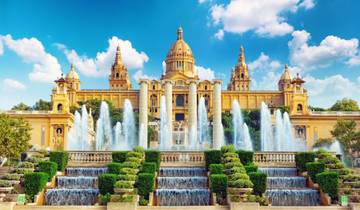
Catalonia, south of France, Burgundy, Alsace and Black Forest

Spain and Switzerland with enchanted Alsace

Spain, Burgundy, Alsace and Black Forest

France and Switzerland with Alsace and Black Forest
Alsace & lorraine tours starting in:.
- Strasbourg (38)
- Family (52)
- Fully Guided (44)
- Explorer (40)
- River Cruise (35)
- Personalized (21)
- Private (19)
- Self-Guided (19)
- Bicycle (16)
- Partially Guided (9)
- Coach / Bus (8)
- Hiking & Trekking (6)
- Small Group (3)
- 7 Day Tours (47)
- 10 Day Tours (11)
- Spring 2024 (24)
- Summer 2024 (29)
- Fall / Autumn 2024 (35)
- Winter 2024 / 2025 (28)
- Spring 2025 (14)
- Summer 2025 (2)
- Fall / Autumn 2025 (10)
- Winter 2025 / 2026 (10)
- April 2024 (13)
- May 2024 (24)
- June 2024 (26)
- July 2024 (27)
- August 2024 (27)
- September 2024 (28)
- October 2024 (32)
- November 2024 (17)
- December 2024 (16)
- January 2025 (12)
- February 2025 (12)
- March 2025 (12)
- April 2025 (2)
- May 2025 (2)
- June 2025 (1)
- July 2025 (2)
- August 2025 (2)
- September 2025 (2)
- October 2025 (10)
- November 2025 (3)
Other Regions in France
- Southern France (371)
- Northern France (332)
- Provence (121)
- Aquitaine & Midi Pyrenees (88)
- Normandy (87)
- Bordeaux & Dordogne (60)
- Loire Valley (46)
- Pays de la Loire (46)
- French Riviera (38)
- Burgundy (37)
- Ile de France (28)
- Corsica (17)
- Champagne (12)
- Beaujolais (6)
- Brittany (5)
Travel Styles
- Singles and Solo (57)
- For Couples (53)
- Seniors (34)
- Destinations
- Winery Directory
10 Best Alsace Wine Tours & Tastings to Book in 2024
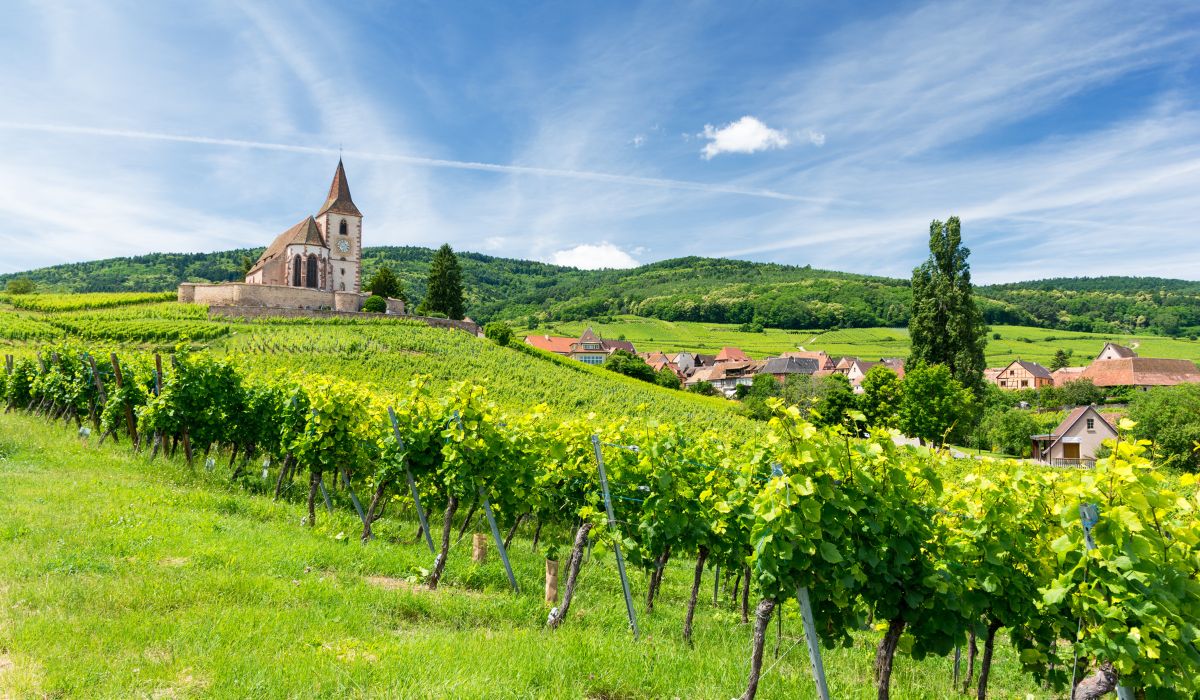
Take a journey to the storybook setting of the Alsace wine region with our carefully curated selection of private and customizable wine tours. Get to know the wines and producers in this acclaimed destination and visit quaint towns and villages and bucolic countryside vineyard landscapes.
Alsace is a noteworthy wine region located in the Grand Est region of France. It’s truly an enchanting blend of picturesque landscapes, rich history, and exceptional wines. As you plan your journey through this region, the promise of a unique experience in the world of viticulture awaits you. The Alsace wine region is renowned for its varietal wines, especially the aromatic Pinot Gris, the versatile Pinot Blanc, the elegant Pinot Noir, distinct Riesling and the sparkling Crémant d’Alsace . These wines, emblematic of the region’s diverse grape varieties, offer a taste of the region that is both authentic and sophisticated.
The region’s wine tours are not just about sipping a glass of wine in a tasting room. They are immersive experiences that intertwine the beauty of the Vosges Mountains, the charm of half-timbered houses, and the tranquility of storybook villages. Each wine estate offers a unique story, often steeped in centuries of wine production. From the famous Route des Vins d’Alsace to more intimate family vineyards, these tours showcase the rich heritage of Alsatian winemaking. Whether it’s a leisurely day trip or a full-day exploration, visitors can expect a curated journey through some of the most famous landmarks of the Alsace region, complete with expert guides who bring the history and culture of this French wine region to life.
In This Guide
- Background on the Alsace Wine Region
- Charming Alsace Towns & Villages
- Best Alsace Wine Tours to Book
- Travel Logistics, Luxury Hotels & Planning Your Trip
RELATED: Alsace Itinerary: Best Wineries, Tours & Hotels Along the Alsace Wine Route
Quick Background on the Alsace Wine Region
Understanding the Alsace wine region is key to appreciating its wines. Located near the German border, the region’s complex history, as a part of France and, at times, Germany, has shaped its unique identity. This is reflected in its architecture, local cuisine, and winemaking techniques. The Alsace AOC (Appellation d’Origine Contrôlée) signifies the high-quality standards of wines produced here. Alsace’s family vineyards and larger estates alike contribute to a rich mosaic of wine styles, from dry Rieslings to sweet late harvest wines. The half-timbered buildings, narrow streets, and medieval towns like Strasbourg and Colmar speak volumes about this past, offering a glimpse into a rich culture that complements the wine tasting experience.
Charming Villages & Towns to Visit in Alsace
Alsace is dotted with cities and towns each showcasing their own unique charm and offering convenient access to the region’s renowned wine tasting experiences.
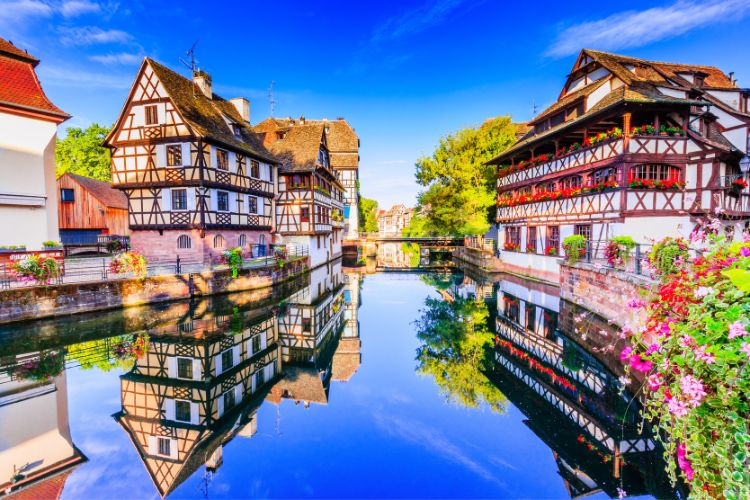
The capital of Alsace, Strasbourg is a vibrant city that masterfully blends modernity with historical heritage. Known for its stunning Gothic cathedral and the beautiful “La Petite France” district, the city’s architectural splendor is a sight to behold. Strasbourg is more than just a visual treat; it’s a hub for Alsatian wine culture, with numerous wine bars and shops offering selections from local vineyards. The city’s proximity to the northern part of the Alsace wine route makes it an ideal starting point for your wine tourism adventure.
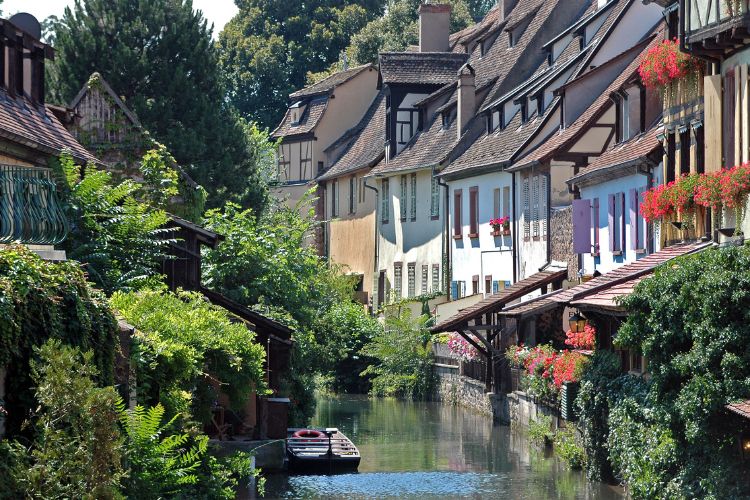
Often referred to as the wine capital of Alsace, Colmar is a key stop on the Alsace wine route. This town is renowned for its well-preserved old town, canals, and colorful buildings, which create a backdrop akin to a storybook setting. Colmar is surrounded by vineyards and is famous for its wine shops and tasting rooms where you can sample local wines and get a sense for the grape varieties and wine styles produced nearby. The town is also home to the Unterlinden Museum, showcasing local art and history.
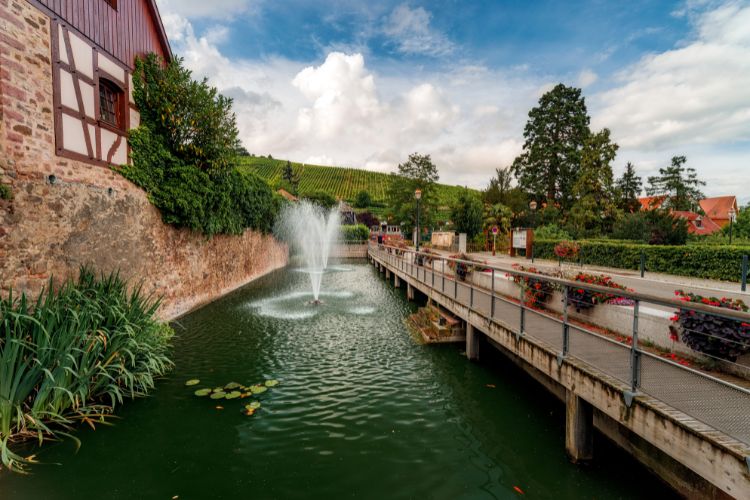
Renowned for its historical architecture and for being one of the most beautiful villages in France, Riquewihr is a step back in time. The town is surrounded by hillsides covered in vines, making it an excellent spot for those looking to combine historical exploration with wine tasting. The local wineries here are known for their Rieslings and other varietal wines.
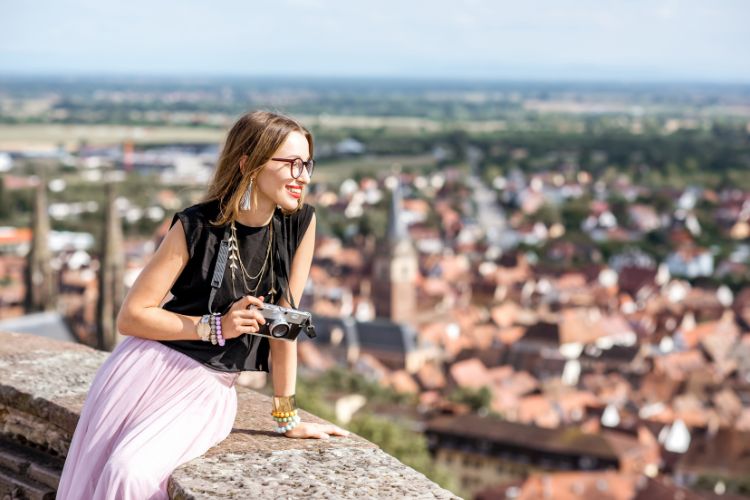
Located near the foot of the Vosges Mountains, Obernai is a charming town that encapsulates the essence of Alsace’s rich history and viticulture. The town’s center, with its traditional market square and ancient buildings, exudes a medieval charm. Obernai is less touristy than some other towns, offering a more authentic experience of Alsatian life. Its location makes it a great base for exploring both the wine route and the natural beauty of the Vosges.
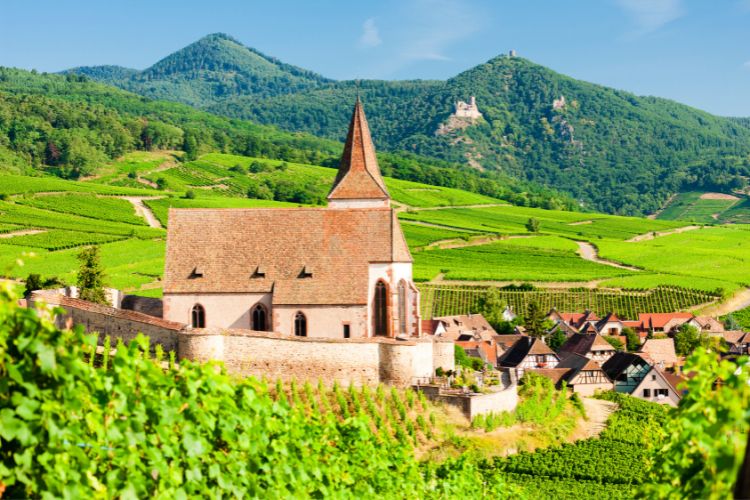
Hunawihr is a lesser-known gem in Alsace and a haven of tranquility and tradition. It’s characterized by its fortified church, which stands as a sentinel over rows of vines. The village’s serene ambiance is perfect for those seeking a quiet retreat. Wine enthusiasts will appreciate the local wineries that produce exquisite wines, reflecting the terroir’s unique characteristics. Hunawihr’s commitment to preserving its natural and architectural heritage makes it an ideal destination for those looking to immerse themselves in authentic Alsatian culture.

In 2013, Eguisheim won first place in the Le Village Préféré des Français competition.
Circled by vineyards, Eguisheim is a circular village that radiates charm from its core. Recognized for its floral displays and timber-framed houses, the town’s layout is a marvel of medieval urban planning. Eguisheim is deeply rooted in wine history, believed to be the birthplace of the Alsace wine industry. The town’s streets are lined with vintners and tasting rooms. Eguisheim’s vibrant energy and historical significance have earned it the title of one of the “Most Beautiful Villages of France,” making it a must-visit for those exploring Alsace.
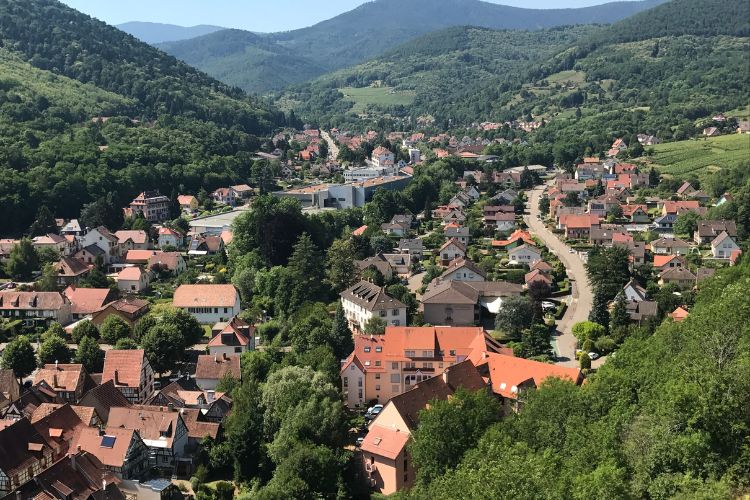
Kaysersberg , with its robust historical architecture and lively cultural scene, also stands out as a key destination. The charm of this village is accentuated by its imperial castle ruins that offer panoramic views of the surrounding vineyards. The town is known for its Christmas market and as a producer of some of Alsace’s most robust wines. Kaysersberg’s blend of historical gravitas and contemporary vibrancy makes it a compelling stop for those seeking to understand the depth and diversity of the Alsace wine region.
The Best Wine Tours Near Alsace to Book This Year
Journey through time and taste when you visit this remarkable wine region. The wine cellars, some centuries old, offer a window into the evolution of winemaking here, while the modern tasting rooms present the innovative spirit of Alsatian vintners. A walking tour through the small villages reveals hidden gems – from local restaurants serving traditional Alsatian cuisine like Tarte Flambée to historic buildings that tell tales of the past. For the nature lover, the scenic trails through the Vosges Mountains or along the Rhine River offer a serene backdrop to this wine-filled journey. Whether you’re exploring the famous Alsace Wine Route, visiting during the festive Christmas markets, or enjoying a private wine tour in one of the region’s smaller villages, Alsace promises an unforgettable experience for every traveler.
Private and Customizable Alsace Wine Tour: Alsace Wine Route Highlights in 3 Hours

Discover the enchantment of the Alsace Wine Route with a private, customizable tour operated by CTravel VTC . This three-hour journey, led by your local guide Christopher, offers a personalized experience in the comfort of a high-end, air-conditioned Mercedes. Christopher, who is not only a chauffeur but also a knowledgeable guide and skilled photographer, will take you through the heart of Alsace’s wine culture. His expertise covers local history, architecture, and gastronomy, ensuring a comprehensive understanding of the region. The tour is tailored to your preferences, whether it’s exploring the historic towns of Eguisheim, Riquewihr, Kaysersberg, or visiting the finest wine cellars in Alsace. Sit back, relax, and immerse yourself in the unique beauty and flavors of Alsace, as Christopher guides you through this memorable experience.
Book Your Private Tour of Alsace with CTravel VTC
Alsace Tour: Wine Tasting, Villages & Castle Visits with a Friendly Tesla Driver

This private tour, led by either Steph or Christophe from Steph-on-Tour , is an invitation to explore the heart of Alsace, offering a blend of wine tasting, village and castle visits, and a deep dive into the region’s rich history, cuisine, and culture. A unique aspect of this experience is the opportunity to learn colloquial Alsatian expressions, adding an authentic touch to your adventure. Tailored to your interests, this tour provides an insider’s perspective on Alsace. Marvel at the stunning architecture, soak in the picturesque Alsatian countryside, and indulge in the region’s renowned wines. Steph also offers another customizable tour option for a lower price that’s a bit shorter, “Le Petite Alsace.”
Traveling in a Tesla equipped with air conditioning and WiFi ensures comfort and connectivity throughout your trip. All beverages, including water and a selection of alcoholic drinks, are included, making your excursion through Alsace both enjoyable and hassle-free.
Book Your Luxury Private Tour of Alsace in a Tesla with Steph-on-Tour
The Emblematic: Visit of Alsace Villages, Haut-Koenigsbourg & Wine Tasting
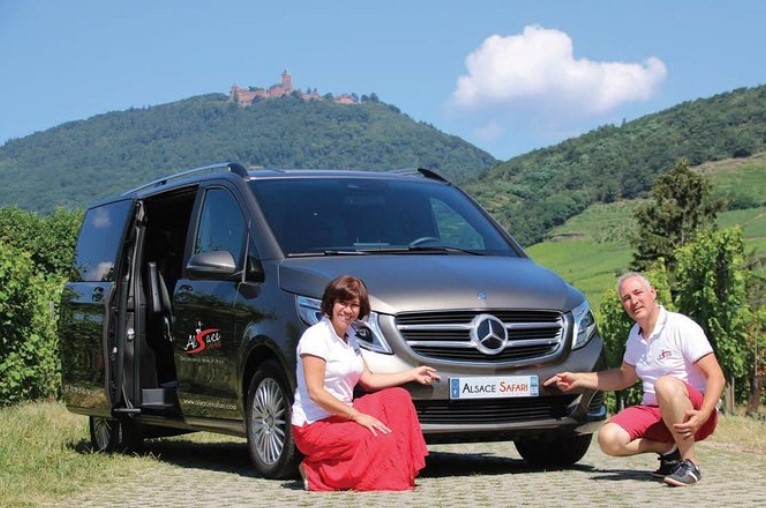
Take a full-day, private wine tour through Alsace with Alsace Safari , designed to offer an intimate and comprehensive experience of this renowned wine region. Key stops include the charming villages of Hunawihr, Riquewihr, Eguisheim, and Kaysersberg. Depending on the daily number of participants, there’s also a potential visit to the impressive Haut-Koenigsbourg Castle. The tour includes a visit to a local wine cellar, where you’ll have the opportunity to taste a variety of regional wines. All logistics and driving are taken care of for a relaxed experience.
All entry fees and tickets for the day’s activities are included in the tour. Bottled water is also provided for your convenience. To maintain a personalized and engaging experience, the tour is limited to small group sizes, with a maximum of seven travelers.
Book Your Visit to Alsace’s Villages, Haut-Koenigsbourg & Wine Tasting with Alsace Safari
Alsace 4 Wonders Small-Group Day Trip from Colmar

If you’re staying in Colmar, join Alsace Original Experiences for a distinctive day trip that unveils the multifaceted charm of the Alsace region. This small-group tour is an exploration of Alsace’s celebrated landscapes and medieval heritage. As you traverse the Alsatian Wine Route, the tour makes stops at many of the enchanting villages we discussed earlier – Eguisheim, Kayserberg, Ribeauvillé, and Riquewihr. You’ll also have the opportunity to stop in a wine cave and taste several grape varieties produced in the region, including Gewurztraminer, Pinot Gris, and Pinot Blanc.
You’ll have magnificent photo opportunities along the route, capturing the essence of Alsace’s vineyard-covered landscapes and time-honored villages. Comfort is a priority, with all transport provided via an air-conditioned minivan.
Book Your Alsace “4 Wonders” Adventure with Alsace Original Experiences from Colmar
Winegrower Walk with Domaine Specht

The Winegrower Walk offered by Domaine Specht is a unique adventure tailored for those with a passion for exploring the local viticulture scene. This engaging excursion begins at the Domaine, where you are invited to experience the essence of their vineyards through a leisurely walk that lasts approximately an hour and a half. Meander between the rows of vines, alongside streams, and past almond trees. This journey also offers stunning viewpoints over the Grand Cru Mandelberg, providing breathtaking vistas of the Alsace plain, the Vosges mountains, and the medieval towns of Riquewihr and Zellenberg. The adventure continues with a visit to the Domaine’s cellar, with a behind-the-scenes look giving you a deeper understanding of the journey from grape to glass.
Finish your experience with a tasting session where you can sample the distinct flavors of Domaine Specht’s wines. This tasting is paired with a traditional Kougelhopf, a local Alsatian delicacy.
Check Prices and Book Your Winegrower Walk with Domaine Specht
Alsace Colmar, Medieval Villages & Castle Small Group Day Trip from Strasbourg

If you’re based in Strasbourg, this tour operated by Ophorus is an exceptional choice . It’s a splendid way to experience the region’s most captivating sights, combining the rustic charm of Alsatian villages with the grandeur of historical castles.
Travel along scenic routes, winding through lush green hills and past the iconic Alsatian vineyards. The tour includes visits to the towns of Colmar and Eguisheim, where cobblestoned streets and traditional architecture transport you back in time. In Colmar, the colorful facades and serene canals offer a serene backdrop for exploration, while Eguisheim’s circular streets and floral displays are a delight. The medieval village of Riquewihr is another highlight, offering an opportunity to wander within its well-preserved walls. The tour ultimately takes you to the 12th-century Château du Haut-Koenigsbourg. Perched high on a hilltop, the castle offers panoramic views over the Vosges mountains and the Alsace plain.
Book a Wine Tour of Alsace from Strasbourg, Medieval Villages & Castle Visits with Ophorus
From Basel: Fantastic, Full Day, Private Wine Tour to Alsace!

If you’re staying in or near Basel and looking to explore Alsace, this tour, operated by WineWeinVinoVin is an ideal choice . They offer both half-day and full-day options, meticulously planned to cater to your preferences.
The journey begins in Basel, from where you’ll be whisked away into the heart of Alsace’s or Baden-Württemberg’s wine country. The focus of this tour is on visiting family-owned wineries, which are often less known yet hold a treasure trove of winemaking traditions and stories. These smaller estates provide a more intimate glimpse into the art of viticulture, often missed in larger, more commercial wineries.
As you travel through the countryside, you’ll learn about the unique terroir that sets Alsace wines apart. The tour is interactive, with ample opportunity to ask questions and discuss your specific wine interests.
Wine tastings are always a highlight, allowing you to taste some of the most prestigious wines from the region. With a dedicated driver, you can relax and fully and enjoy the experience without worrying about navigating the countryside.
Book Your Wine Tour of Alsace from Basel with WineWeinVinoVin
Travel Logistics & Planning Your Trip to and Around the Alsace Wine Region
When planning your journey to Alsace, the region’s accessibility via various airports and cities is a key consideration. Strasbourg Airport (SXB) is the most convenient gateway, located just 10 kilometers southwest of Strasbourg’s city center. This airport serves a range of domestic and European flights, making it a prime choice for travelers aiming to explore Alsace’s wine region.
For a broader selection of flights, including transcontinental routes, the EuroAirport Basel-Mulhouse-Freiburg , about 120 kilometers from Strasbourg, is an excellent option. This unique airport, operated jointly by France and Switzerland, offers extensive connectivity. Additionally, the Baden-Baden Airport (FKB) in Germany , approximately 60 kilometers from Strasbourg, presents a viable alternative for Winetravelers, particularly those arriving from European destinations. Check current flight deals into any of these airports and book your flight with Skyscanner to ensure you’re getting the best price for your travel dates.
Once in Alsace, there are several options available to explore its charming villages and lush vineyards. Renting a car provides the utmost flexibility, allowing travelers to meander through the scenic routes at their own pace and schedule. Major car rental companies are conveniently located at the airports and major train stations, offering a range of vehicles to suit different preferences.
For those preferring public transport, the region is well-connected by an efficient network of trains and buses. The French national railway company, SNCF, operates train services connecting major towns and cities in Alsace. The local TER (Transport Express Régional) trains are a reliable and scenic way to travel between smaller towns and villages. Buses complement the train network, with services like Lignes Interurbaines d’Alsace (LIA) connecting more remote areas. These buses are a budget-friendly option and offer a unique way to experience the local landscape and culture, but are a little more restrictive compared to renting a car.
When to Visit Alsace
Beyond transportation, there are other practical aspects to consider for a trip to Alsace. The region has a temperate climate, with the best time to visit being from May to October , when the weather is most favorable for vineyard tours and outdoor activities.
Luxury Hotels & Vineyard Resorts in Alsace France
For a luxurious stay in the Alsace region, there are several exquisite 5-star hotels and resorts to consider, each offering a unique blend of comfort, elegance, and proximity to the area’s vineyards.
L’Esquisse Hotel & Spa Colmar – Mgallery
Situated in the heart of Colmar, this 5-star hotel offers a blend of elegance and unique charm. It is located in the green haven of the Champ de Mars and is known for its stylish interiors and high-end spa facilities, making it a perfect urban resort for relaxation and exploration of Colmar’s historic center .
A La cour d’Alsace in Obernai
This elegant hotel is set in a medieval town and features rooms with beamed ceilings and antique-style furniture. It offers an indoor pool, sauna, spa treatments, and superb regional cuisine, making it a charming stay in an idyllic location. Its proximity to sights like the medieval city of Obernai and nearby Strasbourg makes it ideal for local exploring .
La Haute Grange in Fréland, Alsace
A beautifully situated farmhouse B&B, this property offers an adults-only retreat in the heart of Alsace. With only four rooms, it provides a cozy and intimate atmosphere, surrounded by forest and a lovely garden. The contemporary furnishings and cozy guest sitting room with a fireplace add to its luxury appeal .
Le Clos St Vincent in Ribeauville
This romantic hotel is set in the hills with valley views and is surrounded by vineyards. It features rooms and suites styled like wood cabins with elegant furnishings and private balconies. The hotel offers dinner in its restaurant, an indoor pool, and therapeutic spa facilities, creating a perfect country escape .
Le Grand Chalet et Spa in Colmar
An adult-only luxury retreat located in the heart of Alsace’s wine country. This resort offers stunning views over the Alsace plain, Bernese Alps, and Black Forest. The suites provide top-notch accommodation with individual preparation of breakfast and evening meals by the chef. Its spa and hot tub facilities make it a romantic haven for total relaxation .
Language in Alsace
Alsace is a region where both French and German are spoken. While English is widely understood in tourist areas, we recommend learning a few basic phrases in French to enhance your travel experience and help in interacting with locals.
You are reading “The Best Wine Tours in Alsace France to Book This Year:“ Back To Top
vineyard tours in Alsace, wine tours near me, Strasbourg, Colmar, Alsace wine tasting tours, how to visit the Alsace wine region, guided tours, private tours, luxury hotels in Alsace, wine tasting near me: Top French Wine Regions, Cities & Villages to Visit
If you enjoyed this guide, consider joining the Facebook Group to interact with other Winetravelers and for wine travel inspiration around the world. Be sure to follow us on both Twitter and Instagram to stay up to date with our trending content.
Login to view more Articles
Leave a comment, ask a question or share a review cancel reply, you might also like, best mornington peninsula wineries & wine tours for 2024, ultimate guide to visiting châteauneuf-du-pape’s best wineries in 2024, 16 best wineries to visit near rome in 2024, 15 best mclaren vale wineries & wine tours to try 2024, 30 best bordeaux wineries & famous vineyards 2024, 8 amazing fall european destinations for food and wine lovers, 10 best charming places to go in europe during winter, wineries nearby, adoria vineyards, chateau margaux, chateau lafite, cheers to free membership.
Explore new paths. Travel expertise from locals and wine industry experts.
Get free access to all the goods:
- Exclusive articles
- In-depth itineraries
- …and more
The Essential Guide to Alsace, France: What to See & Do
:max_bytes(150000):strip_icc():format(webp)/profilepic-CTraub-5b6ff65d46e0fb00505577c1.jpg)
Westend61 /Royalty-Free/Getty Images
Many visitors never make it to the northeastern French region of Alsace, even though it's easily accessible from Paris by train. But you should strongly consider adding it to your itinerary. The vast area stretching from Strasbourg in the north to Mulhouse in the south is notable for its diverse, postcard-worthy architecture, distinctive food and wine that blends German and French traditions, and arresting landscapes. Alsace boasts a distinctive local culture , in part because it has been part of both France and Germany at different points in its history .
It's famous for storybook-pretty villages with half-timbered houses, cities boasting Gothic cathedrals and enchanting holiday markets, hundreds of miles of vineyards interspersed by medieval villages, and centuries-old castles perched high on clifftops. Alsace is an inland region in northeastern France, bordering Germany and Switzerland and situated primarily on plains formed along the west bank of the Rhine River. The Vosges mountains lie to the west, while the Black Forest and Jura mountain ranges are found to the east and southeast, respectively. The climate is relatively mild and dry, but winters tend to be fairly cold.
In Alsace, you'll hear French and Alsatian, a Germanic dialect, spoken. Some half of residents in the region speak Alsatian in addition to French, the sole official language. Also, German is widely taught in regional schools.
The region has been a source of conflict and contestation between France, what is now Germany, and local independence movements for hundreds of years. After the Franco-Prussian War in 1870, 90 percent of the broader region known as Alsace-Lorraine was annexed into the German Empire in 1871, then ceded to France during the Treaty of Versailles at the close of World War I in 1919. It gained a measure of independence and self-governance between the world wars, only to be occupied by German troops in 1940, at the beginning of World War II. Today, as part of the broader and recently created "Grand Est" region of France, Alsace features laws and regulations different from those found elsewhere in France, and Alsatians are proud of their unique cultural traditions and identity.
The Best Time to Visit
Boasting a relatively dry climate and semi-temperate mercury levels through much of the year, Alsace can be a pleasant destination year-round.
If you're interested in wine-tasting and sampling local festivities, June through August is an excellent choice. During the summer months, annual harvest festivals turn the Alsace wine route (see more below) into a circuit of cultural discovery, with wineries opening their doors for special tastings and the streets of numerous cities giving way to live music, folk dancers, and other events.
If traditional holiday markets and festivities are calling your name, go in late November and December. Colmar and Strasbourg, in particular, are famous for their idyllic Christmas markets , where glowing wooden lodges, lights, decorations, and wintery treats such as mulled wine give Scandinavia a run for its money in the hygge department.
Finally, if outdoor activities like hiking, river cruises, and visiting the region's beautiful castles sound most appealing, consider going in the spring. In April, the pretty town of Colmar puts on a variety of festive events to celebrate the springtime, from pop-up markets to musical performances.
Where to Visit in Alsace
Alsace boasts numerous cities and towns worth exploring, each noted for their architectural gems and distinctive local culture. Depending on the length of your stay, you may choose to organize your itinerary around visits to two or more of these.
Remember that day trips from hubs like Strasbourg, Colmar, and Mulhouse can make it possible to spend time exploring some of the region's prettiest towns and villages , whether by bike, foot, train, or even river cruise. Also, see our suggestions below on the Alsace Wine Route for ideas on touring some of the region's smaller but intensely photogenic towns.
The capital of Alsace and home of the European Parliament, Strasbourg is the region's most populous and urban city and a historic center of political and religious power. Its outstanding feature is its imposing Gothic cathedral, which for centuries was the world's tallest human-made structure.
- Notre-Dame Cathedral is a masterpiece of high-Gothic architecture and crowns the city center on the enormous Place de la Cathédrale square. Construction began in around 1015 and was completed in 1439. The cathedral features a distinctive facade in pink sandstone, elegant Gothic spire reaching nearly 466 feet, well-preserved medieval stained glass and statuary. An astrological clock completed in 1842 offers a fascinating spectacle every day at 12:30 p.m. If visiting during the winter holidays, make sure to visit the cathedral's enormous Christmas market, one of Europe's largest and oldest.
- See some of Strasbourg's best museums , many of which are located in close reach of the cathedral. The nearby Palais Rohan hosts the Fine Arts Museum, Archaeological Museum, and Decorative Arts Museum.
- Take a stroll around the neighborhood known as Petite France, one of the city's oldest and best-preserved. The area was once home to fishers and millers working around the meandering quays of the River Ill. Its colorful, half-timbered houses date to the 16th and 17th centuries and boast balconies and windowboxes bursting with flowers. The area is part of a UNESCO World Heritage site.
This fairytale-worthy city is situated in close reach of the German border and is the third most important in Alsace in terms of population. Colmar is famous for its picturesque riverside areas and old town, local cuisine and wines, and for serving as an essential gateway to the Alsace Wine Route.
- The Petite Venise (Little Venice) is widely considered one of France's loveliest Renaissance-era quarters. Cut through with canals fed from the Lauch River, the area is endowed with beautifully restored half-timbered houses in bright, storybook-reminiscent shades; window boxes and balconies burst with geraniums and other blooms during the spring and summer, drawing tourists in the thousands. The Rue des Tanneurs features sloping rooftops once used by tanners to dry animal hides, while fishermen once carried out their busy trade on the Quai de la Poissonnerie.
- The Musée Unterlinden is a gallery built around a stunning Dominican cloister from the late Gothic period. The gallery features important works such as the Issenheim Altarpiece, a late medieval masterpiece depicting New Testament stories; it was created by painter Mathias Grünewald and the sculptor Nicolas de Haguenau. Also come to see late-15th century prints and an outstanding modern art collection, with paintings from the likes of Renoir, Monet, and Picasso.
- Old Town is home to numerous impressive buildings built in the medieval and Renaissance periods , and dating from the 12th to the 17th centuries.
- Take one or more day trips to nearby, picturesque towns, including Riquewihr, Eguishem, and Kaysersberg (the latter boasts an impressive 13th-century fortified castle). Also, make sure to hop over (and up) to the Chateau du Haut-Koenigsbourg, a fortified medieval castle in the town of Orschwiller. Dating to the 12th century and perched high above the Alsace plains in the Vosges mountains, the castle is one of Alsace's most impressive structures. It was renovated in the 19th century, giving it the appearance of a formidable and intact fortress.
The second-largest Alsatian city after Strasbourg, Mulhouse is located in the southernmost part of the region near the Swiss border. While the industry-heavy town isn't as popular with tourists as the more picturesque Strasbourg and Colmar are, it can serve as an excellent hub for exploring the "Haut Rhin" area. Confusingly enough, the term means "High Rhine" but refers to the southern part of the Alsatian plains.
- See the Automobile Museum (Cité de l'Automobile). This fascinating exhibit displays some 400 vintage cars. It offers insight into the history of the industry, before heading to the Cité du Train, a collection devoted to the history of locomotives and rail travel.
- Taste local cuisine at some of Mulhouse's trendiest restaurants , including Le Gargantua, a table and cellar offering creative twists on Alsatian cuisine paired with local wines.
- Take a day trip to the nearby Thur Valley , walking or cycling its green paths and Thur riverside areas to explore local vineyards and quaint countryside. You can also make easy and quick jaunts over the Swiss and German borders, setting out for hikes in the Black Forest mountains or spending a few hours exploring the elegant Swiss town of Basel.
Wine in Alsace
Interested in wine? Alsace is one of France's most important wine regions , with a dizzyingly complex " wine route" that stretches for around 100 miles east of the Rhine rive r; the Vosges mountain range lies to the west. While Burgundy, Bordeaux, and Loire Valley wines are more famous than those produced in Alsace, the landscape here is incredibly diverse and produces some distinctive and delicious whites in particular. Some 1,200 wineries—most from small, family-owned producers—are clustered along the route, which extends from nearby Strasbourg in the north to Colmar in the south.
Like neighboring Germany, Alsace produces mostly white wines, from dry to sweet; they make up around 90% of wines made in the area. Local vineyards produce finished products from an incredibly diverse variety of grapes, including Chardonnay, Gewürztraminer, Riesling, Sylvaner, Pinot Blanc, Gewürztraminer, Riesling, and Pinot Gris (formerly known as "Tokay") varietals. In addition to still wines, try to taste at least one example of Crémant d'Alsace, a sparkling white wine similar to champagne.
Vineyards in the area tend to lie at altitudes of 650 to over 1,300 feet, giving them optimal sunlight; also, typically dry conditions on the plains favor winemaking. Vines are often strung or "trained" on high wires to maximize exposure to sunlight.
Using Colmar or Strasbourg as a hub, explore the vineyards and cellars surrounding what seems like endless storybook towns along the long route. Eguishem is famous for its Riesling and Gewürtztraminer white wines. Barr is noted for exquisite examples of these same wines and boasting a picture-pretty medieval town center, while Riquewihr, a tiny, beautiful village that has been known for its winemaking activities since the Middle Ages. The latter produces elegant organic chardonnay-based whites, as well as prized "Grand Cru" rieslings.
To make the most of the route, we recommend taking a guided tour. You can find more information on available tours, the top winemaking towns and vineyards, cellars open to visitors, and annual harvest festivals in Alsace at the official Wine Route website .
One sight that will become familiar as you tour the region is the winstub , an Alsatian-style cellar and restaurant that serves both local wines and hearty regional specialties such as sausages, cheese plates, sauerkraut, and others. You can find a list of some of the best winstubs in the region here .
Foods to Try in Alsace
Make sure to try a few typical Alsatian foods and dishes during your stay. These include sauerkraut, bretzel (pretzels), flammkuchen (an onion, cheese, cream, and chopped pork pie shaped like a rounded or square pizza), sausages and potatoes, and bäckeoffe, a meat, potato and vegetable stew made with beef, pork, and mutton, all slowly cooked in white wine such as Riesling. Meanwhile, typical Alsatian cheeses include Munster, a semi-soft, robust, and unpasteurized cow's milk cheese that's widely exported, and Tomme Fermière d'Alsace, a hard cows milk cheese that's lightly washed with a fruity white wine.
In southern Alsace, fried carp is a favorite, and is tied to the region's historic Jewish and Yiddish communities. During the springtime, look out for a variety of dishes featuring or accompanied by white asparagus, which is produced in the region and is generally fresh and delicious.
Craving dessert? Local treats such as sweet flammkuchen, kougelhopf (a domed-shaped brioche cake dusted with sugar), and traditional pain d'epice (gingerbread or spiced bread) should do the trick. Local versions of cheesecake and apple tarts are also quite popular, and delicious.
How to Get There
Getting to Alsace is relatively straightforward. Regular trains connect Paris Gare de l'Est to Strasbourg, with journeys averaging around two hours. You can easily catch a connecting train to Colmar and other cities and towns in Alsace from Strasbourg.
In addition, Strasbourg Airport services flights from destinations, including London, Amsterdam, Munich, Bordeaux, and Toulouse. Carriers operating at the airport include Air France and Lufthansa.
There are also a wealth of practical tips, suggested itineraries, advice on accommodation, and other useful resources at the Visit Alsace site , managed by the regional tourism board.
Top French Wine Tours, Regions and Wine Routes
The Complete Guide to France's Wine Regions
7 Top Vineyards to Visit in France
Strasbourg Travel Guide: Where France and Germany Collide
The 8 Best Day Trips From Strasbourg
France Border Travel From the North to Spain
Germany's Wine Road
The 8 Best Foods to Try in Strasbourg, France
The 15 Best Things to Do in Strasbourg, France
The Best Christmas Markets in France
How to Travel From Paris to Strasbourg by Train, Bus, Car, and Plane
French Countryside Driving Routes and Scenic Road Trips
How to Travel from Paris to Colmar by Train, Bus, Car, and Plane
The Best Places to See Fall Colors in France
The Best Time to Visit Strasbourg
The Best Christmas Markets in Paris for 2019
Road Trip Alsace – Itinerary & Map
Article written by Elisa - Travel Writer & Local in France This article may contain compensated links. Please read disclaimer for more info.
Here’s the Ultimate Alsace Road Trip
The historic region of Alsace , today part of the region of Grand Est in Eastern France , is a land rich in natural wonders, picturesque small towns, and good wines. The Alsatians are amicable and welcoming people, the Alsace Christmas Markets are the best in France, and the Alsace food is excellent too!
The best way to explore the region of Alsace is by car. This Alsace Road Trip from Mulhouse to Strasbourg (or vice-versa) covers part of the Alsace Wine Region , but it also visits other interesting sites near this route.
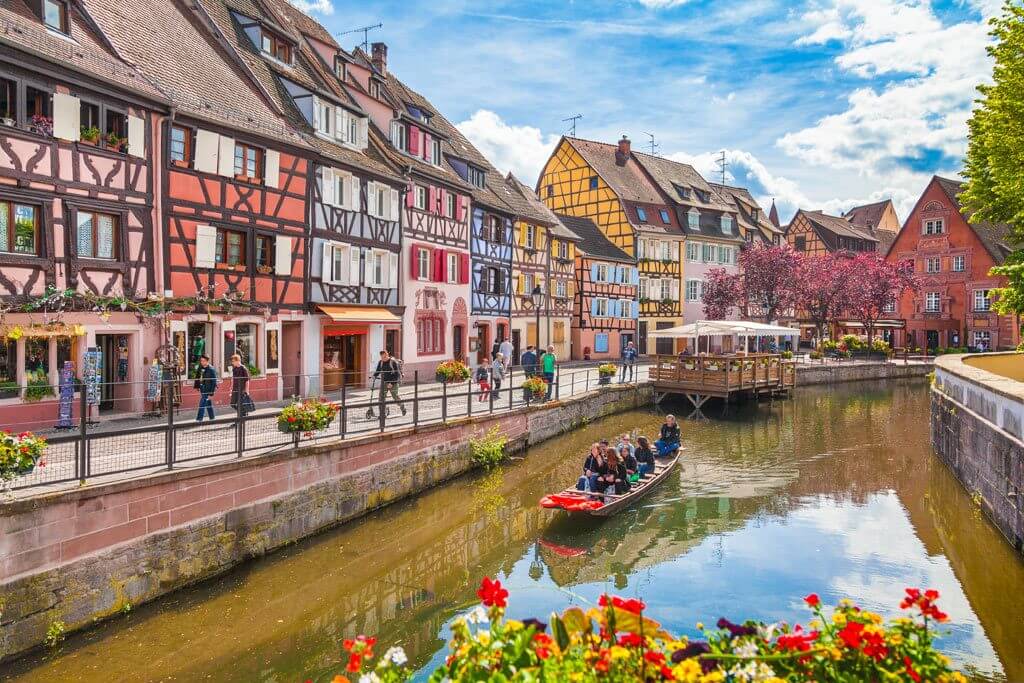
This road trip Alsace itinerary takes seven days, and it is a good itinerary for those who love history, sightseeing, outdoor activities, and wine.
This Alsace trip by car is one of the best road trips in France . Read more about road-tripping in France:
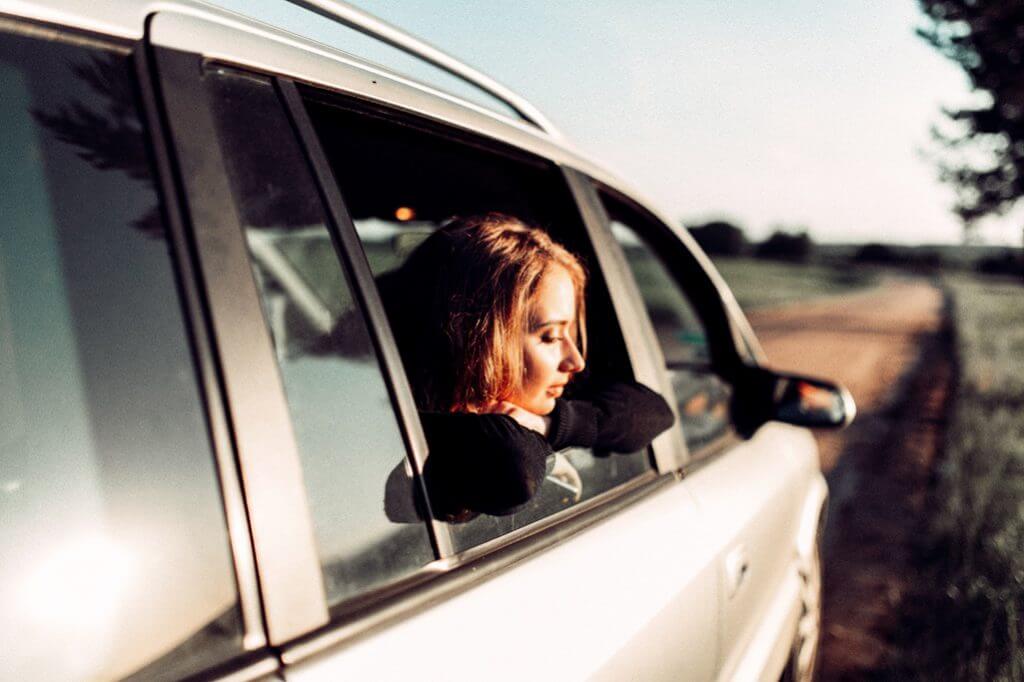
Alsace Road Trip Overview
- Start: Mulhouse
- Finish: Strasbourg
- Duration: 7 days
- Suggested route: Mulhouse – Colmar – Strasbourg
- Total distance: 155Km, 2,5 hours drive in total
- Region covered: Grand Est
- Best for: history, sightseeing, nature, small towns, food & wine
Road Trip Alsace Map
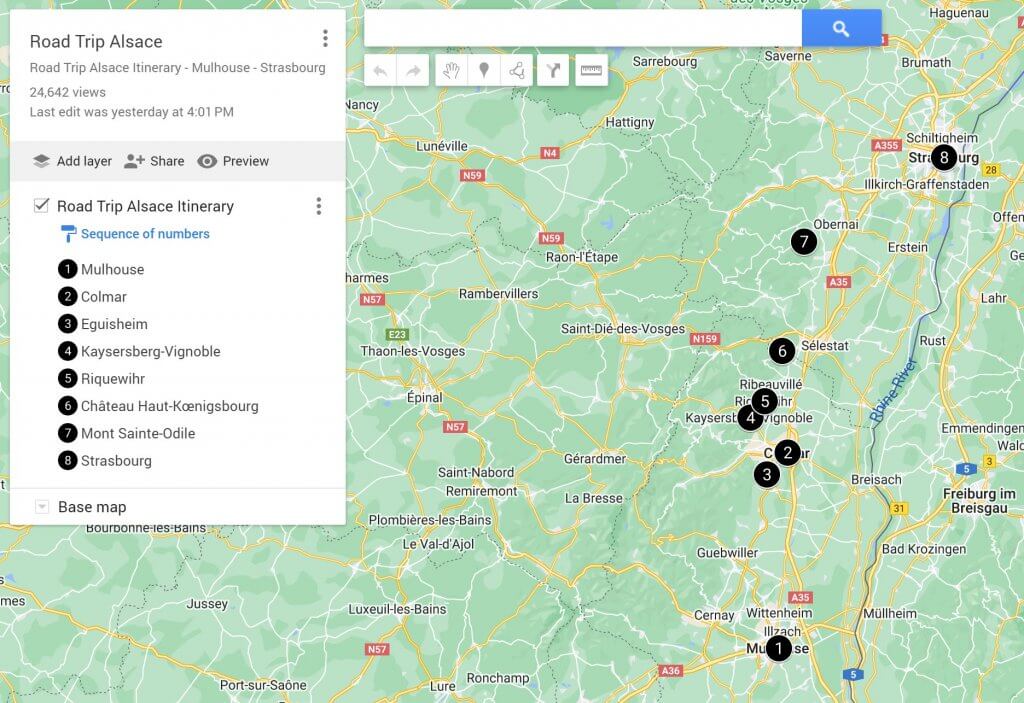
Click here to see this Road Trip Alsace Map on Google
Road Trip Alsace Itinerary
This Alsace road trip starts from Mulhouse , the second most important city in Alsace. If you don’t have a car, you can travel to Mulhouse by train and then rent one in Mulhouse (click here for our best tips for renting a car in France ). The chances are that car rental in Mulhouse is cheaper than in Paris, plus you avoid the hassle of driving from Paris or any other city to the east.
Click here to rent your car in Mulhouse
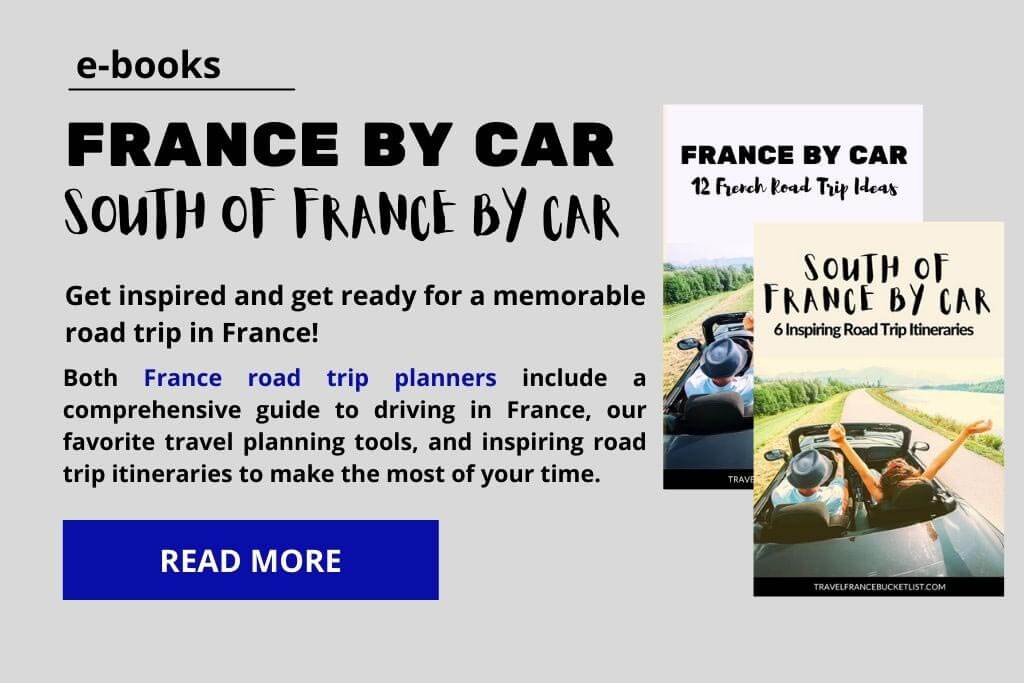
Day 0 | Arrival in Mulhouse
Arrive in Mulhouse the day before the start of this Alsace road trip. For your night in Mulhouse, Hotel Bristol is comfortable, beautiful, and very central.
Click here to book your stay at Hotel Bristol
Day 1 | Mulhouse – Colmar
Morning in Mulhouse
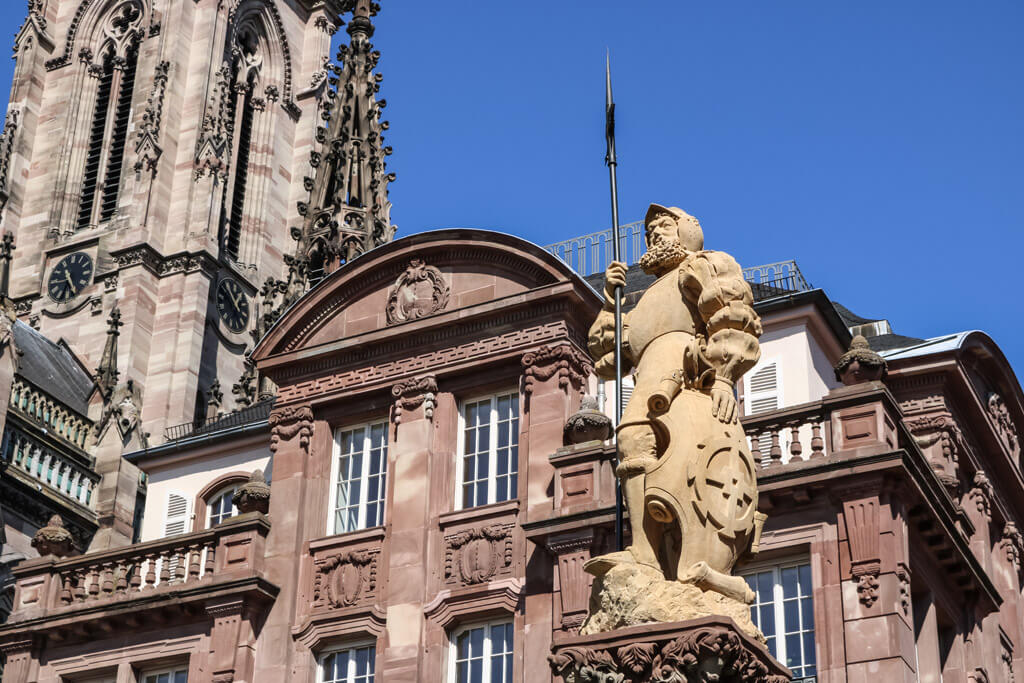
The first day of this road trip Alsace starts by exploring the city of Mulhouse . After a good breakfast with no rush, spend the morning visiting the Old Town. Mulhouse has a beautiful central square ( Place de la Réunion ) dominated by the Temple St. Etienne and the Town Hall. The surrounding streets are also interesting to explore too.
Afternoon at La Cité de l’Automobile
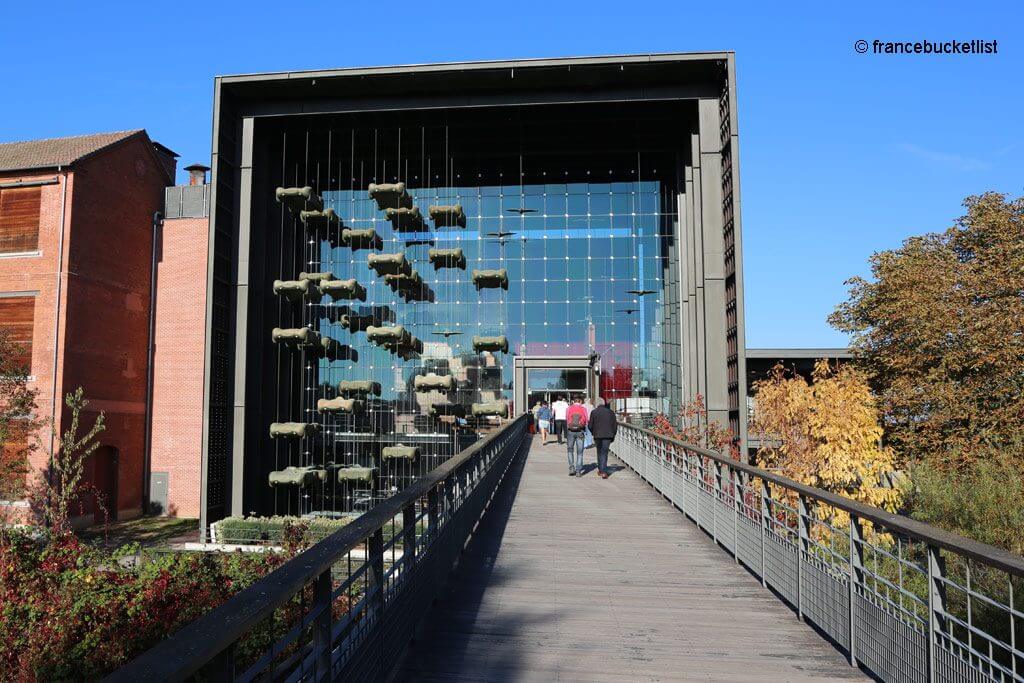
Mulhouse’s main attractions are the Automobile Museum ( Cité de l’Automobile ) and the Railway Museum ( Cité du Train ). These two top museums reflect the history of the city, which is strongly influenced by industry.
If there’s time to visit only one museum in Mulhouse, we recommend La Cité de l’Automobile. Also known as Musée National de l’Automobile , this fantastic museum is built around the Schlumpf collection of classic automobiles.
The Schlumpf brothers were two businessmen with a passion for cars living in Mulhouse. Their collection, located in one of their former factories, contains the largest and most comprehensive collection of Bugatti cars in the world. The museum displays not only some of the very first Bugatti cars but also racing cars and luxury cars. It is amazing!
TIP: This museum is huge! When you arrive, it is a good idea to take the free little train (with a commentary), which meanders around the museum to get an overview of the collection and the different sections.
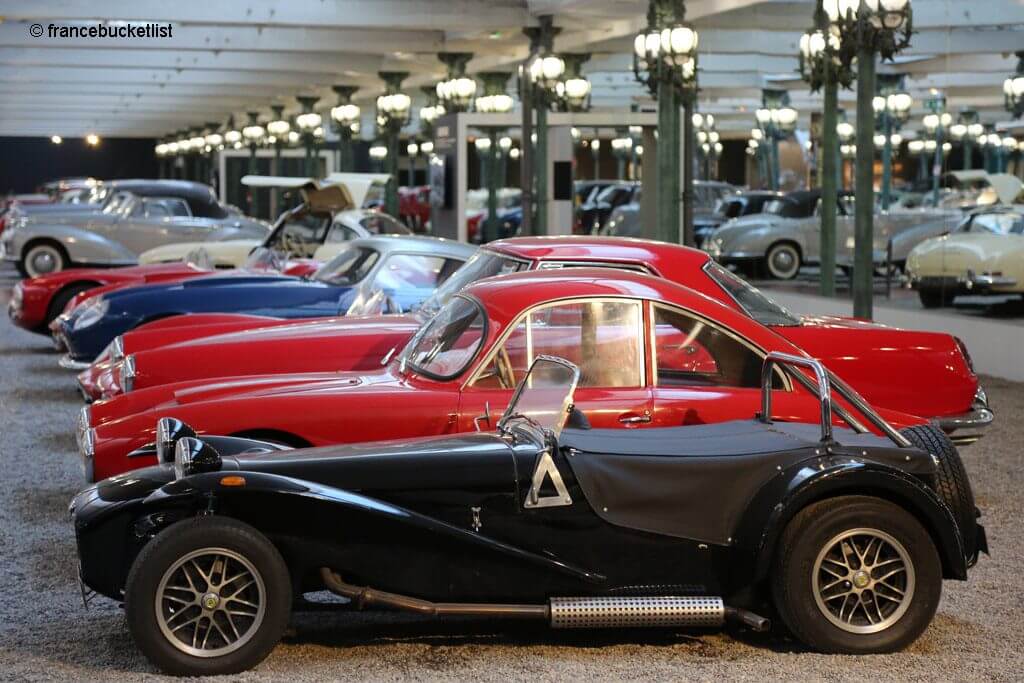
The Cité du Train is an excellent museum to visit too. The Cité du Train is the biggest train museum in Europe, and it displays more than 100 French trains from all periods.
Evening and Night in Colmar
After visiting the museum of your choice in Mulhouse, drive to Colmar, where you will spend three nights. For your stay in Colmar, we recommend the Hotel Le Colombier , a charming property located in the district of Little Venice. This hotel has spacious and stylish rooms, a bar, and a garden in which to relax.
Click here to book your stay at Hotel Le Colombier
Day 2 | Colmar
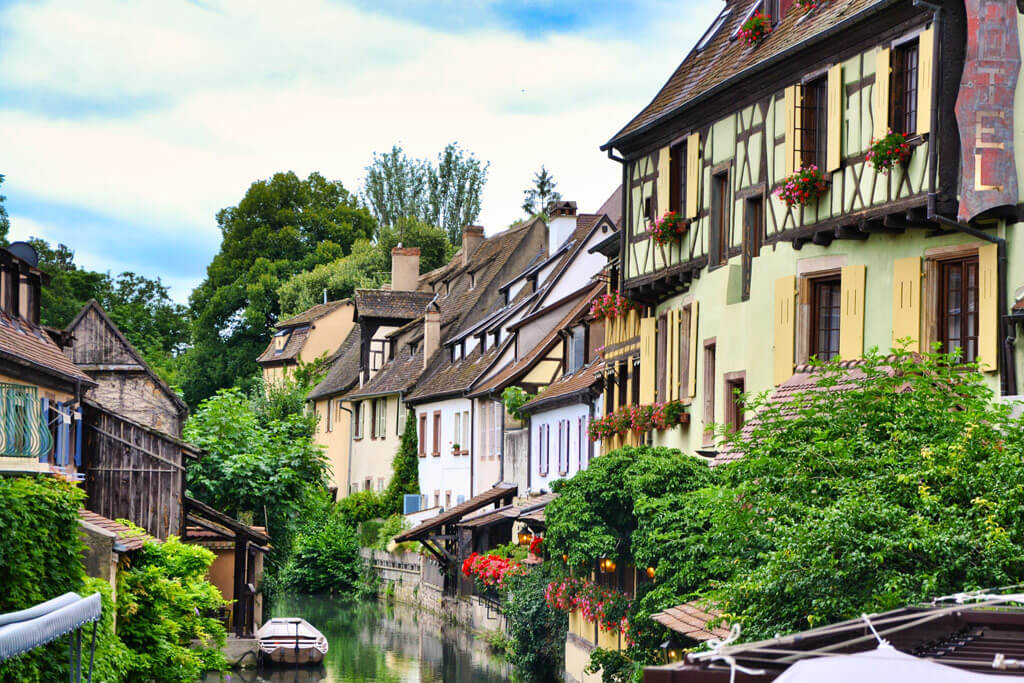
Day 2 of this Alsace road trip is dedicated to visiting Colmar. Located in the center of Alsace, between Strasbourg and Mulhouse, the oh-so-pretty Colmar is one of the must-stops of any Alsace itinerary. This medium-sized city is frequently voted as one of Europe’s most beautiful cities, and it has many monuments and typical neighborhoods.
You are going to love walking around Colmar. The Old Town of Colmar is very picturesque, with half-timbered houses, cobblestone lanes, and quaint canals. Don’t miss La Petite Venise , Colmar’s most picturesque neighborhood built along the main canal.
In Colmar, you have one of the best museums in the region, the Unterlinden Museum . Once a monastery, it is now filled with masterpieces of art from the Middle Ages to Modern Art.
A signposted walking trail leads visitors in a 6.1km loop around the city (estimated time: 2.5 hrs). The route is outlined on the free Colmar Old Town Map from the tourist office, or follow the golden triangles along the way (embossed with Lady Liberty) to the top Colmar sights.
The list of fun things to see and do in Colmar includes:
- The Unterlinden Museum
- The Bartholdi Museum
- The Little Venice
- The Food Market (consider having lunch inside for a super local experience)
- The Toy Museum
- The Choco Story Colmar
FUN FACT: Artist Auguste Bartholdi – The man who created the Statue of Liberty – was born in Colmar in 1834. As a Colmar claim-to-fame, Lady Liberty appears throughout the city.
Day 3 | Colmar – Eguisheim – Colmar
Morning in Eguisheim
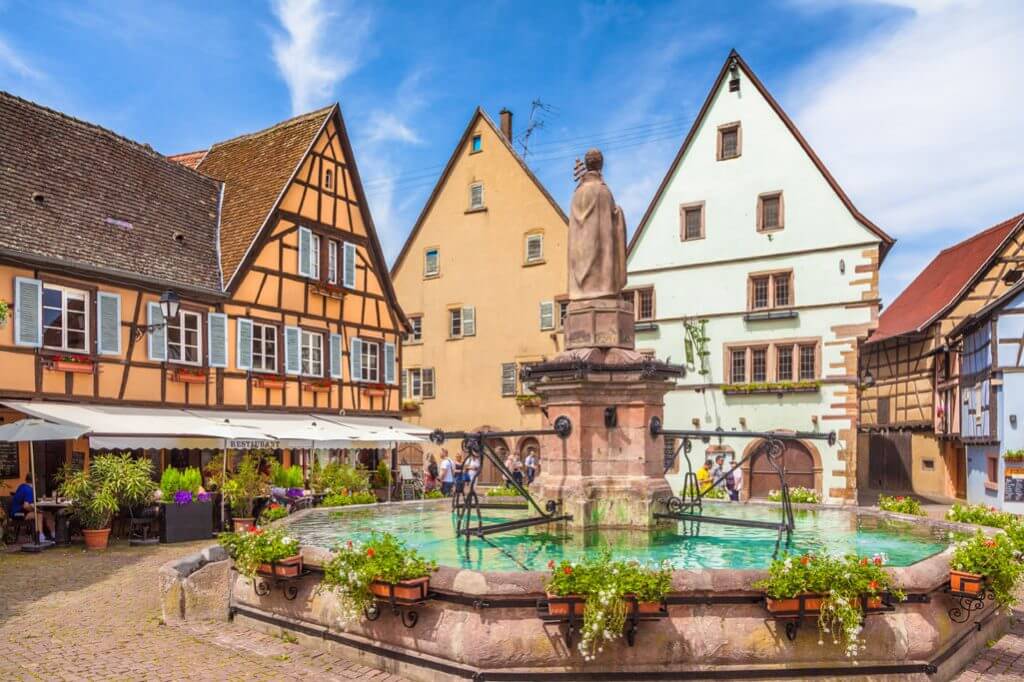
From Colmar, consider a half-day or a day trip to Eguisheim, located just out of Colmar. Eguisheim is one of the most beautiful villages in Alsace , and it is a wonder. Eguisheim is only a 10-minute drive from Colmar, and some people like to take this excursion to Eguisheim by bike.
Eguisheim has a unique layout, where the streets are arranged in concentric circles around the Eguisheim Castle. Wander around the narrow cobbled streets, flanked by the beautiful architecture of half-timbered houses with balconies and windows full of flowers. Don’t miss the central square with its magnificent stone fountain and the colorful Saint Leo Chapel inside.
One of the best things to do in Eiguisheim is to visit one of the many cellars in the Old Town , where you can learn more about the local grape varieties and do some tastings. After some research, we recommend the wines from Eichberg and Pfersigberg , which reveal aromas of fruit, honey, and wood.
Afternoon Hike Up to the Three Towers
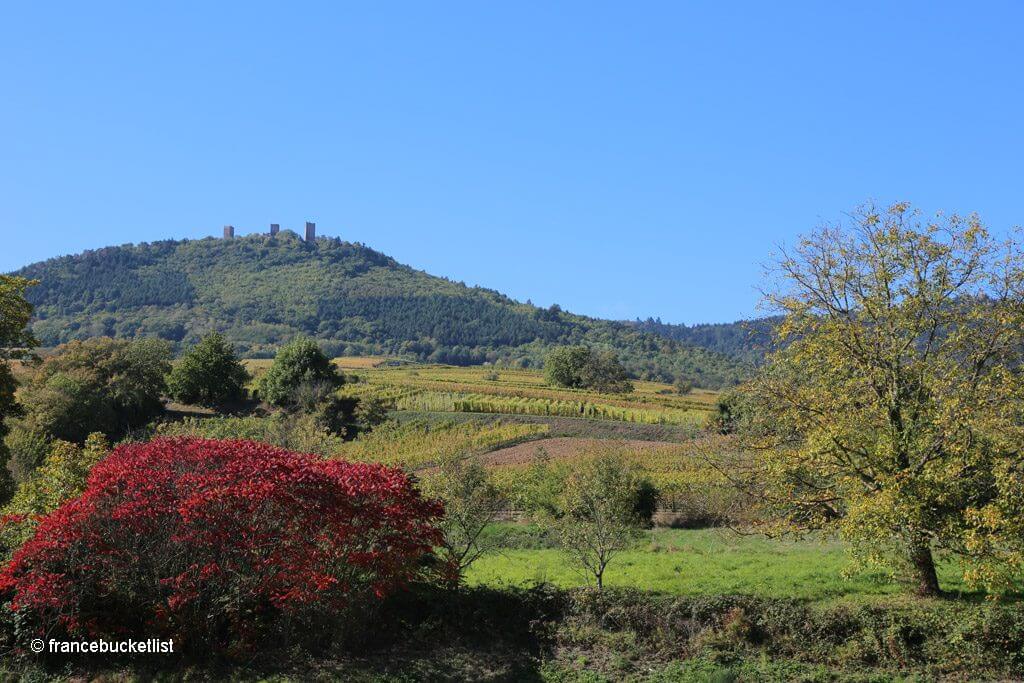
The Three Castles on the Schlossberg Hill (591m) is a beautiful trail to walk, and it starts from Eguisheim. The Castles were built during the 11th and 12th centuries by three families of the region. All three Castles were destroyed in 1466 during the War of the Six Oboles.
The ruins of the Castles per se are nothing spectacular, but the hike up to the hill is beautiful and easy to walk (1.5 hr uphill). Take the trail starting at the camping site “Les Trois Chateaux” in Eguisheim. On the way, you will cross vineyards, the small town of Husseren-Les-Châteaux, and a bit of forest at the end of the hike.
Moreover, this path offers an exceptional panorama of the whole valley and its three Castles. The views from the top of the hill are also great.
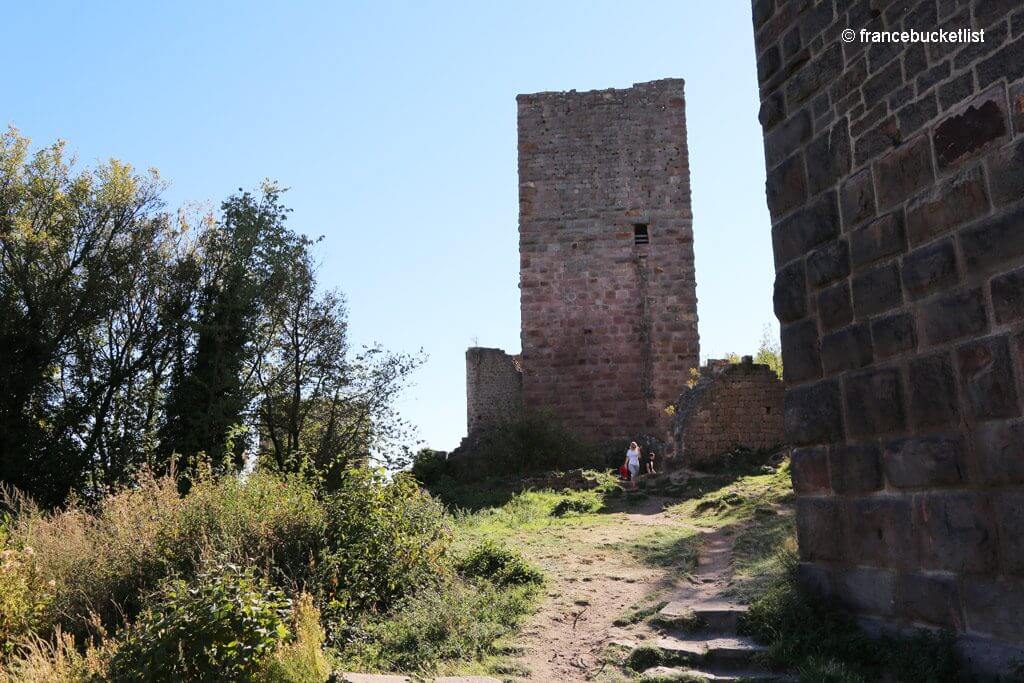
Day 4 | Kaysersberg – Riquewihr
Morning in Kaysersberg
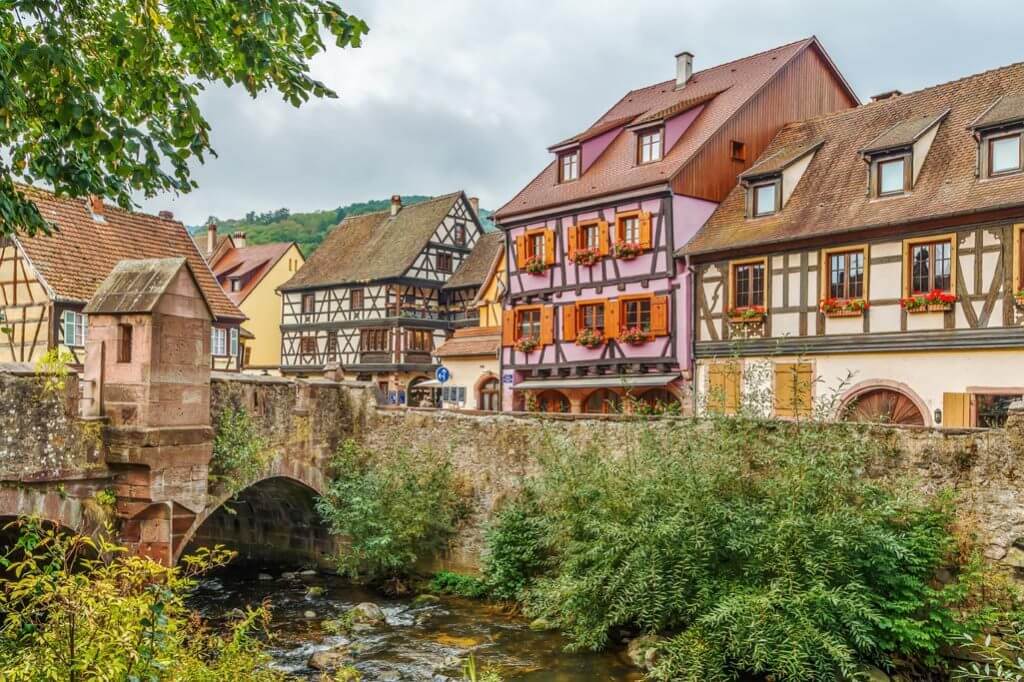
Day 4 of this Alsace itinerary by car explores two of the prettiest Alsace villages. From Colmar, drive to Kaysersberg Vignoble , a small town nestled at the entrance of a Vosges Valley, only a few kilometers from Ribeauvillé and Riquewihr. Kaysersberg is built next to the River Weiss, which flows between the houses.
You are going to love Kaysersberg, with its beautiful historic center, its many half-timbered houses from the 15th – 16th centuries, and a unique fortified bridge built in 1514 in pink sandstone from the Vosges. Kaysersberg means “the Emperor’s mountain,” and the ruins of the imperial castle that dominates the city have an incredible charm.
TIP: don’t miss the stone decoration on houses and public buildings and the old shop signs.
Afternoon in Riquewihr
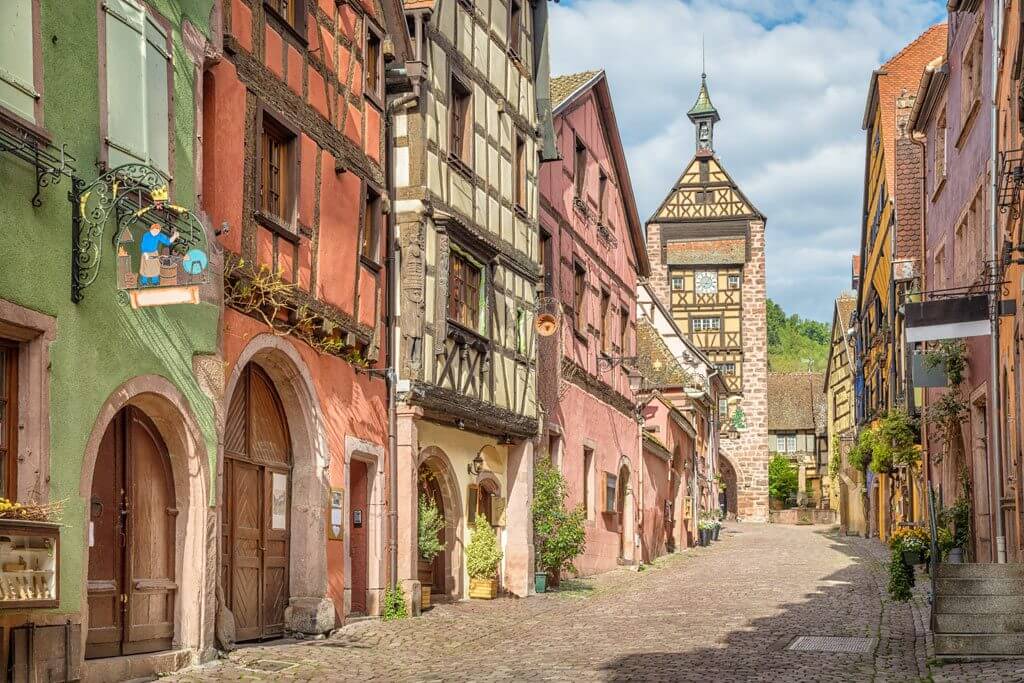
From Kaysersberg, drive to Riquewihr , another picturesque town where you will spend one night. For your stay in Riquewihr, book the charming Hotel à l’Oriel , located in the heart of the Old Town. The hotel proposes individually decorated beautiful traditional rooms, a good breakfast, and private parking.
Click here to book your stay at Hotel à l’Oriel
If you only have time to visit one village in Alsace, Riquewihr has everything to fall in love with it. This fortified village, surrounded by vineyards and listed among the Most Beautiful Villages of France, was built in the 16th century, and it is as if time has slowed down in this town.
Apart from its beautiful half-timbered houses and picturesque alleys, Riquewihr has no less than 40 classified Historical Monuments. Follow the town’s walls and visit the village’s three defense towers, some of the oldest fortifications here. The famous Thieves’ Tower was the former prison of Riquewihr.
At the entrance of Riquewihr, you will find several wine producers offering wine tastings and their best bottles of Alsace wine. We bought a couple of bottles of muscat and crémant at Domaine Dopff au Moulin (2 Avenue Jacques Preiss, Riquewihr). Then, within the walls, you will find many wine shops.
Day 5 | Riquewihr – Strasbourg
Morning at Château du Haut-Koenigsbourg
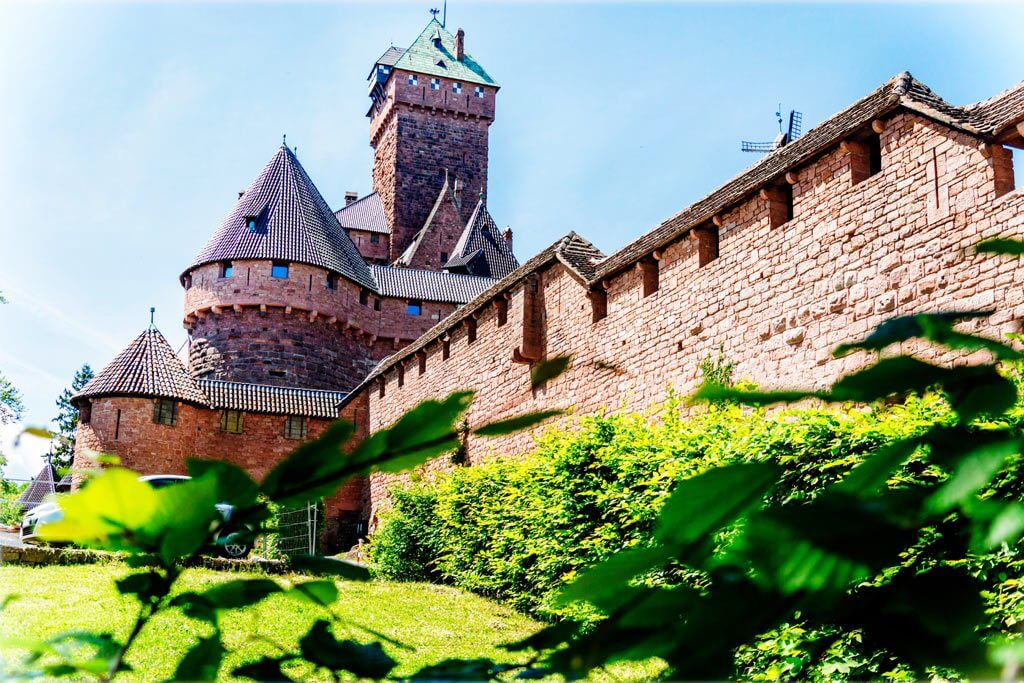
Day 5 of this road trip Alsace starts with a visit to Château du Haut Koenigsbourg , one of the most fascinating castles in France . This is a fortified castle built in the 12th century but deeply transformed over the centuries. It dominates the Alsatian Plain from the Buntsandstein Rock.
The Hohenstaufen family built the castle as part of a defense line to reinforce their power in Alsace. Over the centuries, the castle was disputed by different families and nations until it was severely damaged during the Thirty Years’ War and was subsequently abandoned.
In the 20th century, the castle went through an extensive restoration under the direct supervision of the German Kaiser William II, who visited the works regularly. For the Kaiser, this castle marked the western boundary of the German Empire.
Visit the castle inside (ask at the ticket control for the free guided tours), and if you have time, explore a bit of the surrounding forest.
Afternoon at Mont Sainte-Odile
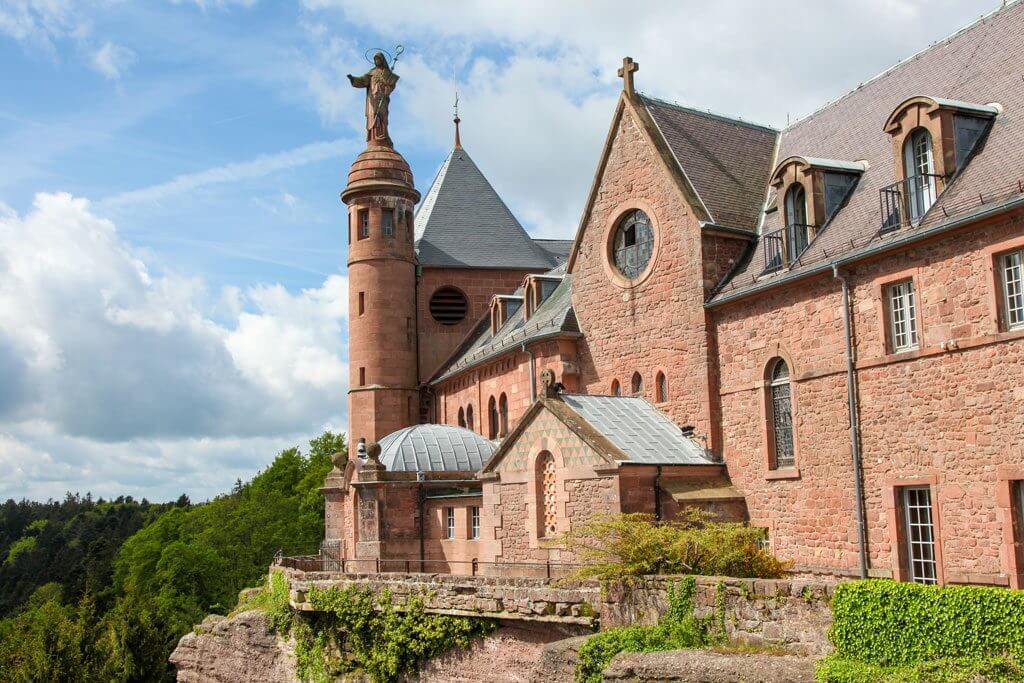
After visiting the Château, drive to Mont Saint-Odile , in the heart of the Vosges. The mountain (764 m) is named after Saint-Odile, the Saint Patron of Alsace, and it has a monastery/convent, the Abbey of Hohenburg .
Drive to the summit of Mont Sainte-Odile to take in the views (and perhaps a little prayer). You can also visit some parts of the monastery. Before leaving, make sure to check out the Pagan Wall , a series of stone fortifications built in 1000 BC.
After visiting Mont Sainte-Odile, drive to Strasbourg, the last stop of this Alsace road trip. In Strasbourg, book two nights at the Hotel Cathédrale , located just opposite Notre Dame de Strasbourg. Some rooms come with incredible and spectacular views over the Cathedral.
Click here to book your stay at Hotel Cathédrale
Days 6 -7 | Strasbourg
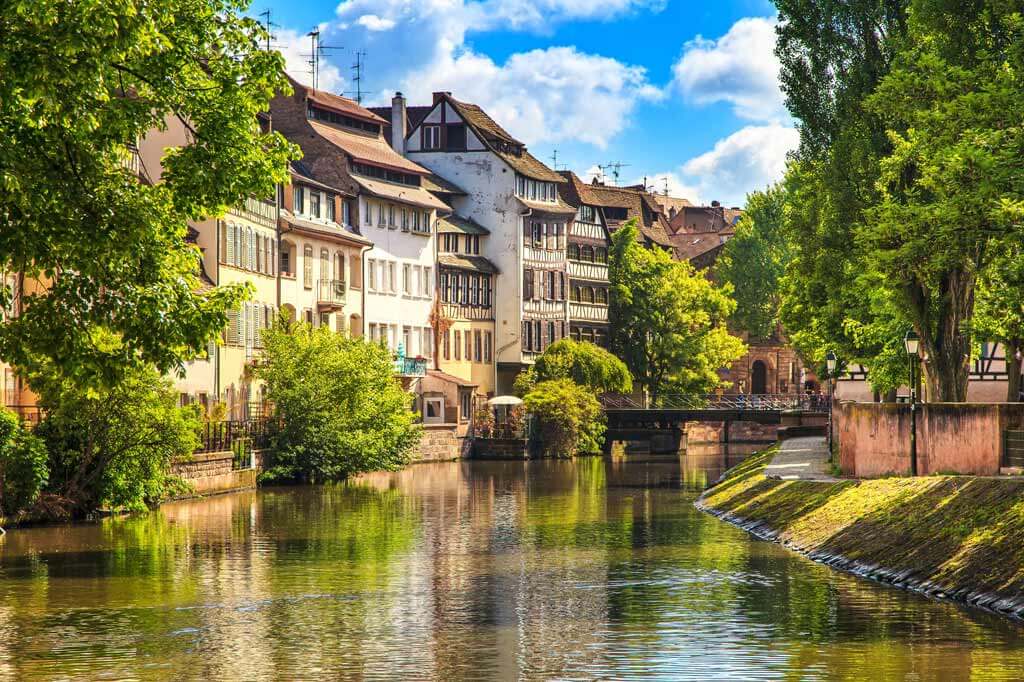
Days 6 and 7 of this Alsace itinerary explore the city of Strasbourg, so you won’t need the car.
Strasbourg , the capital of Alsace, is also known as the Capital of Europe because of both its central location and it plays host to more than 20 European institutions. Strasbourg has an immense historical and architectural heritage, making it the wealthiest city in Alsace. Its city center, developed on the River Ill banks, not far from the Rhine River, is inscribed on the UNESCO World Heritage list.
If you are visiting Strasbourg for the first time, we recommend this Strasbourg itinerary for 2 days which covers the main sights and comes with some good tips.
The list of fun things to see and do in Strasbourg includes:
- Notre Dame Cathedral
- The Petite-France, a picturesque district
- The covered bridges and the barrage Vauban
- Strasbourg river cruise
- History Museum
- The European neighborhood
So, what are you waiting for? Book your Alsace road trip today!
Click here for other Road Trips
Back to Homepage
Disclaimer: This article may contain compensated links, meaning we get a small commission if you make a purchase through our links. It costs you nothing more (in fact, if anything, you’ll get a nice discount) but helps us to go on creating incredible French content for you. We trust all products and brands promoted here and would never recommend anything that isn’t of value. Please read disclaimer for more info.
(C) Copyright 2019 - 2024 France Bucket List. All Rights Reserved. Designed & Developed by France Bucket List || Disclaimer || Privacy Policy || Contact |

THE 10 BEST Alsace Private Tours
Private tours in alsace.
- Historical & Heritage Tours
- Cultural Tours
- Wine Tours & Tastings
- Private Tours
- Up to 1 hour
- 1 to 4 hours
- 4 hours to 1 day
- 5.0 of 5 bubbles
- 4.0 of 5 bubbles & up
- 3.0 of 5 bubbles & up
- 2.0 of 5 bubbles & up
- Chinese (Simplified)
- Likely to Sell Out
- Special Offers
- The ranking of tours, activities, and experiences available on Tripadvisor is determined by several factors including the revenue generated by Tripadvisor from these bookings, the frequency of user clicks, and the volume and quality of customer reviews. Occasionally, newly listed offerings may be prioritized and appear higher in the list. The specific placement of these new listings may vary.

1. On tour with a friend and his luxury van

2. Private and customizable: Alsace Wine Route HIGHLIGHTS in 3 hours

3. "Le petit Alsacien" Tour with Local private friendly driver and a Tesla

4. Strasbourg Private Walking Tour

5. Fantastic, full day, private wine tour to Alsace!

6. Strasbourg : Private Custom Walking Tour With A Local guide

7. Selfguided and interactive tour of Strasbourg

8. BOAT ALSACE Visit Strasbourg in a private boat + Captain

9. Colmar, Kaysersberg, Riquewhir: Private excursion from Strasbourg

10. Strasbourg Like a Local Customized Private Guided Walking Tour

11. Guided Tours of Strasbourg Cathedral

12. Germany Freiburg & Black Forest Private Day Trip from Strasbourg

13. Alsace Tour : Wine Tasting, Villages & Castle Visits with friendly Tesla driver

14. Alsace 4 Wonders Private Full Day Trip

15. Germany Baden-Baden & Black Forest Private Day Trip from Strasbourg

16. Strasbourg : Hidden Gems and Untold Stories

17. Private Strasbourg Traditional Food Walking Tour

18. Great Sparkling tour: the Crémant experience

19. Strasbourg Private Food Tour: experience the city like a local!

20. Struthof Concentration Camp

21. Alsace Private Tailored Tour in a Tesla with a Local

22. electric bike rental 4 hours

23. Self-Guided and Interactive City Tour - Colmar

24. Private Tour: Alsace Wine Tasting Day Trip from Colmar

25. Private Tour: Picturesque Alsatian Villages & Wine Tasting with a local expert

26. Pinot Noir & Pinot Wine Tour to Baden-Württemberg

27. Colmar Private Walking Tour With A Professional Guide

28. Alsace Christmas Markets & Fairy Tale Villages Private Tour from Strasbourg

29. Through Alsace Vineyards and Wine Villages Private Bike Tour

30. MY*GUiDE In&Around BLACK FOREST Unique & Exclusive 3-Country-Tour from Munich
What travelers are saying.
- On tour with a friend and his luxury van
- Strasbourg Private Walking Tour
- Strasbourg Like a Local Customized Private Guided Walking Tour
- BOAT ALSACE Visit Strasbourg in a private boat + Captain
- Alsace 4 Wonders Private Full Day Trip
- Happy Strasbourg
- Alsace Bateau Privatisé
- Strasburg-Tours
- LocalBini - Your Platform to Experience Strasbourg through the Eyes of Locals
- Steph-On-Tour
- Sites and Monuments in Paris
- Sites and Monuments in France
- Things to do in Paris
- Things to do in France
- ACCOMMODATION
- RENTING A CAR
- CHEF SERVICE
- CONCIERGERIE SERVICES
- TRAVEL TIPS
- TRAVEL LUGGAGE
- Arrondissements
- Monuments & Landmarks
- Secret & Offbeat Paris
- More about Paris...
- Île de France
- More Regions of France...
- Aix-en-Provence
- More Cities...
- Castles and Palaces
- Cathedrals and Churches
- Gardens and Parks
- World Heritage Sites
- Villages of France
- Autumn / Fall
- Mardi-Gras / Carnival
- April Fools' Day
- Bastille Day
- All Saints' Day
- More Holidays and Celebrations...
- National Anthem
- Gallic Rooster
- National Day
- Motto of France
- Motto of Paris
- Coat of Arms
- French President
- Le Croissant
- French Cheese
- French Wines
- Christmas Food and Recipes
- French Nursery Rhymes
- France geography
- FUN QUIZZES
- MOVIES AND MUSIC
- FRENCH LANGUAGE
- BOOKS BY FRENCH MOMENTS
- BOOK RECOMMENDATIONS
- The Secrets of the Eiffel Tower
- The Gems of Paris
- Office desks and chairs
- Travel suitcases
- LEARN FRENCH WITH PIERRE
- THE STORY SO FAR
- WORK WITH US
- THE NEWSLETTER
- HOW TO SUPPORT US
- PHOTO USAGE POLICY
What you need to know about the Alsace Region
Last Updated: 8 February 2022
The Alsace region is located in north-eastern France and is famous for its wine, its colourful half-timbered houses and its castles which sit enthroned on the summits of the Vosges mountains. Since the 1st January 2016 the administrative region of Alsace has been part of the new Grand Est region along with Lorraine and Champagne-Ardenne.
About the Alsace region
The capital Strasbourg is home to one of France’s most beautiful Gothic cathedral , a pedestrian old town centre, and the country’s premier Christmas Market . It is also where the European MPs meet at the European Parliament.
South of Strasbourg is another major touristic town: Colmar . From there you can easily journey through the Route des Crêtes of the Vosges and the Wine Route .
The Alsace vineyards extend across the hills of the Vosges at between 200 and 400 metres high, over some 14,000 hectares of grapevines which produce an average of 150 million bottles of wine. Benefiting from local microclimates, the Alsatian vineyards are bordered to the West by the natural barrier of the Vosges, and to the East by the Rhine Plain which has its own large natural border: the Black Forest in Germany.
The Alsace region is also known for the richness of its gastronomy. The Kugelhopf is an emblematic Alsatian dessert. Other specialities from Alsace include sauerkraut ( choucroute ), tarte flambée, or Christmas cookies locally known as Bredalas .
To the south of the region lies the city of Mulhouse and the rural land of the Sundgau which reaches the Swiss border in the Jura mountains.
Easily accessible by TGV from Paris or Lyon, Alsace is definitively a region worth a visit… should it be for the sight of its emblematic bird: the white stork!
- Name: Alsace, part of the Grand-Est region
- Surface: 8,280 km2
- Départements: Bas-Rhin (67), Haut-Rhin (68)
- Administrative capital: Strasbourg
- Population: 1,851,443 (2010)
- Main cities: Strasbourg , Mulhouse , Colmar
- Celebrities: Frédéric Auguste Bartholdi, Alfred Dreyfus, Hansi, Sébastien Loeb, Albert Schweitzer
- Cheese: munster
- Tradition dish: sauerkraut (choucroute)
- Our favourite place: Kaysersberg
History of the Alsace region
The Alsace region’s touristic appeal is closely linked to its rich history.
The region was originally populated by Celtic tribes who founded Argentorate (now Strasbourg) towards the end of the 3rd century BC. In 58 BC, Julius Caesar’s troops conquered the region and brought with them the Roman culture, built roads and imported vines.
During the 4th century, the power of Rome was reduced due to incursions by the Barbarians. The Alemanni tribes drove out the Romans and established themselves in the Upper Rhine.
In 496 at the Battle of Tolbiac , Alsace came under the authority of Clovis , recently converted to Christianity.
In the Middle Ages , the fate of Alsace lay in the Germanic world as the province had been an integral part of the Holy Roman Empire since 962. Several seignories appeared with powerful dynasties at their head: the Habsburgs in Upper Alsace, the Ribeaupierres (or Rappolstein) in Central Alsace and the Lichtenbergs in Lower Alsace.
In addition to these three dynasties, the region was divided up into many territories meshed with each other, operating under the authority of little lords, laymen or clergymen. This situation was accelerated by the reduction of imperial power and the increasing wealth of the urban bourgeoisie. In the 13th century, a movement of emancipation by the Alsatians developed. In the prosperous city of Strasbourg, the bourgeoisie took over the local authority of the bishop. In 1354, an alliance of ten prosperous merchant towns of Alsace, the Décapole , was agreed upon, with imperial protection.
Meanwhile, the Habsburg dynasty, fervently catholic, controlled a vast territory in southern Alsace (the Sundgau ), in Breisgau, in today’s northern Switzerland and in Vorarlberg, known as Anterior Austria (Vorderösterreich).
The Reformation reached the Alsatian Province leading to the conversion of Strasbourg and Mulhouse to Protestantism.
The Thirty Years’ War erupted in 1618 following extreme tension between the catholic Emperor (a Habsburg) and influential protestant princes. It was further complicated by the intervention of France, which had long been hostile to the European ambitions of the Habsburgs.
Eventually, the king of France forced the Habsburgs to surrender Alsace to him, which they did by withdrawing from the other side of the Rhine.
On 24 October 1648, the Habsburgs signed the Treaty of Westphalia , providing for the transfer of Alsace to France.
From that time the Alsace region was ruled by France and remained under its national colours until 1871.
During the French Revolution (1789), Alsace was administratively reorganised into two départements: the Bas-Rhin to the north and the Haut-Rhin to the south, with their respective administrative centres of Strasbourg and Colmar .
The Franco-Prussian war in 1870-1871 ended with the surrender of the French army and the annexation of the province (less Belfort) and the Moselle département in Lorraine to the newly created German Reich.
In the aftermath of the First World War, Alsace returned to republican France.
Paradoxically, the joining of Alsace to France posed several problems, especially in terms of adjustment. Many Alsatians campaigned to obtain some recognition of their local status concerning local administration and dialect. Cultural life was in part suppressed by linguistic pressure from French authorities confronted by regional culture.
In August 1940 , an armistice treaty was signed between Germany and defeated France. In order to “Germanise” Alsace, the occupiers needed to resort to drastic measures. The Alsatian people were considered German citizens (Volkdeutsche), the use of French was banned and was a punishable offence and German became the obligatory language once again, with street names being translated and displayed in German. Young men of Alsace faced compulsory conscription to the German army. And since they could not really be trusted, Nazi command sent them to the Russian frontline, from where few of them returned safe and sound. This tragic wartime episode gave them the name “ les Malgré-Nous ” (“in spite of our will”).
The liberation of the province was a story of long-suffering. The Allied bombings of the “ Pocket of Colmar ” during the 1944-1945 winter of 1944-1945 destroyed several villages.
While Strasbourg was liberated on 23 November 1944 by Leclerc, the last German troops to surrender in Alsace took place on 20 March 1945.
Alsace had changed hands four times within 75 years between France and Germany.
The end of the Second World War signalled that it was time for the reconstruction and reconciliation of the peoples of Europe.
In 1949 , ten European States (Belgium, Denmark, France, Ireland, Italy, Luxembourg, Norway, the Netherlands, the United Kingdom and Sweden) founded the Council of Europe and based it in Strasbourg. The capital of Alsace is currently the seat of more than a dozen institutions and organisations, both European and international, including the European Parliament and the European Council of Human Rights.
Geography of the Alsace region
Topography of alsace.
The Alsace region covers an area of 8,280 km2 (190 km long by 50 km width) which represents 1.5% of the total area of France. Being the smallest administrative region of continental France, Alsace stretches from south to north along the Rhine which borders its east flank.
The Alsace region is bordered by the German Lander of Rhineland-Palatinate to the north and to the east, across the Rhine, by the Lander of Baden-Württemberg. To the south, the Jura mountains mark the border with Switzerland from Basle to the vicinity of Porrentruy. In the South-West, the Gate of Burgundy opens Alsace to Franche-Comté, while the crest of the Vosges mountains serves as a natural border with Lorraine.
The landscape of the Alsace region is made up of mountains, hills and plains:
- the plain of Alsace where the Ill River flows from the Jura mountains to the north of Strasbourg where it joins the Rhine is dedicated to cereal production. A few important forests are also found here: the Haguenau forest to the North and the Hardt to the South near Mulhouse.
- to the West, the Vosges mountains are cut into by large valleys where tributary rivers of the Rhine flow: the Doller, Thur, Lauch, Fecht, Weiss, Liepvre, and Bruche. The culminating point is the Grand Ballon (1,424 m). Forests alternate with high pastures (Hautes Chaumes). The Vosges foothills (collines sous-vosgiennes) mark the transition between the High Vosges and the plain. Also called Piémont Vosgien, this area is covered with the Alsatian vineyards, stretching from Thann to Wissembourg.
- to the North-West, the hilly Alsace Bossue (Hunchbacked Alsace) is located where the Lorraine plateau meets the mountains of the northern Vosges.
- to the South of Mulhouse, the rural Sundgau has its own distinctive geographic character. The hills are followed by the foothills of the Jura mountains in the extreme South. This is where the Ill River starts its course.
The climate of the Alsace region
Alsace has two distinct climatic regions: mountainous in the Vosges and semi-continental on the plain.
Temperatures can range between extremes of 40°C and -30°C but annual extremes of 25/30°C and -5°/-10°C are much more frequent (30°/40°C difference).
- Record high temperature: 40.9°C on the plain on 13 August 2003.
- Record low temperature: -30.2°C at the Grand Ballon (1,424 m) on 10 February 1956.
The topography of Alsace, the Vosges and the Black Forest in Germany all play a major role in the local climate.
From Colmar, next to the foothills and at the base of the Vosges mountains, clouds arriving from the West are forced to rise and fall as precipitation over the high summits, hence protecting the lower area from rain. With an annual recorded rainfall of 530mm, Colmar and its region take advantage of one of France’s driest climates, making it ideal for vines to grow on the southern slopes.
The emblematic fauna of Alsace
Alsace is home to a variety of European wildlife: lynx, chamois, reptiles, birds, badger, roe deer, wild boar, bald and mountain cows. A few of them, mostly found in the Vosges, has become emblematic in the region:
This feline was reintroduced to the Vosges in 1983 after nearly two centuries of absence. Today, the mountain range provides a habitat for about 30 lynxes. The lynx is hard to see as it is a nocturnal and lonesome hunter. It is recognisable with its brown-spotted fur and the black brushes of hair on its ears.
The chamois
This bovid was reintroduced to Alsace in 1938. There is now a population of about 900 chamois in the Vosges, particularly in the high ridges of the valley of Munster above 800 metres.
Protected in Italy since 1976, the grey wolf has since entered France by the Maritime Alps At least 50 wolves were discovered in the French Alps in 2000. In 2011, it was confirmed that wolves had reached the Vosges. The last wolf sighting in France prior to their reappearance dates back to the 1930s.
The white stork
The friendly white storks , the iconic emblem of Alsace, are found in large numbers throughout the region. However, this has not always been the case. To the distress of the Alsatian population, the white bird almost disappeared from Alsace in the 1970s (only nine pairs were alive in the Upper Rhine region) but thanks to a conservation programme, storks were reintroduced in Alsace and their numbers now exceed 270 pairs. White storks are one of the region’s most beloved symbols and for many centuries they return every year from Africa to announce the coming of spring in France.
The administration of the Alsace region
Until the 1st January 2016, when it was integrated into the Grand-Est region, Alsace is the smallest region of metropolitan France. The cultural and historical Alsace region is divided into two départements:
- Département code: 67
- Préfecture: Strasbourg
- Sous-préfectures: Haguenau, Molsheim, Saverne, Sélestat , Wissembourg.
- Number of communes: 527
- Surface: 4,755 km2
- Population: 1,094,439 (2009)
- Département code: 68
- Préfecture: Colmar
- Sous-préfectures: Altkirch, Guebwiller, Mulhouse , Ribeauvillé , Thann .
- Number of communes: 377
- Surface: 3,525 km2
- Population: 748,614 (2009)
Alsace’s main cities
The population of Alsace’s main agglomérations *:
- Strasbourg (Bas-Rhin): 450,375
- Mulhouse (Haut-Rhin): 243,340
- Colmar (Haut-Rhin): 91,700
- Haguenau (Bas-Rhin): 59,100
- Saint-Louis (Haut-Rhin): 50,000
“ Agglomérations ” in France are contiguously built-up areas in France, also called “ unité urbaines ”. The agglomération of Strasbourg comprises 485,000 inhabitants when the German city of Kehl Am Rhein is included. Saint-Louis and suburbs form part of the Basel agglomération in Switzerland which comprises 830,000 inhabitants in Swiss and German towns.
The economy of the Alsace region
Even though Alsace is situated 400 km from the centre of Paris on France’s eastern border, it enjoys an enviable central position in Western Europe. The Upper Rhine region of which Alsace is part is located at the heart of the European Megalopolis which stretches from Liverpool to Geneva. Taking the shape of a crescent, this “ blue banana ” is a continuous corridor of urbanisation with a population of 110 million which adds up three-quarters of the EU’s purchasing power.
The commercial partners of Alsace
Alsace is the first export region of France based on the export value per inhabitant.
The principal commercial partners of Alsace are:
- Germany (29.4%),
- The Netherlands (8.9%),
- Italy (8.7%),
- The United Kingdom (6.5%),
- Spain (5.5%), and
- Switzerland (5.3%).
35% of the companies based in Alsace deal with foreign trading partners (mostly German, Swiss, American, Japanese and Scandinavian). Germany represented almost 38.5% of Alsatian imports in 2002.
Alsace is a prosperous region, ranking third in France after Ile-de-France and Rhône-Alpes.
The region has one of France’s lowest unemployment rates (8.4% in 2011). This is due to its position on the border with Germany and Switzerland allowing many workers (approximately 70,000) to cross the border where salaries are generally higher, particularly in Switzerland.
The primary sector
The agricultural area in Alsace is not as extensive as in neighbouring Lorraine due to the prominence of urban zones (Strasbourg, Colmar and Mulhouse) and of forests (Hardt, Haguenau and Vosges). However, because of its concentration in wine-growing, and tobacco, hop, hemp and sauerkraut cabbage production, agriculture in Alsace is reputed to be high value-added.
The manufacturing sector
The alsatian industry has been facing diversification, particularly since 2004 when many potassium mines ( Mines de potasse d’Alsace or MDPA) were closed for good.
Deep restructuring has affected main activities such as car manufacturing (Peugeot is the region’s first employer with an important site in Mulhouse).
The food-processing industry is very strong in Alsace with:
- beer brewing (half the French beer is produced in Alsace, especially near Strasbourg with sites in Schiltigheim, Obernai and Hochfelden. Alsace’s favourite beer is Kronenbourg.
- chocolate and confectionery (Masterfood in Haguenau and Steinbourg, Kraft Suchard in Strasbourg, Chocolat Schaal in Geispolsheim).
- industrial cooked meats (Stoeffler, Pierre Schmidt, Iller, Tempe, Maurer,…)
- sugar refining (Erstein Sugar)
The service sector
As in most French regions, the service sector is growing rapidly at the expense of the two first sectors. The first sector, according to its importance, is tourism (6% of the Alsatian GDP). It is estimated that 28,000 jobs are generated by tourism in Alsace, which represents 3.5% of the regional workforce in summer. However, because of its small size compared to the average French region, Alsace ranks 20th for the number of tourists who spend at least one night in the region (11.7 million in 2011).
Gastronomy & Wines of Alsace
Traditional dishes.
Alsatian gastronomy shares important features with Germanic cuisine. The traditional Alsatian dishes can also be found – with minor differences – in neighbouring German, Swiss and Austrian regions: baeckeoffe, bretzel, flammekueche (tarte flambée), sauerkraut (choucroute garnie), fleischnacka, fried carp (carpe frite).
Foie Gras is another speciality of Alsace, particularly from Strasbourg where it has been prepared since the 17th century.
In the Vosges mountains , many farmhouses ( fermes-auberges ) serve an authentic traditional farm meal called “ marcaire ” which features pie as a first course and roïgabrageldi (potatoes with smoked pork shoulder) as a main.
Alsace boasts an abundant range of desserts: kugelhopf (kougelhof or kouglof), apple and damson plum tarts, fromages blancs, gingerbread, as well as bredelas, an infinity of biscuits and small cakes prepared for Christmas.
Alsace’s most famous cheese is munster or munster-Géromé which takes its name from the little town of Munster, located in the Fecht Valley in the Vosges. This cow’s milk cheese with a soft pâte and a washed rind received the ‘ appellation d’origine contrôlée ’ label in 1969. Munster is still being made on either side of the Vosges mountains in Alsace and in Lorraine .
Alsace Wines
Alsace vineyards extend across the hills of the Vosges and produce an average of 150 million bottles of wine each year: Riesling, Sylvaner, Gewurtztraminer, Pinot Blanc, Pinot Gris, Pinot Noir, and Muscat.
The local microclimate is favourable for the slow and prolonged ripening of grapes and the formation of grapes of great finesse.
In Alsace, the wines are mostly named after the variety of the grapes and not after the land on which they are produced. This originality, unique in France, undoubtedly contributes to their great notoriety.
The wines of Alsace (except for sparkling wine) are still sold in gracefully-shaped bottles, which are named “Alsace flûtes”. Since 1972, it has been compulsory for wine to be bottled in the region where it is produced.
The wines of Alsace are divided into three Appellations d’Origine Contrôlées (AOC): the AOC Alsace, The AOC Alsace Grand Cru, The AOC Crémant d’Alsace.
In addition to the AOC, the notes “Late Harvest” (Récoltes Tardives) and “Selection of Noble Grains” (Sélection des Grains Nobles) designate rare wines, which are most often the most mellow or syrupy.
Local Traditions of the Alsace region
Through the architecture, the dialect, and the cuisine, Alsace is undeniable of Germanic influence. This is due to the region had belonged to the Holy Roman Empire until the 17th century and also to the fact that the region has passed between German and French control four times between 1870 and 1945.
The Alsatian dialect
The Alsatian dialect is estimated to be spoken by a population of 400,000 to 700,000. Locally known as Elsässisch, it is an Alemannic dialect, part of the High German language.
The use of the Alsatian dialect has remained strong, particularly in rural areas. In the Sundgau, it is not unusual to find elderly people who can only converse in Alsatian. However, few young people speak the dialect today. Alsatian does not have official status in France and can only be offered as an optional language at school.
There are actually quite a few different versions of the Alsatian dialect between the Bas-Rhin and the Haut-Rhin départements.
It is common to see new official bilingual street signs in Alsatian cities and villages.
French is the most commonly spoken language in Alsace nowadays. Locals (even non-speakers of Alsatian) often express themselves with a distinctive German-sounding accent inherited from Alsatian. It is manifested by the tendency to lengthen the initial vowel of one and two-syllable words.
The position of Alsace within the Holy Roman Empire at the time of the Reformation complicated further the fragile political balance in the Upper Rhine region. Strasbourg officially became Protestant in 1532, along with Basel, Montbéliard, Mulhouse and Zurich to the south.
Strasbourg and the region of Wissembourg were the main bastions of Protestantism, while the rest of Alsace remained Catholic and loyal to the Habsburgs.
It is hard to make credible estimates of the numbers of Catholics and Protestants today as religious-based censuses are not tolerated in France. However, attendance at Protestant and Catholic services is reflected by the number of churches still open and which can still be visited throughout the region.
Traditional costume
The Alsatian costume as we know it today developed during the 18th century and is reminiscent of rural Alsace, of the region’s history and religious beliefs.
It also reflects the prosperity of Alsace with its rich material and bright colours.
There is not one but several types of Alsatian traditional costume. It can change from one village to another and some areas have their own characteristic costumes which may differ greatly, in particular in the Vosges mountains , the Sundgau and Alsace Bossue. The impressive black headdress of the woman’s costume has now become one of Alsace’s iconic trademarks. In the past, black was the colour for Protestants as the Catholics’ bow was decorated with patterns. When Alsace was annexed by Germany between 1870 and 1918, illustrators portrayed inaccurately the Alsatian costume which was adopted by the whole region, hence replacing the vast variety of traditional clothing that once existed.
The woman’s costume is made up of a white long-sleeved cotton shirt, trimmed with a narrow ruff and a slightly low neckline, a squared or rounded ruff, a black (Catholics) or green (Protestant) velvet skirt, a corselet in a precious material, a plain apron worn over the skirt and white stockings.
The woman wears the famous and decorative bow (la coiffe) made up of large ribbons and embroidered with silver and gold with sequins and motifs. The colour of the imposing headdress varies depending on the religious belief of the wearer: black for a young Protestant or married woman, red for a young Catholic maiden.
The man’s costume comprises a white long-sleeved cotton shirt with a soft collar, black trousers, a red gold-buttoned waistcoat and a black hat that has a moderate brim and a flat crown.
This traditional symbol of the Alsace region can often be admired at touristic and cultural events.
Traditional music and dance
Alsatian folk music is essentially orchestral and is closely linked to German, Swiss and particularly Austrian music, due to the history of the region.
During rural festivals, the typical Bloosmusik (music to “blow”) is played by a brass band made up of fifteen to thirty musicians (brass, accordion and percussions). Also nicknamed “oum-papa” music, it is accompanied by folk dances interpreted by dancers dressed in traditional costumes.
Local artefacts
Visitors in the Alsace region will bring back the following artefacts:
- pottery by Soufflenheim and Betschdorf: glazed and colourful utensils for the cooking of traditional recipes from Alsace (Baeckeoffe terrines, kougelhopf moulds);
- white wine, wine glasses;
- wood painting items (form trays to furnishings to canvas);
- stork soft toys;
- umbrellas with the design of the European flag (in Strasbourg);
- traditional linen cloths and napkins;
- Christmas decorations;
- Hansi-like postcards and posters.
Heritage and Main Sites of the Alsace region
Although not well-known to tourists the Alsace region is worth a visit for its numerous picturesque villages of half-timbered houses with geranium-filled window-boxes, Romanesque and Gothic churches and fortified castles. A clever mix of German and French cultures, this beautiful and enchanting area is home to many sights to discover:
The Alsace Wine Route
The scenic Alsace Wine Route is 170 kilometres long and was inaugurated in 1953. It crisscrosses through the Alsatian vineyards from north to south from Marlenheim to Thann .
Several cities and villages along the Alsace Wine Route have become famous and attract a very large crowd of visitors during the summer months and Christmas where they have beautiful Christmas Markets. These villages are gems of the wine country and often comprise old medieval ramparts, winding alleyways that bloom with magnificent geraniums, winstubs, half-timbered houses and medieval churches.
Many town names have become synonymous with rich traditions, friendliness, prosperity and great wines. These include Obernai , Dambach-la-Ville , Ribeauvillé , Riquewihr , Kaysersberg , and Eguisheim . Find out more about the Alsace Wine Route .
The Route des Crêtes of the Vosges
Sublime countryside, panoramic views extending to the distant Alps and riding on the hills, the Route des Crêtes in the Vosges is continuing the reputation of the Wine Route, a reputed and highly frequented tourist itinerary during the summer period.
The road follows a ridgeline route of 80km, linking the towns of Thann to Sainte-Marie-aux-Mines. Throughout its course, it is sometimes in Lorraine and sometimes in Alsace. Symbolically, the Route des Crêtes marks the border between Lorraine and Alsace, between the Romance and Germanic language worlds. At each mountainside, the road travels along bucolic countrysides, opening up views of mountain passes, rounded mountains, lakes, rocks, pastures and forests of majestic pines. Find out more about the Route des Crêtes des Vosges .
The Sundgau
Located between the Plain of Alsace, the Rhine River, the Vosges and the Jura mountains, the Sundgau region has its own distinctive geographic character. The hilly region is covered with pine, beech and oak woods, orchards, pastures, fields and ponds filled with carp, dotted with a multitude of wealthy villages. Like the rest of France, only the spire of the parish church signals the presence of colourful and elegant villages between two hills. Find out more about the Sundgau .
Churches and castles
In spite of consecutive wars between Germany and France which have severely affected Alsace, the region has been able to protect its rich heritage of churches and castles. Some of them have benefited from more recent renovations undertaken by the Conseil Général of Bas-Rhin or Haut-Rhin.
The touristic itinerary Route Romane d’Alsace (Romanesque Road of Alsace) links the region’s best examples of Romanesque architecture in Alsace.
Alsace’s most famous churches are:
- Romanesque: churches in Feldbach, Guebwiller, Kaysersberg , Marmoutier, Murbach, Neuwiller-les-Saverne, Ottmarsheim, Sélestat , Sigolsheim, Strasbourg , Wissembourg.
- Gothic: cathedral of Strasbourg , collegiates of Colmar and Thann , churches in Niederhaslach, Ribeauvillé , Rouffach , Sélestat , Strasbourg.
- Baroque: Altorf, Ebersmunster .
Alsace is one of the regions of France that has retained the most medieval castles . More than 500 are situated here, mostly distributed from north to south, in the foothills of the Vosges. Even if they are for the most part in ruins, their silhouettes, perched at the top of the Vosges Mountains, have been a part of the countryside for centuries, thus defying time. As in previous times, these castles still seem to dominate the Alsace Plain even today, watching over the Vosges valleys, communication channels and sometimes the abbeys.
Some castles still have a great reputation and are in good condition, with their imposing ruins evoking respect and admiration. This is especially true for the castles of Haut-Andlau, the Three castles of Ribeauvillé (Saint Ulrich, Girsberg, Haut-Ribeaupierre), Hohlandsbourg (overlooking Colmar), the Three castles of Éguisheim and Haut-Andlau.
The Haut-Kœnigsbourg castle is one of the most visited tourist locations in France, with nearly 500,000 visitors each year. Perched at 747 metres high, it dominates the Rhineland Plain, overlooking all the roads leading to Lorraine or crossing Alsace. It was greatly restored between 1901 to 1908 under the orders of Kaiser William II, a great admirer of medieval romanticism.
In the northern Vosges still stand the important ruins of a few castles: Falkenstein, Old Winstein, New Windstein, and Fleckenstein.
To the south of Alsace, three ruined castles can be visited: Ferrette, Landskron and Morimont.
Palaces were built by the influential Rohan dynasty in the 18th century on the plain: the château des Rohan in Saverne and the Palais Rohan in Strasbourg.
The Alsace region is home to some museums that enjoy great fame throughout Europe:
- The Musée d’Art Moderne et Contemporain de Strasbourg (MAMCS, Museum of Modern and Contemporary Art), Strasbourg.
- The Musée d’Unterlinden (Unterlinden Museum), Colmar.
- The Cité de l’Automobile (the National Automobile Museum), Mulhouse.
- The Musée français du chemin de fer (French national railway museum), Mulhouse.
- The Écomusée d’Alsace (Alsace Ecomuseum), Ungersheim.
Sites of Remembrance
Due to a rich but tormented history, there are places that evoke ancient traditions as well as sites that commemorate memories of a more recent past:
- The summits of the Vosges: Grand-Ballon , Ballon d’Alsace, Hohneck, Champs du Feu, Donon.
- The Mount St. Odile (the convent and the Pagan Wall) near Obernai.
- The Hartmannswillerkopf, also known as the Vieil Armand, trenches and national monuments of World War I above Cernay in the Vosges.
- The Natzweiler-Struthof, a former Nazi concentration camp in the Vosges near Schirmeck.
- The European District in Strasbourg, headquarters of several international institutions.
Our favourite place in the Alsace region
Several cities and villages along the Alsace Wine Route have since become famous and attract a very large crowd of visitors during the summer months and Christmas.
These gems of the wine country are often made up of old medieval ramparts, winding alleyways that bloom with magnificent geraniums, winstubs, vaults, half-timbered houses, and medieval churches.
Many town names have become synonymous with rich traditions, friendliness, prosperity and great wines. One of them has become over the years a favourite destination: Kaysersberg .
Kaysersberg , the “Mountain of the Emperor”, certainly deserves its prestigious name. A tourist hotspot, the little city houses some of the most beautiful half-timbered houses of the Renaissance in Alsace in its entirely pedestrian centre. The city of Kaysersberg and its viticulture are dominated by the castle ruins, which only consists now of a beautiful round tower. The view from its summit offers a panorama of the city, the valley of the Weiss, the vineyards and the Plain of Alsace, and beyond, the Black Forest in Germany. Find out more about Kaysersberg .
Have you visited the Alsace region of France? If so can you let us know which was/were your favourite spot(s)?
Check out the Tourist board of the Alsace region for more info: http://www.tourisme-alsace.com/en
PIN IT for later
Liked what you read? Pin it on Pinterest:
About the author
Pierre is a French/Australian who is passionate about France and its culture. He grew up in France and Germany and has also lived in Australia and England. He has a background teaching French, Economics and Current Affairs, and holds a Master of Translating and Interpreting English-French with the degree of Master of International Relations, and a degree of Economics and Management. Pierre is the author of Discovery Courses and books about France.
Like it? Leave a comment!
Your email address will not be published. Required fields are marked
Name * * * * * * * * * *
E-mail * * * * * * * * * *
Website [optional]
Save my name, email and website in the browser for my next comment.
This site uses Akismet to reduce spam. Learn how your comment data is processed .
Transparency: Some blog posts and pages may contain affiliate or sponsored links. If you are planning a trip, the use of these links helps us to run the site. There is no additional cost to you. All you have to do is click on the link and any booking you make is automatically tracked. Thank you for your support!
Escape to France with every email! Get insider insights, travel guides, cultural gems delivered and exclusive offers to your inbox twice a week. Your journey to Paris and France begins when you sign up!
SUBSCRIBE TO THE NEWSLETTER AND GET THE FREE EBOOK
24 PLACES TO SEE IN FRANCE
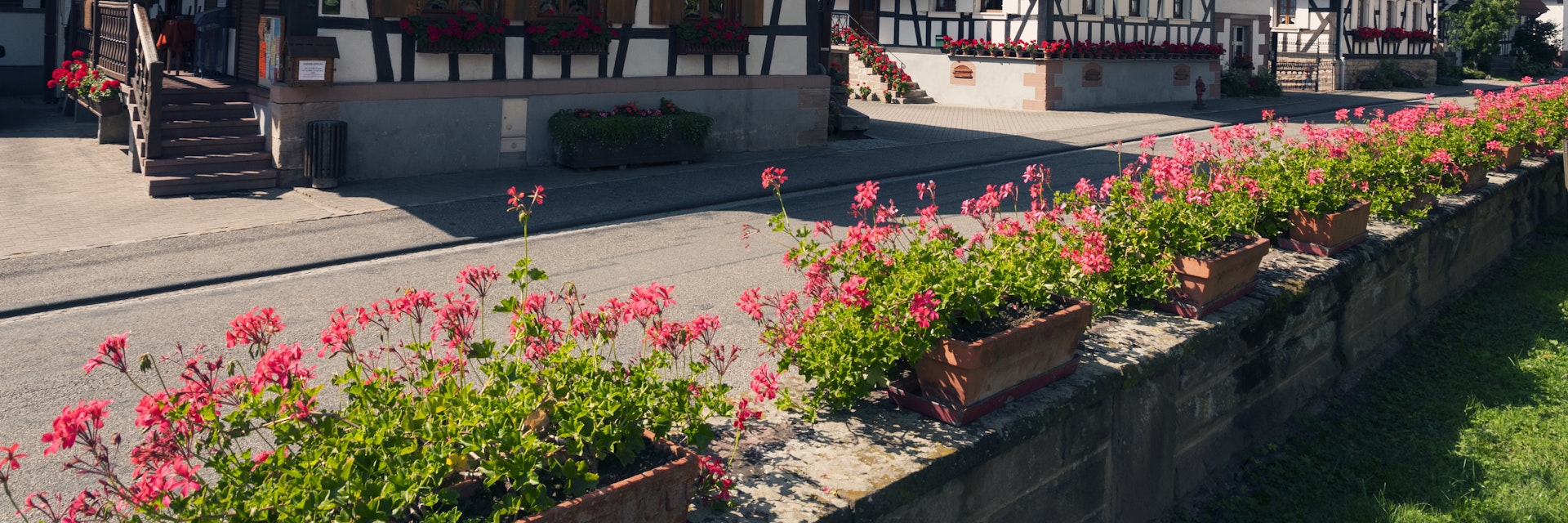
John Elk III/Getty Images
Ask the French what they think of Alsace and watch them grow misty-eyed with nostalgia and affection for this most idiosyncratic of regions, which borders Switzerland to the south and Germany to the east. So hard to nail in terms of its character, it proudly guards its own distinct identity, language, cuisine, history and architecture – part French, part German, 100% Alsatian. Here the candy-coloured towns and villages look as though they've popped up from a children's bedtime story, the gently rolling countryside, striped with vines, is nothing short of idyllic, and everywhere locals swear by centuries-old traditions.
Leave the planning to a local expert
Experience the real Alsace. Let a local expert handle the planning for you.
Attractions
Must-see attractions.
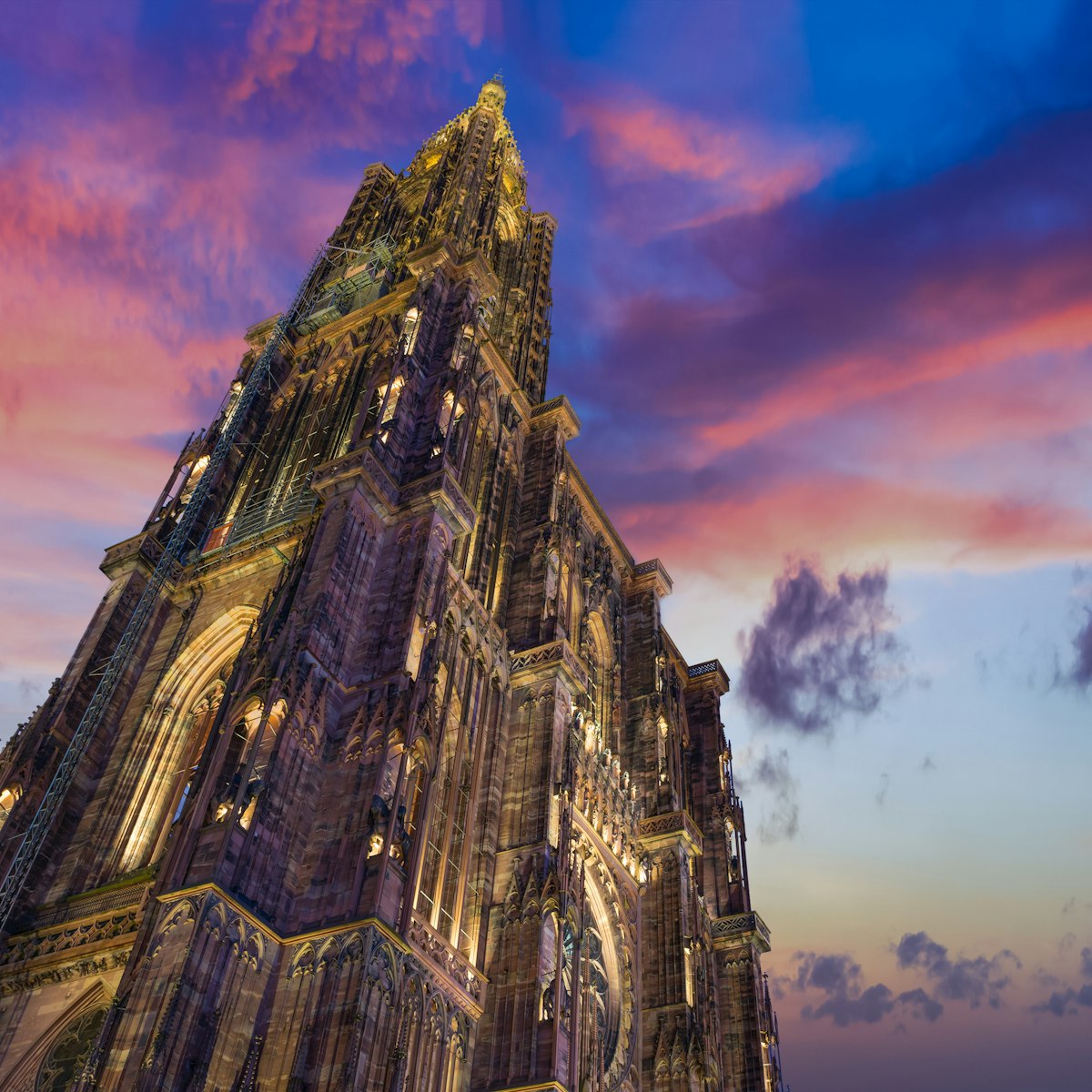
Cathédrale Notre-Dame
Nothing prepares you for your first glimpse of Strasbourg's Cathédrale Notre-Dame, completed in all its Gothic grandeur in 1439. The lace-fine facade…

Palais Rohan
Hailed as a ‘Versailles in miniature’, this opulent 18th-century residence is loaded with treasures. The basement Musée Archéologique takes you from the…

History seeps through the twisting lanes and cafe-rimmed plazas of Grande Île, Strasbourg's Unesco World Heritage–listed island bordered by the River Ill…

Musée d’Unterlinden
Gathered around a Gothic-style Dominican cloister, this revamped museum hides a prized medieval stone statue collection, late-15th-century prints by…

Cave de Ribeauvillé
France’s oldest winegrowers’ cooperative, which brings together 40 vintners, was founded in 1895. The huge, contemporary building contains a viniculture…
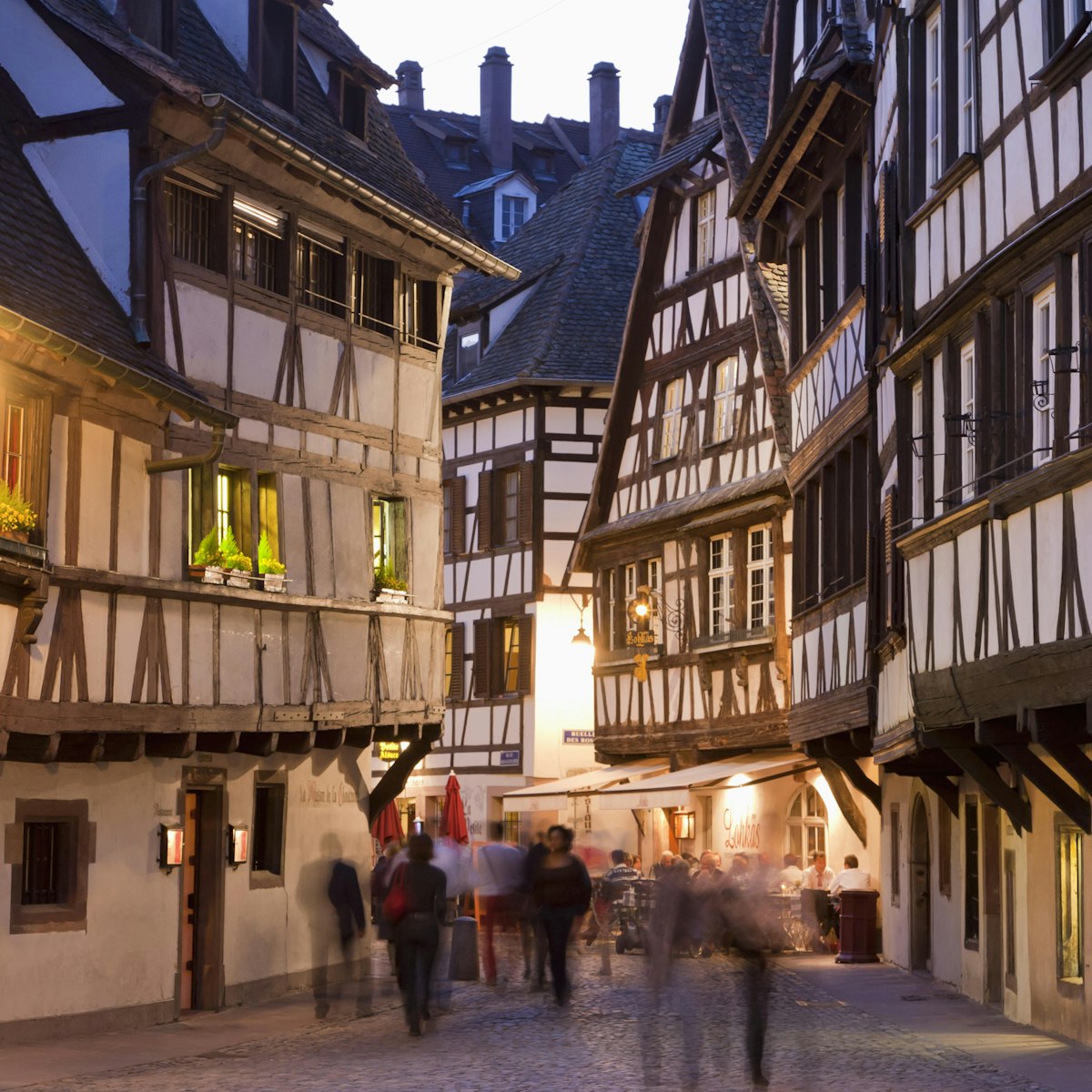
Petite France
Criss-crossed by narrow lanes, canals and locks, Petite France is where artisans plied their trades in the Middle Ages. The half-timbered houses,…
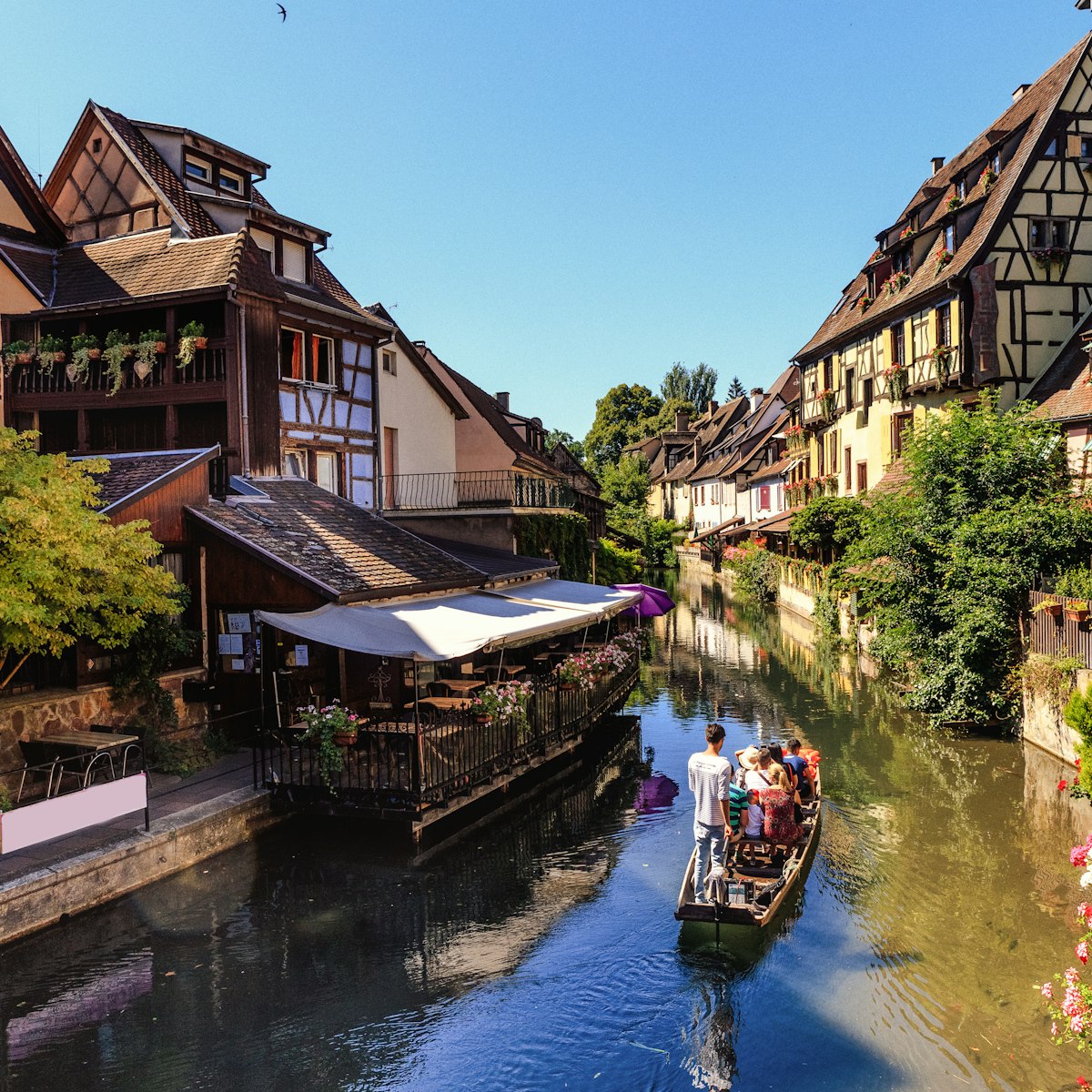
Petite Venise
If you see just one thing in Colmar, make it the Little Venice quarter. Canal connection aside, it doesn’t resemble Venice in the slightest, but it's…
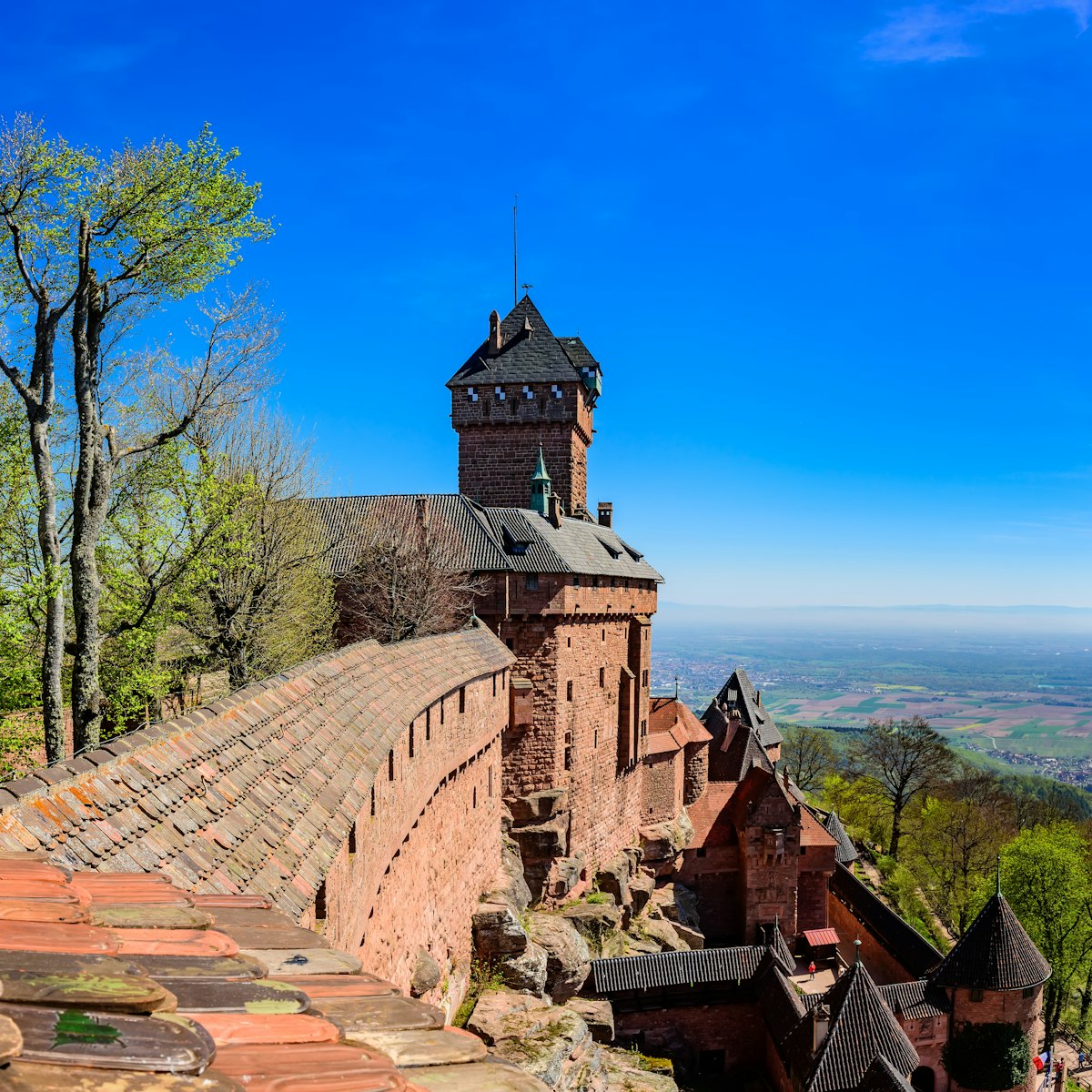
Château du Haut Kœnigsbourg
On its fairy-tale perch above vineyards and hills, the turreted red-sandstone Château du Haut Kœnigsbourg is worth a detour for the wraparound panorama…
Plan with a local
Experience the real France
Let a local expert craft your dream trip.

Latest stories from Alsace
Filter by interest:
- All Interests
- Adventure Travel
- Art & Culture
- Beaches, Coasts & Islands
- Food & Drink

Jul 3, 2020 • 2 min read
France's favorite village? It's an Alsatian town full of chocolate-box charm with black and white half-timbered houses and flower-decked windows and…
Purchase our award-winning guidebooks
Get to the heart of Alsace with one of our in-depth, award-winning guidebooks, covering maps, itineraries, and expert guidance.
Alsace and beyond
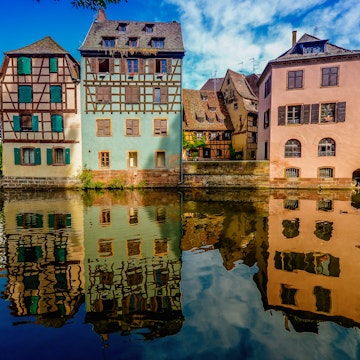
- Register | Login
Save on Summer! Use code SUMMER24 for $200 USD ($250 CAD) off trips starting June, July, & August 2024
Walking tours in Alsace
- Discover northern Alsace with its picture-perfect and multi-colored villages
- Extensive views over scenic landscapes dotted with medieval castle ruins
- Walk on undulating hills and meandering tracks through a sea of vineyards
- Explore the wooded slopes and clear lakes of the Vosges Mountains
- Relax on a sunny terrace with a large glass of local aromatic Riesling
- Mighty fortresses and preserved city walls evidence of Alsace's turbulent past
Alsace, which is located in the the north eastern part of France on the border of Germany is a real mix of both cultures, where Romanesque and Baroque villages combine with undulating landscapes to form one of its most scenic regions. The villages are truly mesmerizing with their bold colored half-timbered houses, car-free cobbled streets and historic centers. Walk on the wooded slopes of the Vosges Mountains and on vineyard tracks through wineries galore on our Alsace Wine Route tour.
Macs Adventure has created trips for you which highlight the best hand-picked accommodations and some of the best walks in the region. We have been sending guests to Alsace since 2012, so if you have a penchant for traveling to this very distinctive region of France, we can give you great tips and advice.
Perhaps you don't have long to linger and would therefore enjoy our Alsace Wine Route Short Break on which you walk from village to village. Stay in pretty Ribeauville and walk through Kayserberg, voted as "France's Favorite Village" in 2017. This area enjoys a unique microclimate and nearby Colmar is France's driest town. If you are lucky and walking on a clear day you will be able to see all the way to Germany's Black Forest. These tours are simply great for wine and history buffs. The wine here has been honed to perfection over several hundred years and evidence of its history over millennia is here for all to see, especially its ruined castles, many of which you will see on your daily hikes. So round up some friends or family and off you go!

Featured Tours - Alsace

Walking the Alsace Wine Route
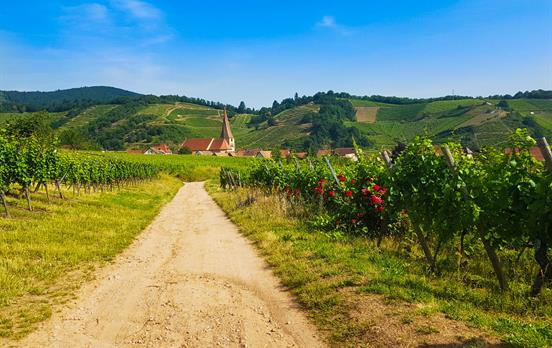
Alsace Wine Route Short Break
Discover alsace.
Alsace is so unique and distinctive as a French region that even those individuals familiar with French culture may believe they’ve mistakenly landed in Germany. This region ebbed and flowed between French and German control for centuries, changing hands five times since 1681. It is estimated as recently as 1918, only two per cent of the population spoke fluent French.
Evidence of this tumultuous history is not confined solely to the hilltop ruins and fortresses you may stroll past; Germany’s influence continues to form a living, breathing (and eating!) part of the Alsatian culture. Keep your eyes, ears and taste buds alert to the following signs.
Dialect While French remains the official language, listen carefully, and you’re bound to hear the guttural sounds of the Elsässisch (Alsatian) dialect, which is most similar to Swiss German. Even ‘Alsace’ is thought to come from the German word meaning ‘Foreign Domain’. Further evidence of German heritage is found in the bilingual street signs and in the evocative village names such as Eguisheim, Kayserberg and Riquewihr. Even ‘Alsace’ is thought to come from the German word meaning ‘Foreign Domain’.
Food and Drink Alsace deserves its spot on the map as one of the world’s most recognised winemaking regions, but lesser known is that Alsace is also France’s main beer-producing region. Alongside France’s passion for wine, you can raise a stein of frothing beer! The fusion of food you’ll find today owes much to the region’s chequered history. The German influence is seen in the ubiquity of pork, potatoes and cabbage. Be sure to taste some of the following dishes: Choucroute is Alsace’s take on the German favourite of Sauerkraut. In Alsace, the shredded, fermented cabbage includes juniper berries and is sometimes served with fish. Baeckeoffe is an overflowing casserole dish filled with potatoes, onions, three types of meat and Alsatian white wine. Flammekeuche , sometimes called Alsatian Pizza, was accidentally created by Germanic farmers; before baking their weekly bread, they’d test the oven temperature with a thin crust covered with crème fraîche, onions and lardons.
Architecture You’ve probably seen photos of the colourful houses of Alsace, which evoke childhood memories of fairy tales and the Brothers’ Grimm. Perhaps unsurprisingly, this half-timber construction is most commonly found in Germany. The layout of many Alsatian villages also testifies to their violent past and their the need for them to serve a defensive function. In Riquewihr and Bergheim, you’ll find fortified walls and city gates. In Eguisheim, rings of narrow streets encircle the town, with the houses themselves forming ramparts that would hinder any attack.

Alsace Traditional Dress
There is a Alsatian costume which was created during the 18th century and if you are lucky enough to be there during a local festival, then you can see these local costumes being worn. They do change from village to village, but if you can picture a woman wearing a black headdress with a long-sleeved, white frilly blouse and a black or green velvet skirt and a man wearing a white shirt with a red gold-buttoned waistcoat and a black hat then you are getting the idea!
Music and Dance
The folk music of this region is very closely associated with German, Swiss and especially Austrian music due to historic influences. It is nick-named "oum-papa" music and is accompanied by traditional folk dances with people dressed in the traditional costumes. (If you have seen the musical "Oliver" you will know what "oum-papa" music sounds like!)
The Alsace Wine Route
The Alsace Wine Route at 170km long was begun in 1953 and winds its way through the Alsatian vineyards from north to south. Part of the Macs Adventure walking tour has you walking along this famous wine route and the towns and villages that it winds through often have medieval ramparts, alleyways where colourful geraniums bloom, half-timbered houses, and ancient churches.
Medieval Castles
This region of France has retained most of its medieval castles with more than five-hundred of them that are located mainly in the foothills of the Vosges Mountains. They are mostly ruins, but their silhouettes perched against the backdrop of the mountains is really spectacular. They dominate the landscape and make you feel like you are back in medieval times. They were originally built by the very influential Rohan Dynasty.
Local Artwork
Two famous potteries are Soufflenheim and Betschdorf, who make colourful utensils for cooking traditional recipes such as terrines. Also famously made here are white wine glasses (not surprising!), linen cloths and napkins and Christmas decorations.

Follow us on social media
- twitter-x-logo@2x

All the things to see and to do in the region of Ribeauvillé and Riquewihr!

Entertain yourself
Plan your outings in the Ribeauvillé-Riquewihr region

Weekend of discovery, stay of several days, one week.... The region of Ribeauvillé and Riquewihr offers many accommodation possibilities

Treat yourself
Alsatian gastronomic specialities, local products, Grands Crus from the vineyard... the Ribeauvillé and Riquewihr region has good taste!

Follow us on Instagram

Outils d'accessibilité
- +49-170-4447872

- Guided Tours
- Sightseeing
- Self-Guided
See all tours
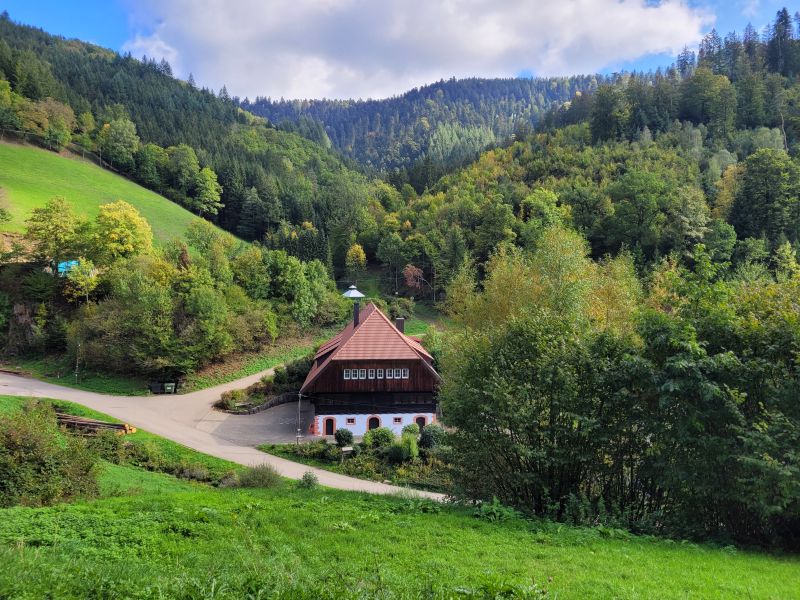
- Sightseeing Packages
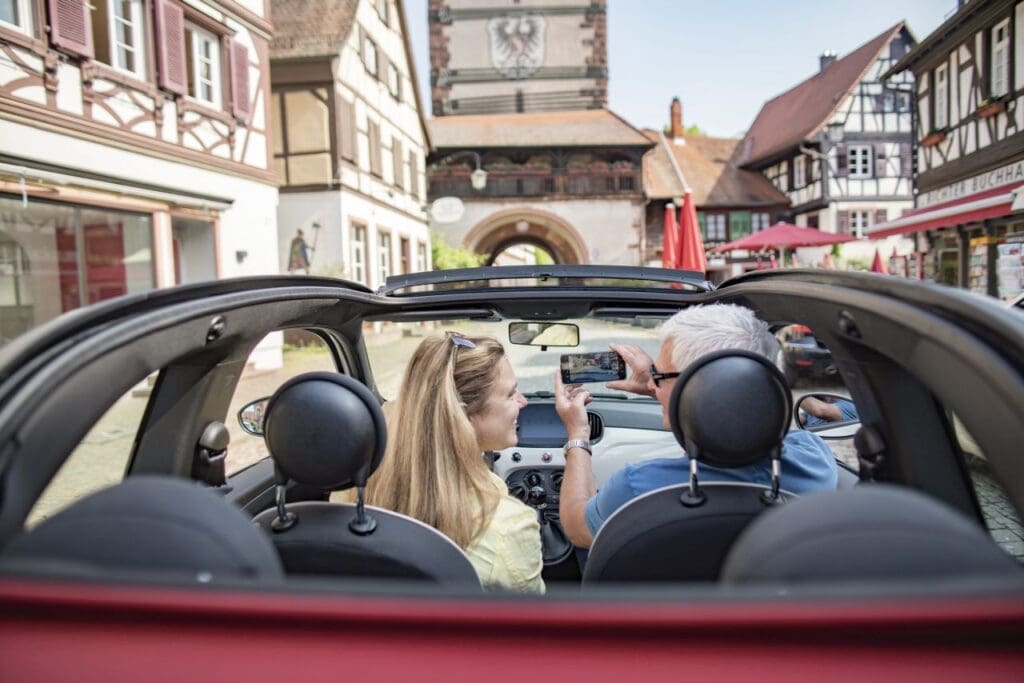
Self-Guided Tours
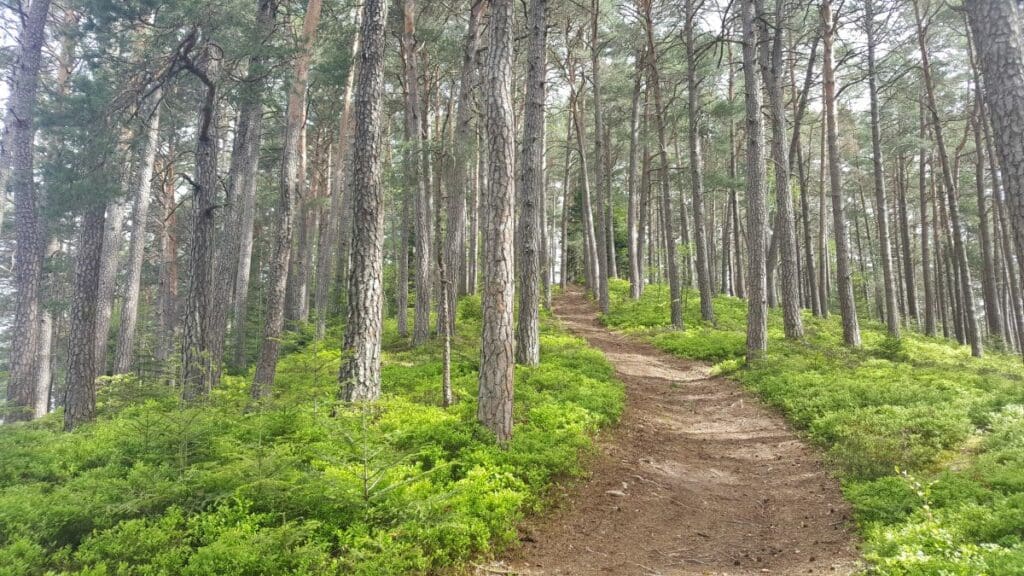
Guided Day Tours
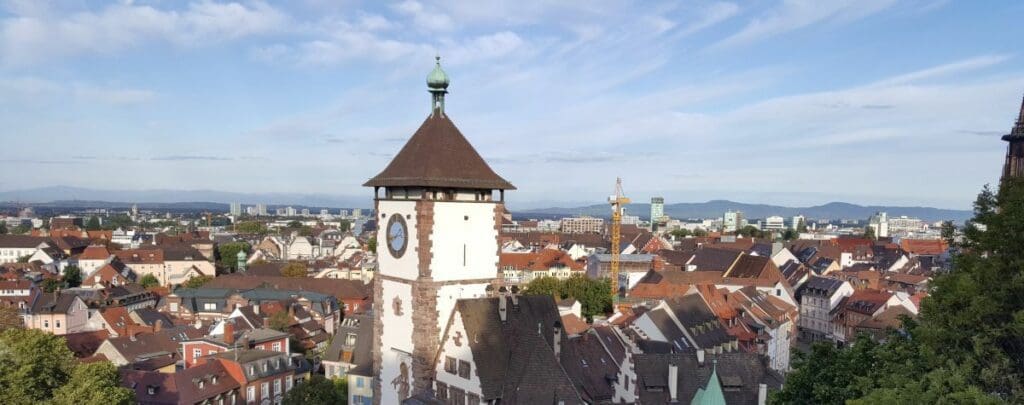
Culinary Tours
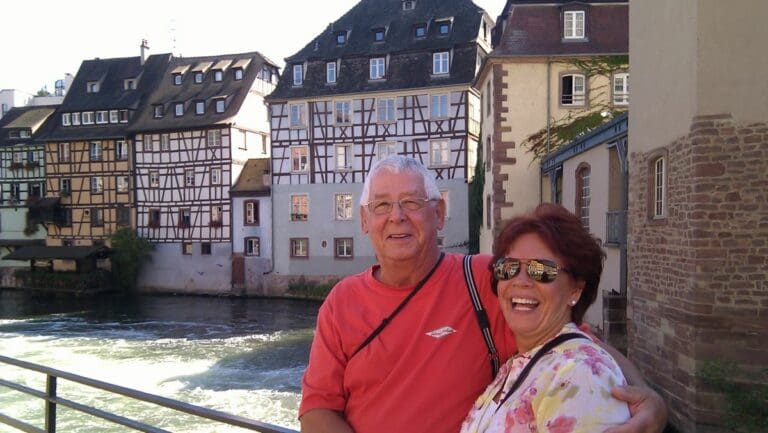
Black Forest & Alsace
Start / End
Transportation
good to know
Our Black Forest & Alsace Package is one of the richest cultural experiences you are going to find in one package. Its like salt & pepper. The contrasts between culture, food, wine and history between The Black Forest on the east side of the Rhine Valley and the Alsace region on the west side, could not be more pleasantly surprising. And they are only 30 minutes apart. Why not see it all? Its like two vacations in one!
- We Handle All The Details
- Luggage Transfer Included
- Hotels Included
- Tour with a private car/chauffeur
- Private tours in both locations
- 3 days / 4 nights – add on more days
If you are intrigued with the idea of seeing the Alsace region in France during your Black Forest vacation – this is the package for you!
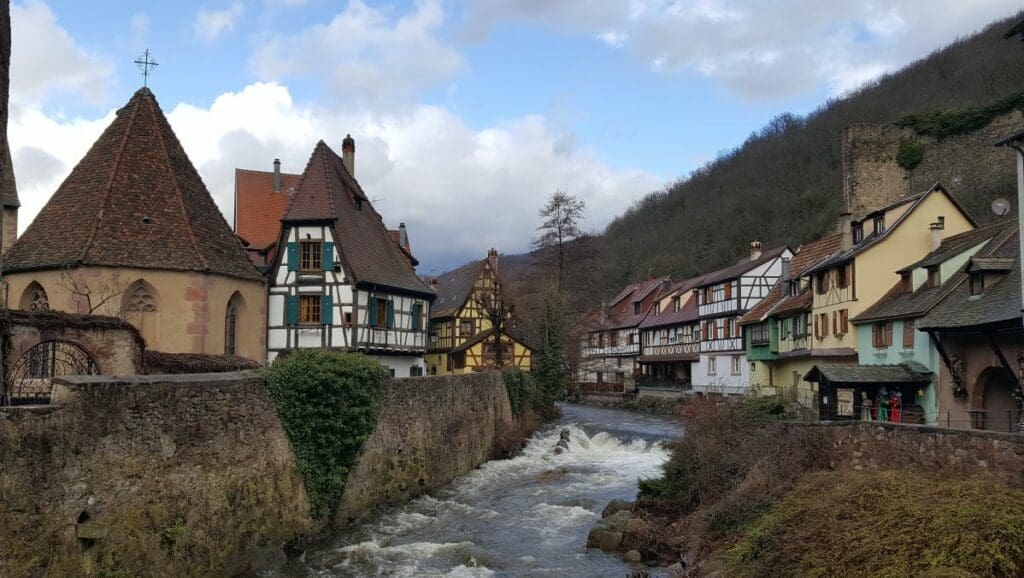
The Prettiest Towns in the World
We will set you up in cozy small hotels in two of the prettiest towns you are likely to ever visit. (we are not exaggerating, and we know you will agree) Each hotel in each town offers easy access to everything the towns have to offer – everything is within walking distance.
You’ll start your tour in The Black Forest in Germany, in a small hidden gem of a town we don’t advertise for reasons you will appreciate after the fact. We will depart our mystery town and make our way across the Rhine River to the Alsace, to the relatively well-known small city of Colmar, in Alsace, France. The Alsace is one of the most interesting regions in France. France has a lot to offer, but again, you’ll agree with us later.
During your first day in Colmar, our guide will take you around town on a private walking tour, so you have a solid orientation and you will know where things are located. Then you have the remaining day to explore on your own. Our guide will make sure that you blend in like a local. And then its on to the surrounding area. From here you can decide if you want to explore some of the cute (world renown) Alsatian towns near Colmar, do some wine-tasting or dive into the history of past wars – the options are endless.
Every corner of both towns offers picture-perfect scenery and rich history. Colmar’s history is unparalleled, having played central roles in the millennia of French-German history most people don’t know about, or the history you may be familiar with in both WWI and WWII. If you are a history buff, you are in for a real treat.
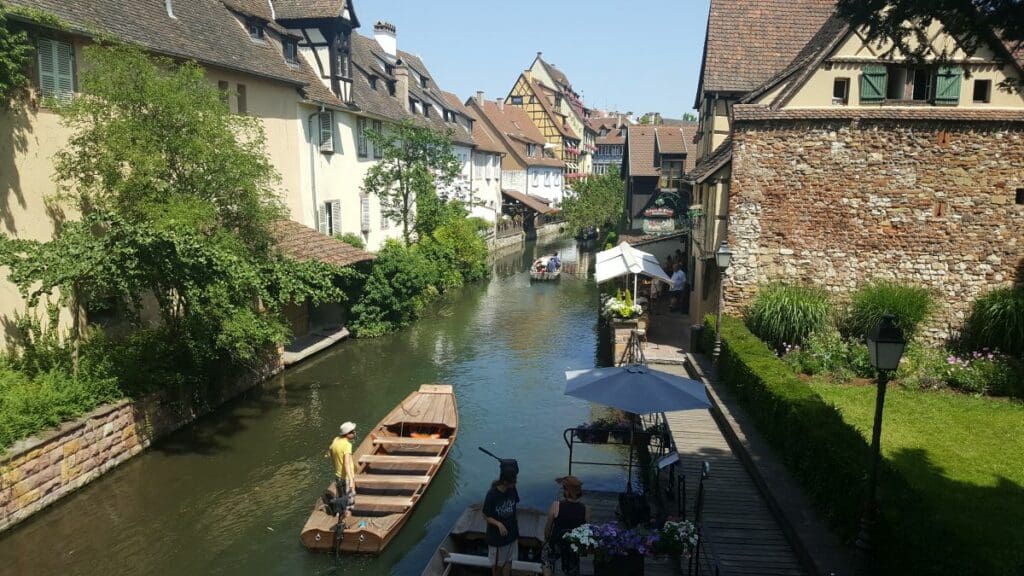
Food & Wine
Alsace is a food and wine paradise. There are numerous gourmet restaurants. If food and wine are your thing, we are happy to make a recommendation. And if you prefer to take it easy with Alsatian street-food (and French street food can claim 1st place in this category) we know exactly where to get it. And on top of all that, Alsatian wine is world renown. Even if you don’t like wine we recommend stopping at one of the many wineries to just quickly peak in and see what the talk is all about.
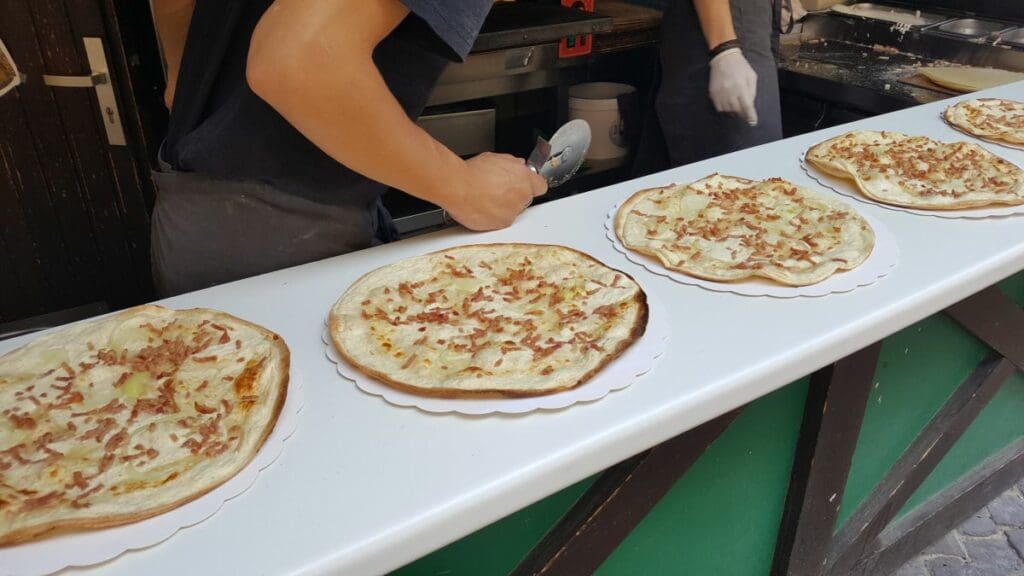
Is it for me?
Words do not do justice to the contrasts
richness of both history and food that the Alsace region has to offer – and its picture perfect on top of all that. You will return home with pictures and stories to tell – and you’ll want return one day.
Arrival Info
Arrive in the Black Forest by train.
Exploring Town
You start your vacation in a beautiful small Black Forest Town known for its beautiful timber-framed buildings. There are plenty of restaurants to choose from. And plenty of picture-perfect sights.
Upon arrival
Explore town. This town is a winner! Its one of the prettiest in The Black Forest. We guarantee you don’t want to leave!
Accommodation (2 choices)
We work with 2 hotels, both located in the heart of the old town.
- Standard hotel
- Upgraded hotel with A/C
Description of your day
On your first day in the Black Forest, we provide you with several options on how to spend your day – either on your own or with a guide & car.
With our regular package we provide you with a driver & vehicle for a half day tour of the Black Forest.
If you prefer to tour on your own , we are happy to cancel the driver&vehicle. In that case you have the following options:
- You can either stay in town and do nothing: just relax and take in daily small town life in Germany (which means visiting a beer garden or sitting in a cafe eating Black Forest cake)
- Hop on the train (free) and explore the area with one of our self-guided train tours (all info provided by us). Explore some lesser-known towns deep in the valley with options to walk up to a castle ruin.
- take the train to Triberg, the capital of the cuckoo clock area
- take a train ride on one of the most famous train lines in Germany: the Black Forest Railway . For an hour you will ride the train through breathtaking scenery passing by a castle ruin and through many small towns
- Spend the day at the farmhouse museum Vogtsbauernhof and step inside an old farmhouse that has been untouched for hundreds of years
- Go on a half day easy hike – we provide all the trail info and hiking instructions, you cannot get lost. The hikes we recommend are between 2-6 km long. You can start hiking right from your hotel.
Accommodation: same as last night
- After breakfast our driver will meet you at your hotel
- You will then be transferred to Colmar in France where our guide meets you at the hotel (approximate transfer time: 2.5 hours.
- Optional: add-on a stop in Freiburg. Either have lunch in Freiburg or add-on a private walking tour of Freiburg
- Optional: add-on a stop in the french border town of Neuf-Brisach. A fortified town designed by the military engineer Vauban, under the orders of King Louis XIV
- Late afternoon: Arrive at your Colmar hotel
- Rest of the day: on your own in Colmar
Accommodation (2 nights):
- we work with several hotels in Colmar, usually 4 star hotels with A/C
Today you will be touring with a private guide and car. There are several options
Option 1: Split your day in 2 tours. Split up your day in 2 tours: Enjoy Colmar in the morning on a 2 hour Walking Tour . Or a Colmar Tasting Tour . Then you are off to have lunch (on your own, not included) In the afternoon our guide will meet you for a 4 hour driving tour of the nearby Alsace region.
Option 2: We have several all day tours to choose from, for example:
- Alsace Highlights Tour
- World War Tour
If you prefer to tour on your own , we are happy to cancel the guide, driver&vehicle. In that case you can spend the day in town.
- Depart Colmar after breakfast by train.
- Alternative. Add-on a transfer by private car to your next destination, for example Basel train station or Freiburg train station
Good to Know
- What's included
- Accommodation for 2 nights in Colmar (4 star hotel with A/C)
- Accommodation for 2 nights in the Black Forest (regular hotel or upgraded 4 star with A/C)
- Double Room with en-suite Bathroom and Breakfast
- Luggage transfer between the Black Forest & Colmar
- Private walking tour of Colmar – upgrade to a Culinary Tasting Tour
- Private half day tour of Alsace (several options to choose from) with guide & driver/vehicle – upgrade to an all-day tour
- Private half day tour of the Black Forest (several options to choose from) with guide & driver/vehicle
- Private transfer by car from the Black Forest to Colmar in France with our chauffeur
- Telephone support during your stay
- What's excluded
- Travel to the Black Forest
- Travel from Colmar (add-on a transfer to your next destination)
- Lunches and dinners
- Entrance fees
- Wine Tasting fees
- Travel insurance. Make sure you have travel insurance covering you against illness, injury, loss or damage to property and cancellations .
- Personal expenses such as drinks, tips, telephone calls, extra transfers (such as by taxi or when not included in public transport pass).
- Season . This package is available from mid-May to October.
The Colmar Black Forest Package starts at 3 days/4 nights
The hotels we include in this package are all small family-owned hotels.
- Double Rooms. If you are booking a double room there is one double bed with 2 individual mattresses ( not 2 twin beds ). If you require separate beds we recommend booking 2 separate rooms. In rare cases twin beds are available, please inquire.
- Single Rooms. If you are traveling by yourself we charge a single room supplement. You will either be provided with a single room. Or with a double room for single use – based on availability.
- Upgrades. Upgrades are possible in your hotel in Colmar, please inquire.
- Bathrooms. All rooms have private en-suite bathrooms.
Where you will be touring
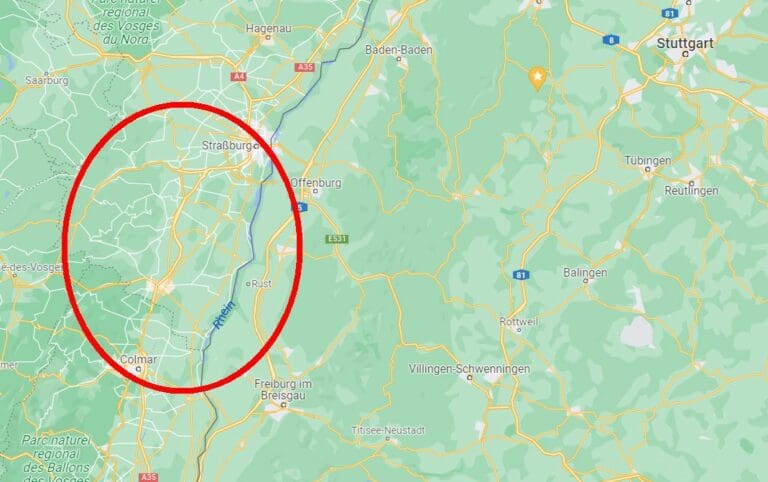
Stay in the loop
2024 Tours Update
Sign up for our email list and receive all details on our new tours.

- +49 (170) 444 7872
- [email protected]
- Chat with us: +491704447872
Testimonials
- Booking Request
- Credit Card Payment
- Hiking Tours
- Freiburg Tours
- Food & Wine
- Just-a-Driver
- Concierge Travel
- Travel Agents
- Corporate Events

WhatsApp us
- Skip to content
Little Holidays
Helping you plan amazing holidays
Driving in Alsace – a road trip in the gorgeous French wine region
Europe , France , Travel Guides / June 12, 2020 by littleholidays / 13 Comments
When it comes to relaxing holidays, there’s no town like a wine town.
One: you have the perfect weather that helps create the perfect grapes. Two: these grapes produce amazing wine that inspires delicious food. And three: this makes everyone giddy happy and friendly!
But too much of a good thing can be oh-so-wonderful, so we add one more ingredient to this perfect holiday recipe: the open road. And that’s exactly how we spent our holiday in Alsace, France’s northeastern wine-growing region: a road trip through beautiful towns, lush vineyards, and breathtaking mountain roads, all while filling up on good food, great wine, and amazing sights.

Little Holidays Guide to Alsace, France
How to plan your road trip in alsace.
- Map – essential landmarks
Road trip itinerary – best things to see and do in Alsace
- Planning your trip
Beyond Alsace – where to go next
- Download the PDF guide
- Get a free custom itinerary
Here’s my recommended road trip itinerary for your holiday in Alsace.
I’d recommend having two bases for this trip – sleep on nights 1-2 in Colmar , then nights 3-5 in Strasbourg . If you’re flying into Strasbourg, pick up your rental car at the airport then drive for about an hour to Colmar.
Day 1 – Once you’ve settled in your hotel in Colmar, head out to Eguisheim, the cradle of Alsatian wine and one of the region’s prettiest villages. Walk around the village’s winding cobbled streets, then hike to the Les Trois Chateaux. Afterward, drive to the Lac du Ballon and the Grand Ballon for easy afternoon hikes around the beautiful Vosges national park.
Day 2 – Explore two more medieval towns near Colmar: Kaysersberg and Riquewihr. Walk along Kaysersberg’s canals and hike up to the ruins of the chateau, then continue your hike through the forest to Riquewihr. Visit one of the many wine cellars in the village and make sure to try the local cuisine.
Day 3 – Spend the morning exploring Colmar – walk around the picture-perfect “Little Venice,” peek into several architectural landmarks, and visit the markets to buy wine, chocolates, and cheese. Have lunch at one of the traditional wine stubs serving traditional Alsatian food. On your drive north to Strasbourg, stop by the Haut-Koenigsbourg, a medieval castle on a mountain.
Day 4 – Drive to the towns north of Strasbourg: La Petite-Pierre, Saverne, and Bouxwiller. Hike around the northern Vosges national park from the Petite-Pierre Chateau to see impressive rock formations along easy-to-moderate trails.
Day 5 – Explore the beautiful city of Strasbourg . Walk around the picturesque Petite France district, get the best views from the Barrage Vauban, then make your way to the Krutenau district. Take some time to visit the museums and the Cathedral of Our Lady of Strasbourg. Enjoy the rest of the day at Place Kleber. If you have more time or another day to spend in Strasbourg, visit the gardens or go biking around the city.
Tell us: What are you most excited about your holiday in Alsace?
- Driving through the vineyards and following the wine trail, one enchanting town at a time
- Hiking and biking Alsace’s forests and wine trails
- Enjoying the region’s fine wines and hearty cuisine
- Sightseeing, dining, and shopping in Strasbourg
- Unwinding in Alsace’s picture-perfect fairytale towns
- Sightseeing, dining, and shopping in Strasbourg 36%, 218 votes 218 votes 36% 218 votes - 36% of all votes
- Unwinding in Alsace’s picture-perfect fairytale towns 36%, 217 votes 217 votes 36% 217 votes - 36% of all votes
- Enjoying the region’s fine wines and hearty cuisine 11%, 67 votes 67 votes 11% 67 votes - 11% of all votes
- Driving through the vineyards and following the wine trail, one enchanting town at a time 10%, 58 votes 58 votes 10% 58 votes - 10% of all votes
- Hiking and biking Alsace’s forests and wine trails 8%, 46 votes 46 votes 8% 46 votes - 8% of all votes
Map – essential landmarks in Alsace
Use this Google map to help you plan your road trip in Alsace. I added all the important landmarks, the best places to visit, and the best areas and hotels to stay in.
For your road trip, I recommend using Waze to navigate.
Day 1 – Exploring the south of Colmar
Our holiday in Alsace begins the day before when we arrived in Strasbourg in the afternoon. We picked up our rental car from the Avis office near Gare Centrale and drove straight to our hotel in Colmar. This was about a 1-hour drive mostly through motorways.
On our first “official” day of exploring Alsace, we paid a visit to Eguisheim, the cradle of Alsatian wine. As we were driving to the south of Colmar, we decided to continue further and hike around the southern parts of the Vosges natural park.
Eguisheim – the cradle of Alsatian wine
Eguisheim is about 7 KM south of Colmar, a 15-minute drive through gorgeous vineyards. Most sites within the village are concentrated in the historical center, which you can explore within an hour.

Eguisheim is a medieval village that has been inhabited since the Paleolithic age. It’s believed to have been conquered by the Romans, who developed wine cultivation in the area. It was also Pope Leo IX’s birthplace in the 11 th century, and the chateau at the center of the village is kept as a homage to him.
Eguisheim was our first brush with the storybook Alsatian village architecture. Narrow and winding cobbled streets lined with half-timbered houses and flowers spilling from everywhere have rightfully earned this little town plenty of national and European awards. In 2013, it was voted as the “Favorite French village.”

Take in charming views from the Chateau Saint-Leon, a former castle built in the 13 th century and now a chapel dedicated to Saint Leo. Walk along the Rue de Rempart Sud for the village’s most photogenic spots. Try to find the L’Authentique Pain d’Epices store here to get some pastries.
When we were there (late September), the village was quiet, with only a few fellow tourists walking around. As it was the first village that we explored, my experiences in Eguisheim influenced my impressions of Alsace as a whole – as a gorgeous region filled with friendly people everywhere. It seemed village locals and local tourists took great pride in the village’s charm – most people would greet you with a bright “Bonjour!” and offer to take your picture by the closest flower-decked window or door that you happen to be standing by. The beautiful houses and monuments served as gorgeous backdrops to a pleasant holiday.
Later on, we returned to Eguisheim to buy wine. We got several bottles of Reisling (dry white wine), Muscat (fruity white wine), and Cremant d’Alsace rosé (the region’s sparkling wine) from Leon Beyer and Wolfberger . For brunch, we dropped by the La Galinette , where we had delicious savory and dessert crepes, all paired with wine, of course.
Hike from Eguisheim to Les Trois Chateaux
From the village center, we spotted a cluster of eerie-looking ruins on top of a hill, which we decided to see up close. These were Les Trois Chateaux (or: three castles of Husseren-les-Chateaux; three castles of Eguisheim).
From the village center, we followed the Rue de Trois Chateaux and walked for almost an hour along vineyards. The first 3 kilometers of the hike goes through vineyards up a mild slope. We then passed the quiet village of Husseren-les-Chateaux.
The final kilometer, though, proved to be quite challenging, but still doable for a hobby hiker like me. The slope became steeper until we finally reached Les Trois Chateaux.

After checking out the chateaux and taking pictures of the views from the top of the hill, we made our way back down to Eguisheim following the much gentler red circle trail.
Back at Eguisheim, we collected our car and drove on to the next stop: Lac du Ballon.
Views in Lac du Ballon and Grand Ballon
It’s a bit of a drive to Lac du Ballon (40 KM, 45 minutes) through winding mountain roads, but it’s a great spot to enjoy the autumn colors and the mountain air.

From Lac du Ballon, you can hike to the Grand Ballon via signposted trails – plan for a 90-minute hike one way. However, since we weren’t sure we could go back to our car by the lake before sundown, we opted to drive to the Grand Ballon instead.
The Grand Ballon is the highest mountain of the Vosges, and also the highest point of the Grand Est region at 1424 meters, so expect breathtaking views from the summit. It derives its name from ballon, a French geographical term for a mountain with a rounded summit – and not from the air traffic control radar station on the summit which, well, looks like a grand balloon. You’ll also find the Diables Bleus monument erected as a tribute to the victims of the battalions of mountain infantry who fought in World War I.

For a traditional Alsatian dinner, check out Ferme auberge du Haag just a short drive from the Grand Ballon parking lot.
After leisurely walks around the Grand Ballon, we made our way back to Colmar.
Practical information
- We drove a total of 120 KM from Colmar to Eguisheim, Lac du Ballon, Grand Ballon, and back to Colmar. Note that if you’re driving from Lac du Ballon to Grand Ballon (instead of hiking), you’ll have to go around the long way and drive for more than 20 KM (may take up to 45 minutes).
- The hike from Eguisheim to Les Troix Chateaux and back was about 7 KM, with easy to moderate trails.
- There were parking areas near the Lac du Ballon and the Grand Ballon. In Eguisheim, you can park for free on Parc du Millenaire along Rue des Oiseaux. Otherwise, you can use the pay parking lot near Grand Rue.
- Check the Google map to view our hike and driving routes. Always follow road signs and have a back-up map with you.
Day 2 – Exploring the north of Colmar
On the second day, we explored the stars of the historic Alsace wine route: Kaysersberg and Riquewihr.
Kaysersberg
Kaysersberg is another well-preserved medieval town with more of the Alsatian half-timbered houses, plus several impressive structures like the Church Sainte Croix and the 16 th century stone bridge crossing the Weiss River. In 2017, it was Kaysersberg’s turn to be chosen as the “Favorite French village.”
The ruins of Chateau de Kaysersberg on a hill above the town is a reminder of its strategic importance during wartimes in the past. It’s about a 15-30-minute hike to the Chateau, from where you can continue following the trails to Riquewihr.
Kaysersberg is also the birthplace of Albert Schweitzer, a winner of the Nobel Peace prize who worked to establish a hospital and leper colony in Africa, among many other achievements. You’ll find his encouraging words of wisdom peppering the trails to the chateau.

From the Kaysersberg chateau, we saw signposts of a trail that led to Riquewihr, so instead of going by car, we decided to continue on foot. After about an hour through the forest, we were welcomed by the pretty town of Riquewihr.

Along with Eguisheim and Hunawihr, Riquewihr belongs to the list of the most beautiful villages in France. Of all the towns I visited in Alsace, Riquewihr is obviously the tourist favorite – its main street was filled with tourists either taking pictures of the beautiful town, notably the pinkish, flower-decked Dolder (lookout tower), or spilling out of the cafes and restaurants lining the street.
After a quick circuit of the town, we ducked into a wine cellar owned by Maison Zimmer , where we tasted some wines and got a bottle of the Cremant d’Alsace. We then went for a late lunch of flammkuchen (or tarte flambée) at the Au Vieux Riquewihr.
Afterward, we trekked back to Kaysersberg, then drove back to Colmar.

- Kaysersberg is about 12 KM (40 minutes driving time) from Colmar. We parked on a lot across Le Petit Gourmand, near the public cemetery. You’ll also see several pay parking lots as you enter the town.
- Riquewihr is 6 KM north of Kaysersberg and a one-way hike would take about 90 minutes. If you go by car, you’ll be able to visit other beautiful towns like Hunawihr and Ribeauvillé.
Day 3 – Exploring Colmar
Colmar is the center of the arrondissement of Colmar-Ribeauvillé and is considered the capital of Alsatian wine. It’s a well-preserved medieval town founded in the 9 th century with numerous architectural landmarks and museums.
Like the rest of Alsace, Colmar was passed from France to Germany and back several times during the last centuries. You will see this in the architecture, food, language, and culture.

The town also enjoys a sunny microclimate and is one of the driest cities in France, thanks to the Vosges mountains that shield it from precipitation. This makes for an ideal terroir to grow the world-class Alsatian wines, and of course, a setting for the perfect holiday.
Colmar was mostly spared from the destructions during the French Revolution, so you’ll be able to enjoy the old townscape in Colmar. The centerpiece of the town is la Petite Venise or “Little Venice,” a district filled with flower-decked canals lined by half-timbered houses and specialty shops. You’ll also find lots of great restaurants in this area.
Other architectural landmarks to visit are St. Martin’s Church, which is made with Gothic, Renaissance, and Baroque elements, and well-preserved medieval buildings like the Maison Adolph, Maison Pfister, and Maison des Têtes. If you want to learn more about the history of Colmar, the museum to visit is the Unterlinden Museum .
For chocolates and macarons, stop by the Jacques Bockel chocolaterie . For cheese, particularly the local munster cheese, and sausages, get them from Chez Thierry.
As for gastronomy, Colmar is certainly not lacking in great restaurants. But we did find out on our first night there that even during off-peak seasons, Colmar does lack tables. We went to 5 different restaurants on our first night and were turned away, even though there were only 2 of us. We ended up eating pitiful vending machine food that night. Lesson learned: reserve a table!
One of our favorite meals from our entire holiday in Alsace came from Wistub Brenner , one of the many traditional wine stubs or wine lounges serving hearty regional food in Colmar. Wistub Brenner is one of the more established and popular ones, so make sure to book a table in advance. I loved the bibalaskas, which is a traditional Alsatian dish served with ham, cheese, and potato salad. It’s right by the canal in Little Venice, so our delicious dinner came with a lovely view.
If you’re up for wines and artisanal Alsatian beers, check out the L’epicurien wine bistro. They also serve delicious French food.
If you’re looking for fine dining in Colmar, check out La Maison des Têtes . They serve both French and Alsatian dishes in a classical setting. And of course, it’s right in one of Colmar’s most beautiful buildings!
You can read more in my detailed Colmar travel guide .
Haut-Koenigsbourg
After exploring Colmar, it was time to say goodbye and move on to Strasbourg. Since the drive from Colmar to Strasbourg was quick (1 hour), we decided to visit Haut-Koenigsbourg , a medieval castle-fortress that lies in the mountains between the two cities.
Strategically located on a rocky ridge overlooking a plain, the chateau was used by royal families, robber barons, and invading troops from the Middle Ages until it was abandoned in the 17 th century. Now, it is a popular tourist attraction and classified as a monument historique by the French Ministry of Culture.

There are several trails to various landmarks from the chateau, like the Montagne des Singes (Monkey Mountain) and the Volerie des Aigles (Eagle Park). We mostly spent our time walking around the chateau grounds and the medieval garden.
After a few hours around the chateau, we began our drive to Strasbourg.
- The drive from Colmar to Haut-Koenigsbourg is 30 KM (driving time is about 40 minutes), and from Haut-Koenigsbourg to Strasbourg is 60 KM (90 minutes).
- In Colmar, parking at the Parking Lacarre is free for 3 hours. Most other pay parking areas in the town are for free from 7 PM to 9 AM the next day.
- There are plenty of street parking spaces in Strasbourg, which are also free from 7 PM to 9 AM. If you can ask your hotel to save you a spot, that would be great because parking spaces are tricky to find. Even better, book a hotel that offers private parking spots.
Day 4 – Exploring north of Strasbourg
La petite-pierre.
La Petite-Pierre is a commune 60 KM (60-90-minute drive) northwest of Strasbourg and the gateway to the northern Vosges natural park. Make your way to the Chateau de la Petite-Pierre, where a lot of trails around the natural park take off from.
From the Chateau de la Petite-Pierre, we followed the “Circuit des 3 rochers,” which goes to three impressive rock formations. It’s 10 KM long and took about 3-4 hours along easy to moderate trails. You can see the directions for this hike as well as more hiking trails in La Petite-Pierre here .

If you have more time, the nearby towns of Saverne and Bouxwiller are also nice places to visit. After our hike, we drove back to Strasbourg and returned our car to the Avis office.
Day 5 – Strasbourg
Finally, we arrive in Strasbourg, the capital of the historic region of Alsace and the symbolic capital and formal seat of the European Parliament.
When we arrived in Strasbourg on Day 3, we had to endure the daunting task of navigating a strange, busy city and looking for parking. So it was with a great sense of relief that we returned our car on Day 4 and explored Strasbourg on foot and by buses and trams. I highly recommend letting go of your rental car once in Strasbourg. The city is very walkable, public transportation is efficient and easy to figure out, and you can also choose to go around in bikes.

The most photogenic district in Strasbourg is Petite France (“Little France”), a historic quarter that used to be home for the city’s tanners, millers, and fishermen. You’ll get the best views of the district from the Barrage Vauban, as well as from the many bridges that cross the canals.
From Petite France, make your way to the Krutenau district, where you can visit the Musée alsacien and the Palais Rohan. You can learn more about Alsatian history in these museums, or simply admire the French Baroque architecture.
From there, make your way to the mother of all architectural gems in Strasbourg: the Cathedral of Our Lady of Strasbourg. It’s one of the finest examples of late Gothic architecture and the highest existing structure built in the Middle Ages. Up close, it’s much more impressive with its detailed façade and its pinkish hue, thanks to sandstone from the Vosges mountains.
Afterward, enjoy the rest of the day at Place Kleber. If you have more time or another day to spend in Strasbourg, you can visit the Jardin des Deux Rives (Two Shores Garden) and the Parc de l’Orangerie for maximum downtime. You can read more in my detailed Strasbourg travel guide .
Planning your trip to Alsace
Getting there.
The gateway to Alsace is the region’s capital, Strasbourg. You can get to Strasbourg via several means:
Flying to Strasbourg – Strasbourg has an international airport in Entzheim, just 16 KM from the Strasbourg city center – check for flights to Strasbourg here . From the airport, you can ride a shuttle train into the city. Other nearby international airports are in Stuttgart and Paris.
Traveling by land to Strasbourg – If you’re coming from nearby cities and countries, you can reach Strasbourg by train or bus. If you’re on a multi-country trip, getting a Eurail Global Pass can be more convenient and economical for you. Otherwise, you can check SNCF for train connections to Strasbourg, or RegioJet and Flixbus for bus travel.
Getting around
Renting a car in Alsace – The most convenient place to get a rental car is in Strasbourg. There are two main pick-up points in the city: at the airport and near the Gare Centrale (Strasbourg’s central train station). You can choose and reserve a car from the major car rental companies in Strasbourg here.
We got our car from Avis via the RentalCars booking website . I like booking with them because generally, the rental fees are cheaper (since they’re able to negotiate a better price with major rental car companies). It’s also good to book a car online in advance to avoid having to wait for a long time, or worse, running out of cars. Avis’ downtown pick-up office is near the Gare Centrale – once you exit the station, turn right and walk to the end of the station. The Avis office, along with Sixt and Budget, is across the flags and beside Burger King.
If you have a driving license from the European Union, you can use this to drive in France. You’ll have to present your license, identification card, and credit card when you pick up your car.
If your license is from outside the European Union, you will need an international driving permit (IDP) and your local driver’s license. You have to get your IDP from the same country that issued your driver’s license (look up your country’s automobile association + international driving permit to find out how to obtain one), so do this before leaving for your holiday. When picking up the rental car, make sure to have your IDP, local license, passport, and credit card.
Note that Europe mainly drives manual transmission cars, so if you require an automatic transmission car, make sure to reserve one well in advance (about three months) as these cars are limited.
Here’s a comprehensive guide to driving in France .
Where to stay in Alsace – best hotels in Colmar and Strasbourg
For this road trip itinerary, I’d recommend splitting your time between Colmar and Strasbourg.
Stay in Colmar for at least 2-3 days to explore the southern parts of Alsace. James Boutique Hotel is a great option within walking distance of the historic center, perfect for exploring the city and quickly getting out to the countryside. For families and big groups, Suites Residences Spa has spacious and fully-equipped apartments. For a no-frills option a short drive from the city center, check out B&B Hotel Colmar Expo .
Stay in Strasbourg for at least 3 days to explore the city and the northern parts of Alsace. Hotel and Spa Le Bouclier d’Or is a gorgeous hotel right in the middle of Petite France, Strasbourg’s most picturesque district. For families and bigger groups, Le Moon at Place Kleber and La Residence de l’Orangerie in the quiet and residential European Quarter are great options.
Top tips for travel to Alsace
Languages spoken: French, German, English
Money: Euro (1 EUR ~ 1.10 USD) – You can pay at most shops, train stations, and hotels using a credit or debit card, but make sure to have cash with you. Some restaurants and shops will only take cash.
If you have a borderless card like TransferWise or Revolut , you can withdraw from the French banks’ ATMs for free. Convert your currency to EUR on your app first, then withdraw easily and hassle-free.
Typical costs:
- Accommodations – A stay for two in a luxurious hotel in the historic center (like Cour de Corbeau ) can cost from EUR 240/night. A charming boutique hotel in a central location (like BOMA ) costs around EUR 120/night. You can also find budget apartment rentals (like Studio Proche Gare Et Petite France ) and stay for only EUR 70/night.
- Food – You can spend EUR 40 upwards for a nice dinner for two.
- Transportation – A rental car for 5 days (+ gas and tolls) can cost from EUR 300. You can check rental car prices for your travel dates. Make sure to get comprehensive rental car insurance .
Tipping: A service charge is usually added to the final bill and tipping is not expected, but a 10-15% tip for excellent service is appreciated.
Weather and best times to go: Alsace is gorgeous during the summer months (July, August) with flowers in full bloom and the perfect weather for walking and biking around. Autumn (October, November) is also a lovely time to visit – you can enjoy the beautiful fall colors, milder weather, and wine festivals and tastings throughout the countryside. During the Christmas season (December), Strasbourg dresses up as the “Capitale de Noël” with festive Christmas markets spread throughout the city and in the smaller towns.
Staying connected: You can get a pocket Wi-Fi device delivered to your hotel in France or anywhere in the EU.
Read more about Alsace
- Alsatian wines strike a balance of dry and sweet by Eric Asimov
An excellent overview of the qualities of Alsatian wine and why more people should know about it.
- Alsace wine tour: In search of the world’s greatest white wines by Nick Trend
A wine-centric tour of the region, this article offers suggestions on where to best pick up your wine and have a deeper understanding of the region’s produce.
If Alsace’s scenic roads and gorgeous landscapes got you excited for your next holidays in Europe, here are more amazing road trip destinations for you.
- Salzkammergut, Austria
Explore two of Austria’s beautiful cities – Salzburg and Vienna – by road tripping across the beautiful Salzkammergut region or Lake District. This is a great road trip itinerary if you love charming villages, gorgeous natural landscapes, and outdoor activities.
With breathtaking and diverse natural landscapes and smooth and efficient roads that bring you from the Alps to the countryside and the coasts in a few short hours, Slovenia is the perfect destination for a road trip.
- South Moravia, Czech Republic
Here’s another destination for lovers of nature, history, and gastronomy – the Czech Republic’s South Moravian wine region. You’ll find plenty of castle towns, forests, and vineyards to explore.
- Jungfrau, Switzerland
While parts of the Swiss Jungfrau region can be touristy, head to the quieter areas of Lauterbrunnen and Mürren to enjoy that traditional Swiss countryside ambiance. You’ll find plenty of hiking trails, stunning alpine views, and warm and welcoming chalets.
- More road trips in France
Here are more amazing road trips to take in France!
I hope this guide helps you plan your road trip to Alsace! I really enjoyed our holiday, and I highly recommend it to anyone who’s into wine regions, natural landscapes, and pretty storybook towns. You’ll also be treated to amazing gastronomy and friendly folks everywhere.
If you need more recommendations or extra help planning your trip, send me a message, and I’ll be happy to help you out. Thanks for reading and happy travels to France!
First published – 3 November 2017
Last updated – 12 June 2020 – updated information, fixed format for, added tips and information for easier travel-planning
Reader Interactions
March 19, 2018 at 1:20 am
hi i am Nisha from India. we are planning a road trip from Chamonix to Alsace through Swiss, what will be the requirements to pass through Swiss?
March 24, 2018 at 5:53 pm
Hi Nisha, you’ll have to ask the Swiss embassy in your country for that information. Good luck!
May 31, 2018 at 2:20 pm
What do you mean by the requirement to pass through by swiss?
July 19, 2018 at 12:02 pm
Such a helpful article! Thanks! We’ll be traveling with a toddler in sept; do you think it’s hard to get a table in Colmar for dinner if you go early? Also, when do most restaurants open? Thank you! ~ the FUNemployed family
July 19, 2018 at 4:36 pm
Hi Ben, I would recommend to still reserve a table even if you’re going for dinner early, but you can try! I think restaurants start serving dinner at around 6 or 7 pm. Have fun! 🙂
August 19, 2018 at 8:29 am
Great post, full of usefull information.
August 26, 2018 at 8:39 am
Thanks for reading, Jelena!
November 7, 2018 at 11:26 am
Hi, we are going to Strasbourg in January, and we are planning to make the Alsace wine route in a day with our rented car. Do you think we can make it in a day to end up in Colmar and go back to Strasbourg on the same day? Thanks Charlene
November 7, 2018 at 11:39 am
Hi Charlene, yes you can! It’s about an hour’s drive from Strasbourg to Colmar, then up to half an hour from Colmar to Eguisheim, Kaysersberg, and Riquewihr. It’s going to be a full day but it’s doable. You might have to forego the hikes though. Hope that helps!
July 1, 2019 at 7:37 pm
Where is that road at the start of the post? It looks amazing!
July 2, 2019 at 8:18 am
Thanks, Louise! I took that from the Grand Ballon! 🙂
June 8, 2022 at 9:59 am
Thanks for this post. We have – more or less – just made this trip. Started in “Colmar” (2 nights at Hotel “James Boutique”), visited “Eugisheim”, walked from “Kayserberg” through the vines to “Reichenweiler”, visited “Haut-Koenigsbourg” on the way to Strasbourg. Arrived in “Strasbourg” (2 nights at Hotel “Le Bouclier d’Or”) we did not visit any other places but explored the great city in beautiful weather. It was fantastic… thank you.
November 17, 2022 at 4:04 pm
Lovely to hear that, Sven! Your trip sounds fantastic. 🙂
Leave a Reply Cancel reply
Your email address will not be published. Required fields are marked *
Notify me of follow-up comments by email.
Notify me of new posts by email.
This site uses Akismet to reduce spam. Learn how your comment data is processed .

Guided tours and excursions
Stay in the city, in the countryside or somewhere unusual: discover our carefully crafted getaways. Relax and leave it all to us. We’ll plan your programme so you can get on with discovering the best of Alsace.
- 0 Result(s)
- Region of the 3 countries criteres.1900461.modalites.1903514.exist:1
- Share on Facebook
- Share on Twitter
- Share on Linkedin
- Share on Mail
- Colmar criteres.1900461.modalites.1908580.exist:1
- Strasbourg criteres.1900461.modalites.1908579.exist:1
- Mulhouse commune:"Mulhouse"
- Alsace Wine Route criteres.1900461.modalites.1908571.exist:1
- Northern Vosges and Alsace Bossue criteres.1900461.modalites.1911164.exist:1 criteres.1900461.modalites.1911624.exist:1 criteres.1900461.modalites.1903501.exist:1 criteres.1900461.modalites.1903510.exist:1
- Northern Alsace criteres.1900461.modalites.1908581.exist:1
- Alsace Plain criteres.1900461.modalites.1908582.exist:1
- Southern Alsace criteres.1900461.modalites.1903617.exist:1

IMAGES
COMMENTS
Discover the stunning Alsatian wine region on this unforgettable Wine Tasting Day Trip from Strasbourg. You'll travel along the 170-kilometer (106-mile) Alsace Wine Route, passing vineyards, villages, and castles. Your first stop is Mittelbergheim, which is one of my favorite towns in the region.
Self-Guided Tours in Alsace. On the border with Germany lies the Alsace region, along the Rhine river and stretching from Strasbourg to Colmar. Our Alsace tours has everything a wanderer will like: so many colorful half-timbered towns built along a scenic vineyards route. Always in the background, the Vosges mountains add to the picturesque ...
Medieval Alsace Tour. Explore the stunning region of Alsace on our one-day excursion. Immerse yourself in the charm and history of this area. Discover enchanting villages, savor the fine wines of the region, and explore a majestic medieval castle. An unforgettable experience in Alsace. Book your tour Leaflet
Day 6 - Haut-Kœnigsbourg, Saint-Hippolyte and Bergheim. Day 7 - Ribeauvillé, Hunawihr and Riquewihr. Day 8 - Colmar and Eguisheim. Day 9 - Turckheim and Kaysersberg. Day 10 - The Route des Crêtes from Kaysersberg to Thann. Day 11 - Sundgau, Jura alsacien and Mulhouse. Day 12 - Ecomusée d'Alsace and Neuf-Brisach. 4.
Alsace & Lorraine Tours & Trips. Find adventures through Alsace and Lorraine. Ride past gorgeous vineyards on your bike to discover picturesque villages, marvel at Renaissance house facades and stunning views over the Rhine River. Taste authentic French wine and cheese in the mountains then visit historic sites in Strasbourg, Colmar, Largarde ...
The slowUp Alsace has become a not-to-be-missed event on the Wine Route. The concept is simple: slow down for greater pleasure. The road is exceptionally closed to motorised traffic for one day. Everyone sets off at their own pace, on bikes, rollerblades or on foot, to take full advantage of the scenery and events along the way. ...
Whatever you're looking for, however long you want to stay, Alsace is the perfect place for a getaway! Take your inspiration from a treasure trove of itineraries featuring sites from the most iconic to the most unusual, and plan your ideal trip! Homepage. Itineraries ©Max Coquard - Best Jobers. Reach great heights on the Peak Route.
25. SHARES. Take a journey to the storybook setting of the Alsace wine region with our carefully curated selection of private and customizable wine tours. Get to know the wines and producers in this acclaimed destination and visit quaint towns and villages and bucolic countryside vineyard landscapes. Alsace is a noteworthy wine region located ...
Located on the German border, the Alsace region is famed for its scenic vineyards and medieval villages. On this tour from Colmar, benefit from a small group size as you follow the Alsatian Wine Route, stopping to sample Alsace wines at a local wine cave (own expense), and visit the "Four Wonders of the Alsace"—the picturesque villages of Eguisheim, Kaysersberg, Ribeauvillé, and Riquewihr.
Discover the scenic wonders of Alsace on a private tour from Strasbourg. Explore the charming towns of Colmar, Eguisheim, and Riquewihr with a professional guide. Become a supplier
The essence of Alsace, in 4 days. Urban escapades and excursions deep into the beauty of nature are part of the plan in this 4-day tour of Alsace. So much to see and do: Strasbourg, Colmar and Mulhouse, the ideal city break destinations, combined with outings in the wine country and Alsatian hillsides. (18)
After the Franco-Prussian War in 1870, 90 percent of the broader region known as Alsace-Lorraine was annexed into the German Empire in 1871, then ceded to France during the Treaty of Versailles at the close of World War I in 1919. It gained a measure of independence and self-governance between the world wars, only to be occupied by German ...
Here's the Ultimate Alsace Road Trip. The historic region of Alsace, today part of the region of Grand Est in Eastern France, is a land rich in natural wonders, picturesque small towns, and good wines.The Alsatians are amicable and welcoming people, the Alsace Christmas Markets are the best in France, and the Alsace food is excellent too!. The best way to explore the region of Alsace is by car.
Discover its buildings, heroes, legends and secrets…. 24. Private Tour: Picturesque Alsatian Villages & Wine Tasting with a local expert. From Strasbourg, you will discover the famous charm of Alsatian villages and visit the 3 villages of Eguisheim, Kaysersberg….
The Alsace region is located in north-eastern France and is famous for its wine, its colourful half-timbered houses and its castles which sit enthroned on the summits of the Vosges mountains. Since the 1st January 2016 the administrative region of Alsace has been part of the new Grand Est region along with Lorraine and Champagne-Ardenne.
Alsace. France, Europe. Ask the French what they think of Alsace and watch them grow misty-eyed with nostalgia and affection for this most idiosyncratic of regions, which borders Switzerland to the south and Germany to the east. So hard to nail in terms of its character, it proudly guards its own distinct identity, language, cuisine, history ...
Walking the Alsace Wine Route. Walk from the village of Thannenkirch to Eguisheim, one of the 'Plus Beaux Villages de France'. From $1,645.00. Activity. Level. Accommodations. Level. More Info. Type Slower Adventures.
Guided tour during Winter. Neuf-Brisach. From 01 Apr to 31 Dec 2024 Other dates. Guided tour of the town and of the ramparts of Neuf-Brisach, in french. Neuf-Brisach. From 29 Jun to 01 Sep 2024. Flat-bottomed boat trip on the Giessen river. Biesheim. From 21 to 22 Sep 2024 Other dates.
Follow us on Instagram. @visitribeauvilleriquewihr. + 33 (0)3 89 73 23 23. [email protected]. Ribeauvillé reception office. Riquewihr reception office.
More 4K walking tours near Eguisheim in France:Colmar: https://youtu.be/mTn3RPDSFxUKaysersberg: https://youtu.be/xI_v2Bg19SkRibeauville: https://youtu.be/iiu...
Black Forest & Alsace. spring, summer, fall. 3 days. Our Black Forest & Alsace Package is one of the richest cultural experiences you are going to find in one package. Its like salt & pepper. The contrasts between culture, food, wine and history between The Black Forest on the east side of the Rhine Valley and the Alsace region on the west side ...
A wine-centric tour of the region, this article offers suggestions on where to best pick up your wine and have a deeper understanding of the region's produce. Beyond Alsace - where to go next. If Alsace's scenic roads and gorgeous landscapes got you excited for your next holidays in Europe, here are more amazing road trip destinations for ...
Guided tours and excursions. Stay in the city, in the countryside or somewhere unusual: discover our carefully crafted getaways. Relax and leave it all to us. We'll plan your programme so you can get on with discovering the best of Alsace. Homepage Guided tours and excursions Region of the 3 countries. Filter.